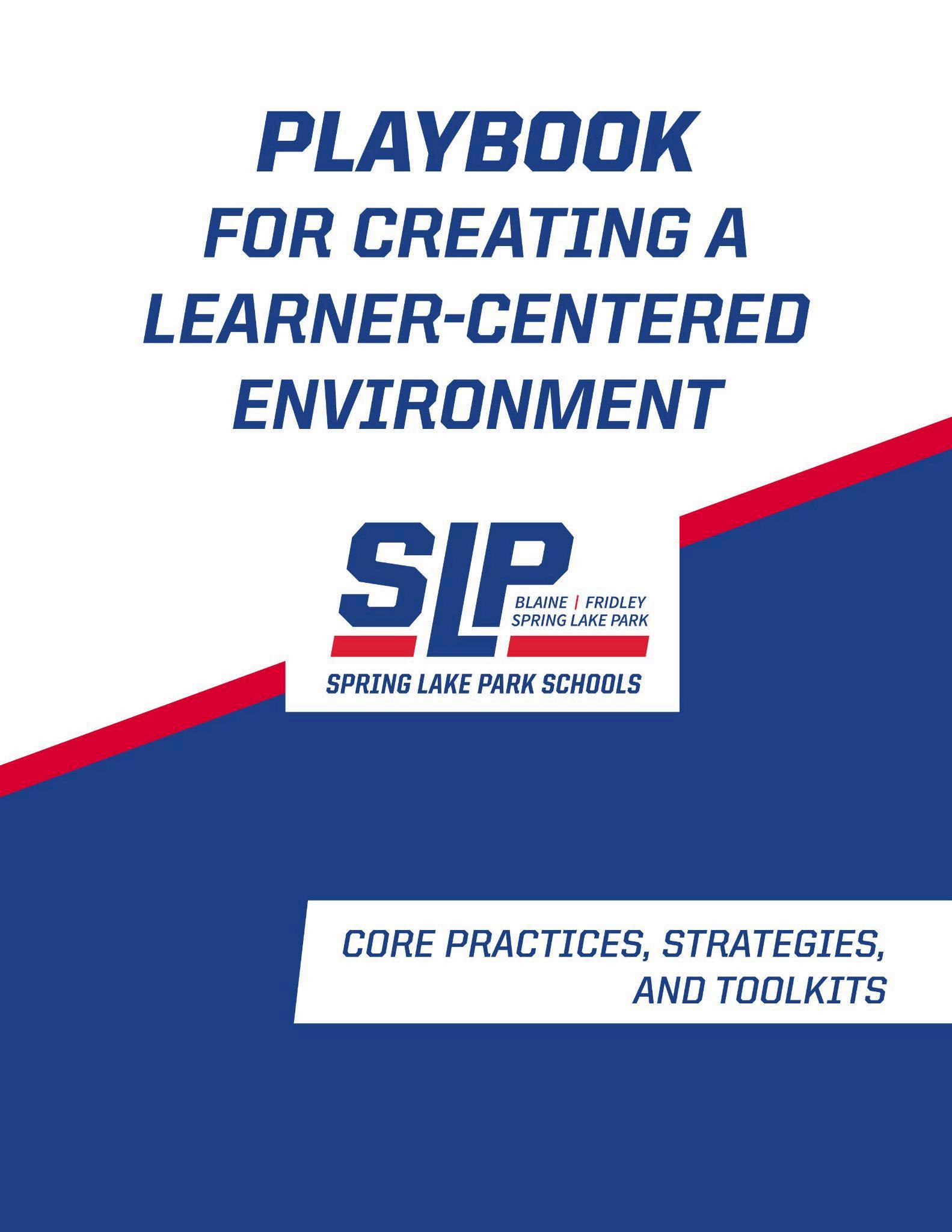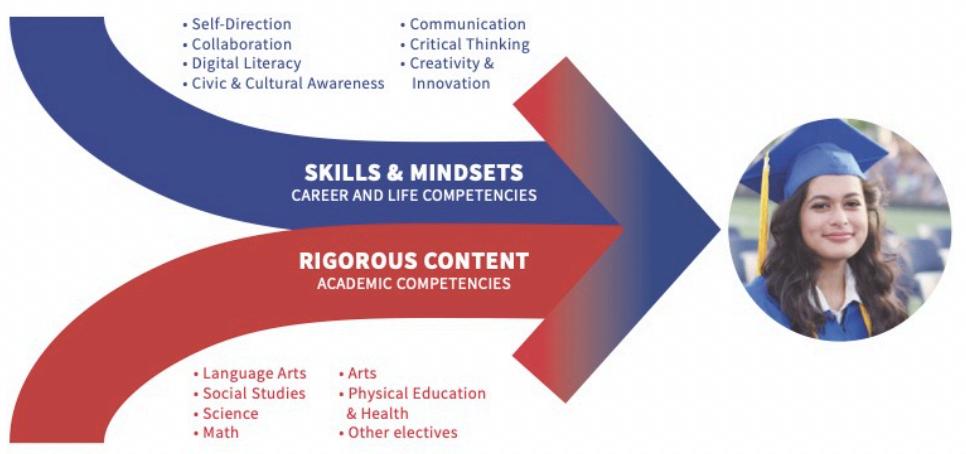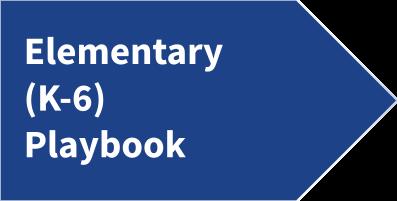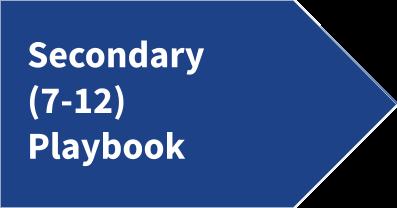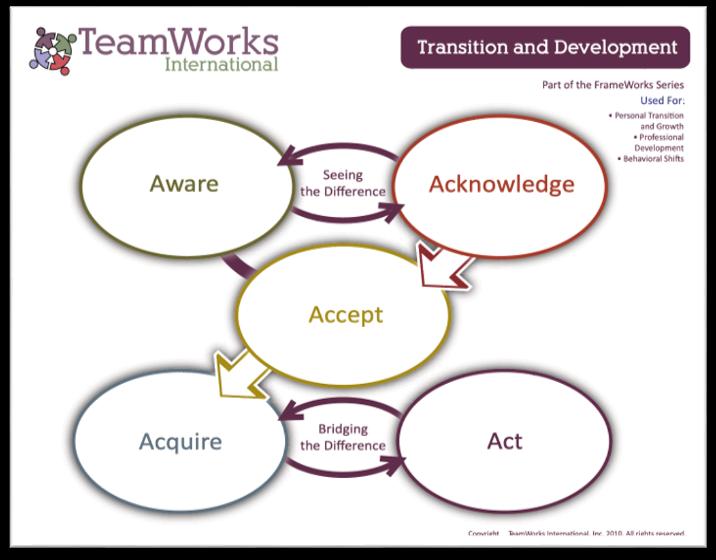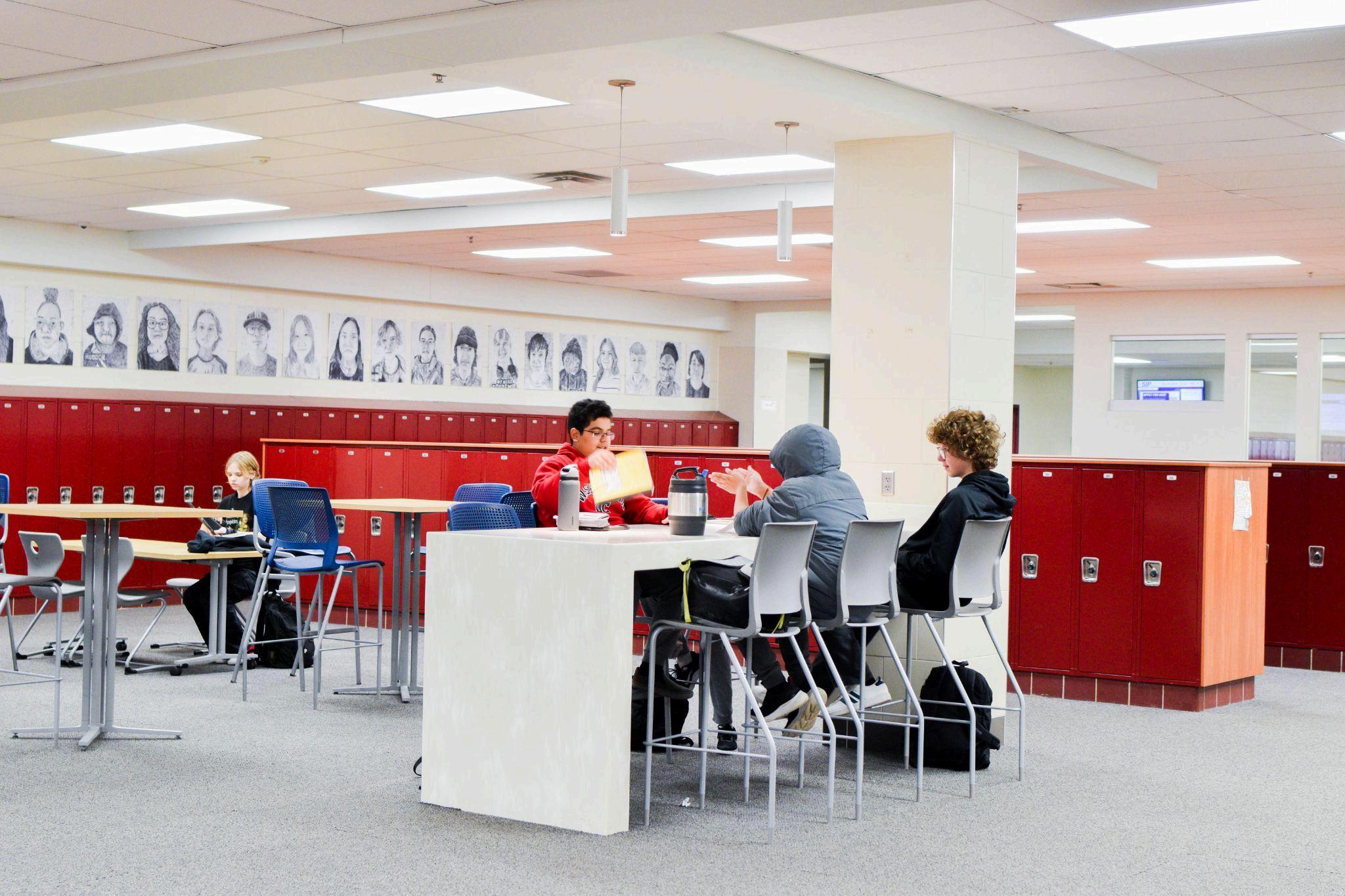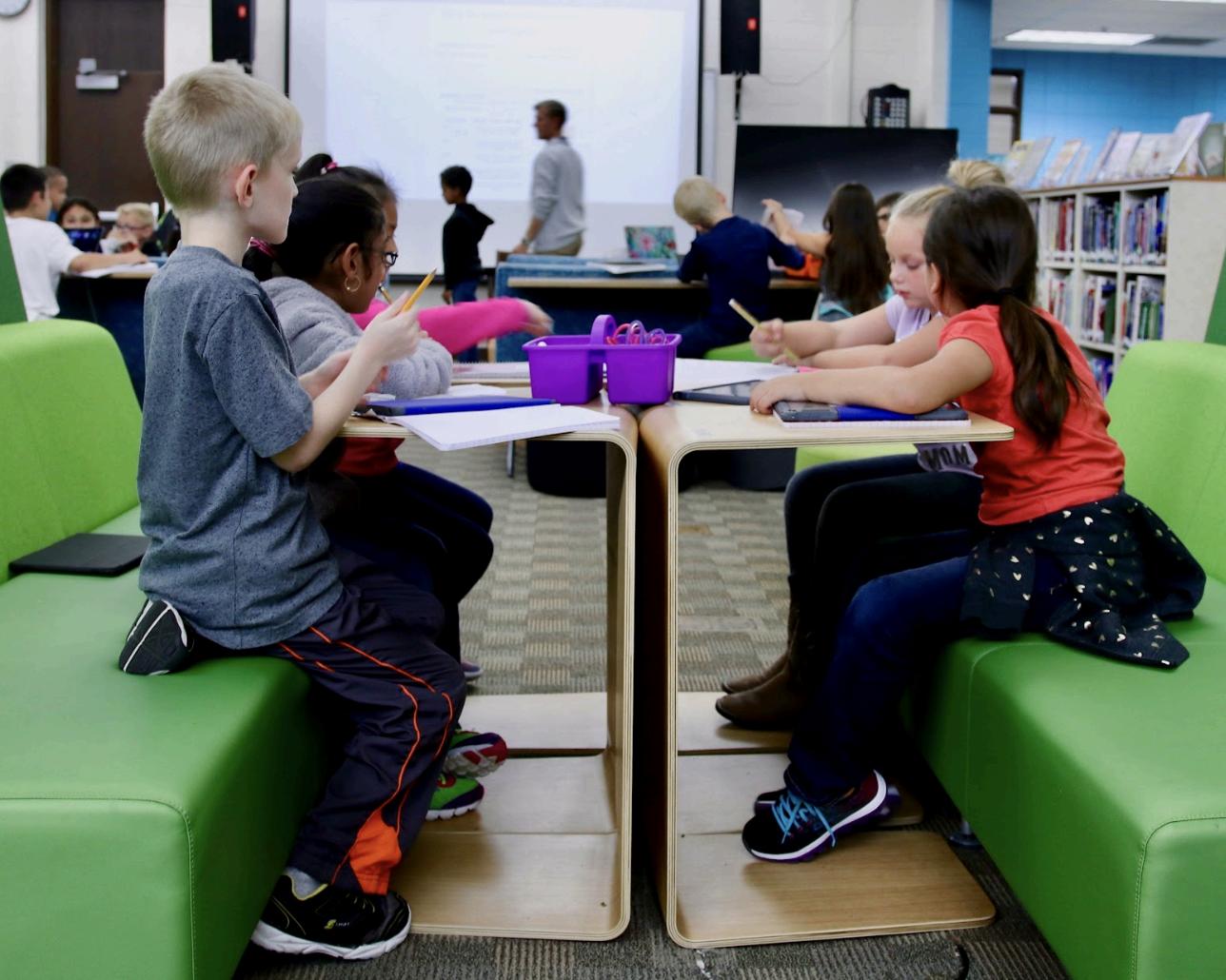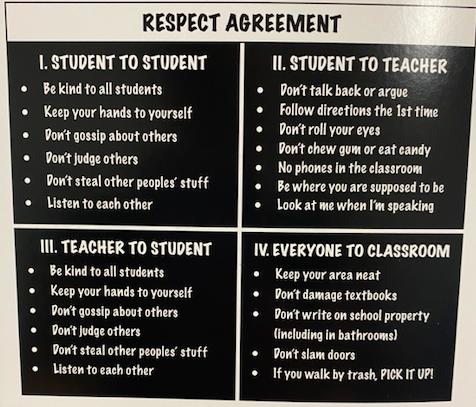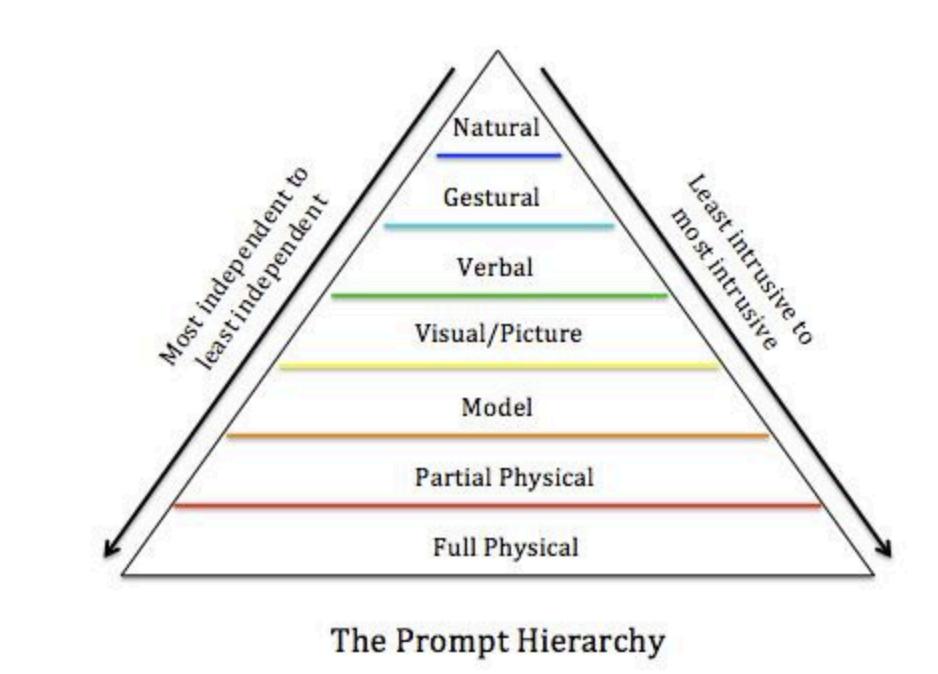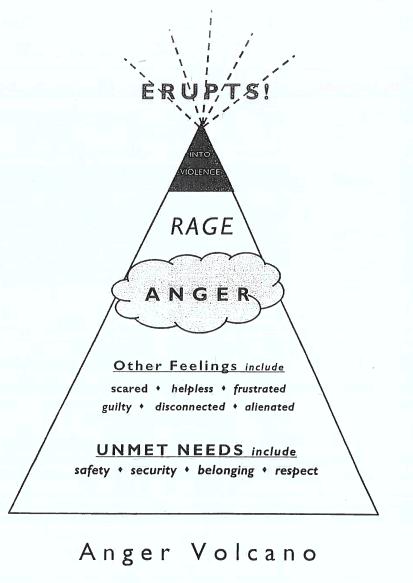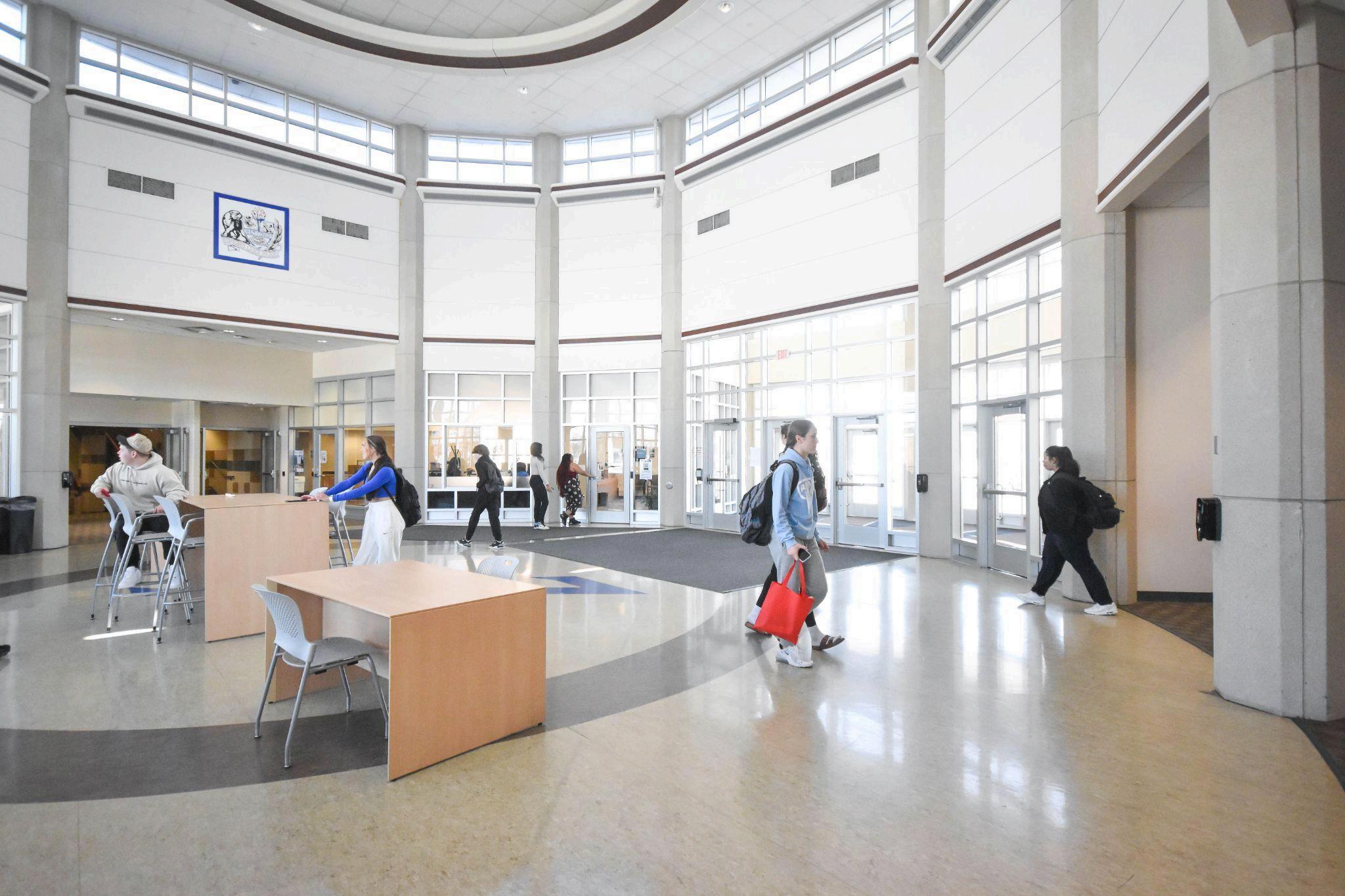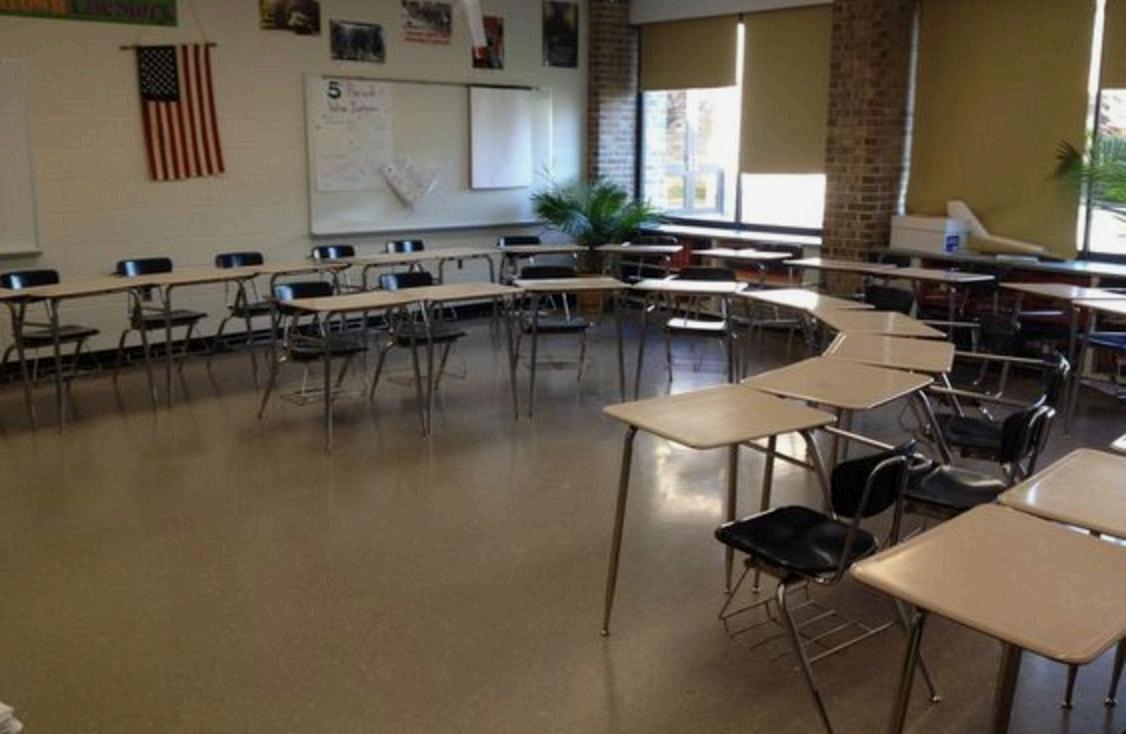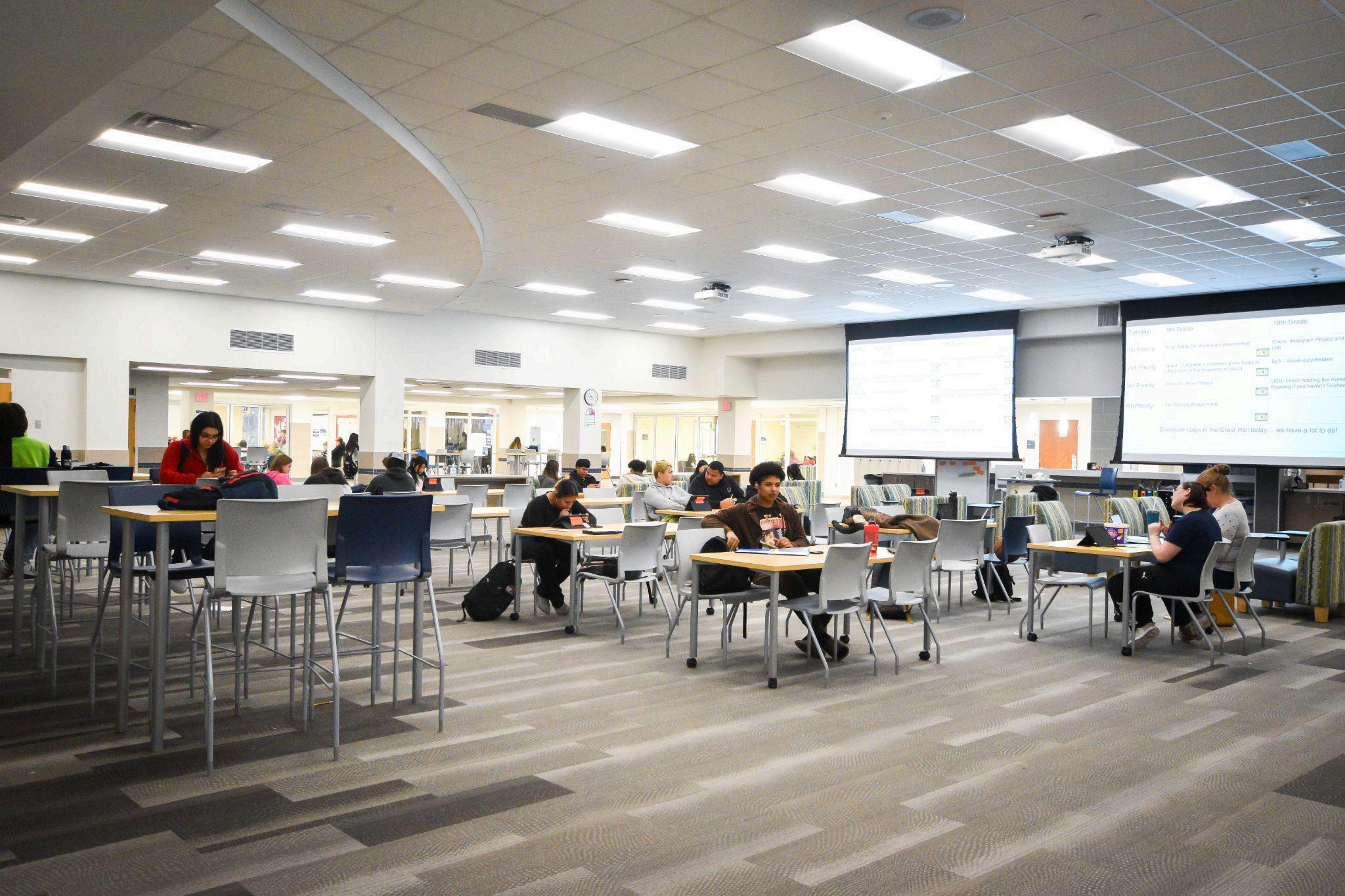Jumptoyoursection: Elementary(K-6)Playbook forCreatinga Resources:Designinga Learner-CenteredEnvironment KnowYourselfasaLearner Learnaboutyour“Who” SettinguptheLearningEnvironment Howwedoit PlantoCo-createNormswithStudents RespectAgreements (BuildingCommunityNorms) DetermineRoutines InteractiveModeling Howwedoit GuidedDiscovery Howwedoit CulturallyResponsivePedagogy Windows&Mirrors CultivatingaLearner-centered Environment KnowingandUsingStudentNames BuildingaPartnershipwithFamilies MorningMeeting EmpoweringLanguage 2x10 VoiceScales IceBreakers HopesandDreams LearnerProfiles Howwedoit OpportunitiesforChoice EmpathyMaps ProvidingFeedback BehaviorSpecificPraise Redirection-LevelsofPrompting LimitSetting ClosingCircle The3Pʼs CreatingaCollaborativeClassroom TriageattheDoor RestorativeMindset BreakIt,FixIt I-Messages AngerVolcano OurClassisaFamily ManagingaLearner-centered Environment Proximity SocialConferencing PlanB (CollaborativeandProactiveSolutions) BehaviorContracts SupportiveBodyLanguage RebuildingRelationshipsBetween Individuals De-escalation:5Things(Mindfulness) De-escalation:ConnectandRedirect Prevention,De-escalation,Restoration, StaffDecisionPointandResponse Behaviorsthataredisruptivetoself, butnon-dangerous (CBasket) Behaviorsthataredisruptive, butnon-dangerous (BBasket) BehaviorsthatarePhysicallyor EmotionallyUnsafe (ABasket) ReinforcingaLearner-Centered EnvironmentthroughDesignofLearning Experiences Secondary(7-12)Playbook forCreatinga Resources:Designinga Learner-centeredEnvironment KnowYourselfasaLearner Learn about your “Who” Learning Environment is Designed for the Learners to Engage with the Lesson/Learning Plan to Co-create Norms with Students RespectAgreements Determine Routines Interactive Modeling Howwedoit Guided Discovery Howwedoit Is/Is Not or Examples/Non-Examples CulturallyResponsivePedagogy Windows&Mirrors ReadytoInstructSpace CultivatingaLearner-Centered Environment Knowing and Using Student Names Building a Partnership with Families EmpoweringLanguage VoiceScales Ice Breakers LearnerProfiles Howwedoit EmpathyMaps OpportunitiesforChoice Providing Feedback Behavior Specific Praise LimitSetting Redirection-LevelsofPrompting IndividualCheck-In CommunityBuildingCircles The3Pʼs CreatingaCollaborativeClassroom TriageattheDoor RestorativeMindset BreakIt,FixIt I-Messages AngerVolcano OurClassisaFamily ManagingaLearner-Centered Environment Proximity SocialConferencing PlanB(CollaborativeandProactive Solutions) BehaviorContracts SupportiveBodyLanguage RebuildingRelationshipsBetween Individuals De-escalation:5Things(Mindfulness) De-escalation:ConnectandRedirect Prevention,De-escalation,Restoration, StaffDecisionPointandResponse Behaviorsthataredisruptivetoself, butnon-dangerous(CBasket) Behaviorsthataredisruptive,but non-dangerous(BBasket) Behaviors that are Physically or Emotionally Unsafe (A Basket) Reinforcingalearner-centered environmentthroughdesignoflearning experiences WhatisthePlaybookforCreatingaLearner-CenteredEnvironment?
ThePlaybookforCreatingaLearner-CenteredEnvironmentisourcoreresourceforstaffthatprovides expectations,strategies,andtoolkitsforimplementingourcoresocial,emotional,andbehavioral developmentandmanagementpractices,whichinclude:designingalearner-centeredenvironment, cultivatingalearner-centeredenvironment,managingalearner-centeredenvironment,andreinforcinga learner-centeredenvironmentthroughthedesignoflearningexperiences.Withineachcorepractice, teacherswillpurposefullychoose,andimplement,strategiesthatwillbuildthesocial,emotional,and behavioralskillsofstudentsthatresultinasafeandlearner-centeredenvironment.Allfourcorepracticesare necessaryandrequiredwithourapproachtosocial,emotional,andbehavioralgrowthanddevelopment. Thestrategiesandtoolsthatteacherspurposefullyselectandimplementarepersonalizedtoleveragethe strengthsandmeettheneedsoflearners
DesigningaLearner-CenteredEnvironment
● Knowyourselfasalearner
● Knowyourlearners(name,strength,interest,needs)
● Learningenvironmentisdesignedforthelearnerstoengagewiththelessons/learning
● Determinewhatroutinesneedtobeestablished,includingthoseroutinesthatmayneedtobe co-createdwithstudents
● Determinehowtoco-createnormswithstudents
CultivatingaLearner-CenteredEnvironment
● Gettoknowyourstudentsandletyourstudentsgettoknowyou
● DailyMorningMeeting(K-6)
● Co-createnorms
● Establishattentionsignals
● Cultivaterelationships
● Buildcommunity
ManagingaLearner-CenteredEnvironment
● UnderstanddecisionpointsforC,BandAbasketbehaviors
● ImplementstrategiestoredirectCandBbasketbehaviors
● KnowtheprocessforcallingforsupportforAbasketbehaviors
● KnowwhentoandhowtomakeaPitCrewreferral
Reinforcingalearner-centeredenvironmentthroughdesignoflearningexperiences
● Inadditiontodesigning,cultivating,andmanagingalearner-centeredenvironment,teachers intentionallyusebackwarddesignofunitsandlessonstoreinforcetheskillsneededforstudentsto demonstrateCareerandLifecompetencies
○ EmbedspecificengagementtoolsthatalignwithCareerandLifeCompetenciesinthe backwarddesignoflearning
○ Embedhighleverageengagementstrategiesinthebackwarddesignoflearning
WhyisaPlaybookwithcorepractices,strategies,andtoolkitsimportant?
Themostimportantsinglevariableintheprogressofstudentsishighqualitycoreinstructionandpractices, builtaroundhighexpectationsandconsistentapplicationofstrategiesandtoolsthatalloweachstudentto besuccessful.Wecannotinterveneourwayoutofpoorimplementationofcorepractices.Commoncore practiceshavebeenestablishedtoprovideguidanceandlimitthevariabilityofthestudentexperiencefrom onelearningenvironmenttoanother.Whenwecollectivelybringthesecorepracticestolife,studentswill developtheskillsanddispositionsthatleadtoasafe,learner-centeredenvironment.
HowdoesourPlaybookforaLearner-CenteredEnvironmentcometolife?
Ourbeliefsaroundsocial,emotional,behavioralgrowthanddevelopmentcometolifethroughourcore practicesandinteractionswithstudents.Whileeachlearningspacewillencompasseachofourcore practicesarounddesigning,cultivating,managing,andreinforcingalearner-centeredenvironment,thetools andstrategiesweusecanbepersonalizedtotheuniqueneedsofthelearnersinthatenvironmentbasedon knowledgeofourstudents,bestpractices,andformativedata.
OurBeliefsaboutSocial,Emotional,BehavioralGrowthandDevelopment IntheSpringLakeParklearningcommunity,ourvisionisthateachstudentandstaffmemberfeelsvalued, inspired,andhasasenseofbelonging Wedeveloptheskillsanddispositionstobecomeengaged, enthusiasticlearnersbyimplementingculturallyresponsivecorepracticesthatalignwithpersonalized learning.
Webelieve:
● Allstudentsandstaffdesiretohavepositiveandpersonalrelationships.
● Eachstudenthasadesiretolearn,andtheirengagementisdirectlyinfluencedthroughthedesignof studentworkandlearningexperiencesandtheirrelationshipswithinthelearningenvironment.
● Eachstudentbringsvaluetoourlearningcommunity;werecognizethateachstudentbringsunique assets,experiences,andvoicetotheschoolandclassroomenvironment.
● Werecognizethatfamiliesareessentialpartnersinourshareddesireforeachstudenttobecome positive,caringcontributorstoourschoolsandcommunity.
● Itisourcollectiveandindividualresponsibilitytoprovideclear,consistent,andcaringexpectations, andtoteachtheskillsneededforeachstudenttofindsuccessthatleadstopredictableandsafe learningenvironmentsforbothstudentsandstaff
● Challengingorunexpectedbehaviorwilloccur,andisaformofcommunication.
● Behavioriscultural,andweunderstandthatinordertoguidelearnersindevelopingsocial, emotional,andbehavioralskills,wemustpursueourowndevelopmentintheseareas,which includesexpandingourunderstandingbasedonthecultureswithinourcommunity.
● Classroomandschoolcultureisadynamicprocessthatiscreatedbystaffandstudentscollectively.
● Weindividuallyandcollectivelyinfluencethebehaviorandcultureofaclassroomandschool throughourresponses,andpatternofresponses,tochallengingorunexpectedbehavior.Partnership amongstaffisnecessarytosupportstudentsandoneanother.
StudentExpectations Asetofcommonstudentexpectationshasbeenestablishedtolimitthequantityandvariabilityof expectationsfromonelearningenvironmenttoanother.Theseexpectationswillbecommunicated, modeled,andpracticedwithlearnersthroughoutthedistrict.
● Studentswillengageinwordsandactionsthatresultinasafephysicalandemotional environment.
● Studentswillpromoteapositiveschoolcultureandasenseofbelongingforeachstudent throughtheirwordsandactions
● Eachstudentwillbeastewardoftheirschoolenvironment,creatingaplacetheyareproudto calltheirschool.
● Studentswillbeawareof,andadvocatefor,theirsocial-emotionalandlearningwantsand needs.
● Studentswilladjusttheirbehaviortomatchthelearningactivityandenvironmentandbe opentofeedbackwhentheyhavedifficulty.
HowweDefineSocial,Emotional,BehavioralGrowthandDevelopment Whileitisimportanttoclearlydefineeachareaofdevelopment–social,emotionalandbehavioral –weknowtheseskillscannotbeaddressedinisolationandmustbeapproachedwithanintegrated approach.
Social Socialskillsaretheskillsweusetointeractwithothersaroundus.Socialdevelopmentisthe processbywhichwelearnhowtousetheseskillstointeractwithotherseffectively.
Emotional Emotionalskillsaretheskillsweusetounderstandwhatfeelingsandemotionsare,andhowand whytheyoccur.Emotionaldevelopmentistheprocessbywhichwelearnhowtorecognizeourown feelingsandthoseofothersaroundus,andhowtosafelyexperience,process,andrespondtoour ownfeelingsandemotions.
Behavioral Behavioralskillsaretheskillsweusetorespondtodifferentstimuliorsituationsinour environment.Behavioralskillsareinfluencedbyoursocialandemotionaldevelopment,ourlife experiences,andthenormsofourcultures.Behavioraldevelopmentistheprocessbywhichwe learnhowtosuccessfullynavigateexpectationsofbehaviorandmanageourresponsetothose expectations.
Social,emotional,andbehavioralgrowthanddevelopmentistheprocessthroughwhich individualsbuildselfandsocialawarenesstodevelopsocial,emotional,andbehavioralskills. This processresultsinanenhancedcapacityto:
● buildhealthyrelationships
● minimizeemotionalstressofselfandothers
● demonstratebehaviorsappropriatetothesituation
● connectwithindividualsofdiverseperspectives,cultures,identitiesandabilities
● maximizelearningandacademicgrowthandachievement
MentalHealth TheWorldHealthOrganizationdescribesmentalhealthas“astateofmentalwell-beingthat enablespeopletocopewiththestressesoflife,realizetheirabilities,learnwellandworkwell,and contributetotheircommunity.…Itexistsonacomplexcontinuum,whichisexperienced differentlyfromonepersontothenext”(WHO,2022).Throughoutlife,therearebothrisksand protectivefactorsthatmaycombinetoeitherprotectorunderminethementalhealthofourselves andourstudents.“Eachsingleriskandprotectivefactorhasonlylimitedpredictivestrength.Most peopledonotdevelopamentalhealthconditiondespiteexposuretoariskfactor,andmanypeople withnoknownriskfactorsstilldevelopamentalhealthcondition”(WHO,2022)
Becauseofthecomplexnatureofmentalhealthalongthecontinuum,aswellasthevariabilityin risksandprotectivefactors,wewanttobeawareofhowwedescribestudentneedsalongthis continuum.Insocietytoday,itʼscommontohear“mentalhealthneeds”and“trauma”todescribe whyastudentneedssupport;however,usingthesetypesofbroadlabelsordescriptionsmay unintentionallyplacelimitsonourstudentsornegativelyimpactourrelationshipswithstudents andfamilies.Whileweknowthatwehavestudentsdiagnosedwithmentalhealthconditions,and thatwehavestudentswhohavehadadversechildhoodexperiences,thepresenceof“these challengingorthreateningcircumstancesaresometimes,butnotalways,traumaticexperiences” andcanbeunderstoodandperceiveddifferentlyacrossvariouscontexts,cultures,and communities(Lingras,Greifer,Sheikh,&Fabre,2019).
Whenweobservewarningsignsthatmayindicatethatastudentʼsmentalwell-beingisatrisk,itis importanttosharethoseconcernswithyourschoolʼsStudentServicesSpecialist(elementary),or thestudentʼsCounselorforPersonalizedLearning(secondary),usingspecificdescriptionsof observedbehaviorsorconversationsratherthanbroadtermsorperceivedlabels.Thesespecific descriptionscanhelpthoseschoolprofessionalsbetterunderstandwhatastudentmayneed,as wellasidentifytheappropriateindividualtoprovidetargetedsupport.Ourco-locatedmental healthservicesandsupportcanbeaccessedforstudentswhoneedthislevelofsupportthrough yourschoolʼsPitCrewreferralprocess.
OtherStudentNeeds Theremaybetimesastudentdemonstratestheneedforsupportthatisduetootherlifeor situationalfactors.Theseneedsmaybeforbasicneeds(e.g.,housingorfoodinsecurity),or situationally-based(e.g.,adeathinthefamily).Ifyoususpectastudentmightbeinneedofthis kindofsupport,pleaseuseyourschoolʼsPitCrewreferralprocess.
HowOurSocial,Emotional,BehavioralGrowthandDevelopmentBeliefsCometoLife Inadditiontoourcorepracticesdescribedabove,ourbeliefsaboutsocial,emotional,and behavioralgrowthanddevelopmentcometolifethroughtheimplementationofourCareerand LifeCompetencies,LearnerProfiles,andtargetedsupportsandinterventions.
CareerandLifeCompetencies OurCareer&LifeCompetenciesarecommonK-12outcomesthatgrowincomplexityovertime. Theseskillsandmindsetstransferacrossgradelevels,contentareas,andareusedthroughoutlife. TheyareintentionallyembeddedintoK-12studentworkandlearningexperiencesandgive studentsopportunitiestocontinuallypracticeandreflectontheirdevelopmentovertime.The competenciesleveragestudentself-reflection,whichleadsto growthandresultsinstudentagency.
LearnerProfiles LearnerProfilesarecomprehensive,multidimensional,andco-createdbystudents,familiesand teachers.Profileshavemanycomponents(demographicinfo,livingcircumstances,interests, strengths,barriers/challenges,etc.).Themostpowerfulusersoftheprofilearethelearners themselves,buildingcapacitytolearnwithoutus.Ownershipisprogressiveovertime,startingwith youngerstudentsidentifyingimportantpiecestoaddandculminatingwithgraduatesbeing incrediblyself-aware,sotheyknowhowtonavigateanunpredictableever-changingworld.
Ourcontinuumofstudentsupportsandinterventions (clicklinktoviewgraphic)includescore,targeted,and individualizedsupportstomeetourstudentsʼunique andvariedneeds.
Wehavemanypeoplewhosupportourstudentsin theirsocial,emotional,andbehavioralgrowthand developmentatvariouspointsinthecontinuumof support.Classroomteachers,studentservices specialists,innovativeandpersonalizedlearning specialists,counselorsforpersonalizedlearning,andstudentadvocatesaretheprimarypeople thatsupportourstudentsthroughimplementationofourcorepractices.Whenstudentsshowa needforadditionalordifferentlearningandsupportbeyondimplementationofhigh-qualitycore practices,oursocialskillsspecialists,schoolpsychologists,behaviorspecialistsand paraprofessionals,andschoolsocialworkersmaylayertargetedinterventioninadditiontocore practices.Whenstudentneedsrequiremoreintensivesupport,studentsmayreceiveadditional supportandservicesfromcasemanagers,specialeducationserviceproviders,specialeducation center-basedteachers,andco-locatedmentalhealththerapists.Targetedsupportsand interventionsareguidedby,andresponsiveto,dataonstudentprogressandrequirepartnership andconsistentcommunicationbetweenallstaffwhosupportthestudent.Additionalinformation ontargetedsupportsandservicescanbefoundinSLPʼsAcceleratingStudentLearningframework.
Thelinksbelowprovidespecifictoolsandstrategiestoimplementourcorepracticesofdesigning, cultivating,managing,andreinforcingalearner-centeredenvironment.Whentoolsandstrategies areimplementedconsistentlywithineachofthecorepractices,wecansupportthesocial, emotional,andbehavioralgrowthofstudentsthatresultsinasafeandlearner-centered environment
Elementary(K-6)PlaybookforCreatingaLearner-CenteredEnvironment
● IncludedinthiswillbeaSchoologylinktotheMorningMeetingToolkit
● IncludedinthiswillbeaSchoologylinktotheCareerandLifeCompetenciesToolkitK-6
● IncludedinthiswillbeaSchoologylinktotheengagementStrategiesToolkit
Secondary(7-12)PlaybookforCreatingaLearner-CenteredEnvironment
● IncludedinthiswillbeaSchoologylinktotheCareerandLifecompetenciesToolkit7-12
● IncludedinthiswillbeaSchoologylinktotheengagementStrategiesToolkit
Jumptoyoursection: Elementary(K-6)Playbook forCreatinga Learner-CenteredEnvironment TableofContents(K-6)
Resources:DesigningaLearner-Centered Environment
● KnowYourselfasaLearner
● Learnaboutyour“who”
● SetuptheLearningEnvironment
● PlantoCo-createNormswithStudents
● RespectAgreements
● DetermineRoutines
● InteractiveModeling
● GuidedDiscovery
● Co-createIs/IsNotand Examples/Nonexamples
● CulturallyResponsivePedagogy
● Windows&Mirrors
Resources:CultivatingaLearner-Centered Environment
● KnowingandUsingStudentNames
● BuildingaPartnershipwithFamilies
● MorningMeeting
● EmpoweringLanguage
● 2x10
● VoiceScales
● IceBreakers
● HopesandDreams
● LearnerProfiles
● OpportunitiesforChoice
● EmpathyMaps
● ProvidingFeedback
● BehaviorSpecificPraise
● Redirection:LevelsofPrompting
● LimitSetting
● ClosingCircle
● The3Pʼs
● CreatingaCollaborativeClassroom
● TriageattheDoor
● RestorativePractices
○ RestorativeMindset
○ BreakIt,FixIt
○ I-Messages
○ AngerVolcano
● OurClassisaFamily
Resources:ManagingaLearner-Centered Environment
● Proximity
● SocialConferencing
● PlanB(CollaborativeandProactive Solutions)
● BehaviorContracts
● SupportiveBodyLanguage
● RebuildingRelationshipsBetween Individuals
● De-escalationStrategies
○ 5Things:Mindfulness
○ Connect&Redirect
○ Prevention,De-escalation, Restoration,Reflection
● StaffDecisionPointandResponse
● Cbasketbehaviors
● Bbasketbehaviors
● Abasketbehaviors
Resources:ReinforcingaLearner-Centered EnvironmentthroughDesignofLearning Experiences
● UsetheCareerandLifeCompetencies ToolkitforK-6toconsiderhowyou mightembedcareerandlife competenciesintothelearningdesign
● UsetheEngagementStrategiesToolkit toconsiderwhichhigh-leverage Engagementstrategiestoembedinthe learningdesign
● MorningMeetingToolkit
Resources:Designinga Learner-CenteredEnvironment Priortostudentsstartingschool,orbeforeintroducingnewexperiencesandroutines,itisessential thatteacherslearnabouttheirlearners,andanticipateandplanforstudentneeds.
● KnowYourselfasaLearner
● Learnaboutyour“who”
● SetuptheLearningEnvironment
● PlantoCo-createNormswithStudents
● RespectAgreements
● DetermineRoutines
● InteractiveModeling
● GuidedDiscovery
● Co-createIs/IsNotandExamples/Nonexamples
● CulturallyResponsivePedagogy
● Windows&Mirrors
KnowYourselfasaLearner Whatitis Takingthetimetoreflectonwhatyou,asanadult,havelearnedtovalue,assume,andbelieve aboutyourselfandtheworldaroundyouspecifictosocial,emotional,andbehavioralgrowthand development,aswellastakingthetimetoidentifypersonalstrengthsandareasforgrowth.
Whywedoit Whenitcomestosocial,emotional,andbehavioraldevelopment,whatweteachandthewaywe teachitisanexpressionofculture.Infact,weteachsocial,emotional,andbehaviorallearningatall timesoftheday–verballyandnonverbally,explicitlyandimplicitly–includingwhenweare mindfulofit,andwhenwearenot.Takingtimeforreflectionandexplorationwillraiseour awarenessaroundwhatwesharewithstudents,whyweshareit,andthewayinwhichwedoso. Thiswillsupportourcollectiveefforttoincreaseourintentionality,inclusivity,adaptability,and efficacyaroundoureffortstobuildthesocial,emotional,andbehavioraldevelopment ofstudents.
Howwedoit Explore
● ChooseaCareerandLifeCompetency.Startbyexploringthecompetencycriteriaand rubricsatthehighestgradelevelband,andthenworkyourwaybackwardsuntilyouhave readthedescriptionsforeachgradelevelband.
● Checkinwithyourself:
○ WhatdoIunderstand/notyetunderstandaboutwhatisdescribed?
○ WhatdoIfindpersonallymeaningfulorvaluableaboutwhatisdescribed?
○ InwhatwaysdoIpersonallypractice/notyetpracticewhatisdescribed?
○ HowamIcurrentlyembedding/notyetembeddingthisintomyteachingpractices?
○ WhatdoIknow/notyetknowabouthowstudentsandfamiliespracticeand approachthiscareerandlifecompetency?
● Consider:
○ HowelsecanIlearnmoreaboutthisCareerandLifeCompetency?
○ Whoinmylifeisgoodatpracticingthisalreadyandcanhelpme?
○ Whatismynextbeststep?
Reflect (adaptedfromTeamWorksInternational)
Consideryourresponseswithinyourexploration.Usingthevisualbelowasaframe,wherewould yousayyouarenowinyourownsocial,emotional,andbehavioraldevelopment?
● Aware:HavinggonethroughyourexplorationofCareerandLifeCompetencies,whatareyou awareofnowthatyouwerenotawareofpreviously?
● Acknowledge:Whatnewinformationdidyoulearnaboutyourselforothers?
● Accept:Whatdoesthisnewinformationmeanforyouasanindividual?Whatdoesitmean foryourworkwithstudentsandfamilies?Whatareyouwillingtoreconsiderordo differently?
● Acquire:Whatadditionalknowledgeorskillsdoyouwantorneedtogainnow?Whoorwhat cansupportyouindoingso?
● Act:Whatareyoucurioustobetterunderstandordodifferentlynow?Whatisyournextstep?
FindyourStrengths (adaptedfromCampbellJones,B,Keeny,S,&CampbellJones,F (2020) Culture,class,andrace:Constructive conversationsthatuniteandenergizeyourschoolandcommunity ASCD CopiesofthebookareavailableattheDistrictServicesCenter)
Everysinglepersonhasstrengthsandareasforgrowth.Whatifwewere“strengthsfinders”foreach other,ando�en?
Gather1-2trustedcolleagues,friends,orfamilymembersandpracticelisteningforand acknowledgingoneanother'sstrengths:
● Step1:Eachpersonthinksofanaccomplishmentofwhichtheyareproud
● Step2:Eachpersontakesaturnsharingthestoryoftheiraccomplishment.Listenerswrite downone-worddescriptorsofstrengthstheyidentifyinthepersonsharing,basedonthe storytold
● Step3:Listenerssharetheirone-worddescriptorswiththepersonwhotoldtheirstory, includingabriefcommentaboutwhytheychosethatdescriptorforthepersonbasedon theirstory.
● Step4:Storytellerthankslisteners.Repeattheprocessuntileverypersonhassharedtheir storyandhadtheirstrengthsreflectedback.
Learnaboutyour“Who” Whatitis Takingthetimetobecomefamiliarwithyourstudentspriortoschoolstartinghelpsusgetahead startonourpromisetoknoweachstudentbyname,strength,interest,andneed
Whywedoit Whenweknowourstudentsʼstrengths,interests,andneeds,wecanusethemtoworkwithour studentstodesignlearningexperiencesthatleadtodeeperlevelsofstudentengagement.By personalizinglearning,wecreatetheconditionsforstudentstobecomepowerful,independentand curiouslearners.
Howwedoit Stafflearnabouttheirstudentsbyinvestigatingaseriesofquestions:
● WhatcanwelearnaboutourstudentsfromtheirLearnerProfilesandPersonalLearner Maps?
● Strengths,interests,futuregoals
● Academicstrengthsandneeds
● WhoarethestudentswhohaveIEPsor504Plans?
● Whatskillsaretheyworkingtodevelop?
● Whataretheaccommodationsandmodificationsthatsupporttheirsuccess?
● WhoarethestudentsidentifiedasEnglishlearners?
● Whatisthehomelanguage?
● Whichofthelanguagedomains(listening,speaking,reading,writing)dotheyhave strengthsandneedsinEnglish?
● WhoarethestudentsidentifiedasGi�edandTalented?
● Whataretheirstrengths?
● Whatskillsaretheyworkingtodevelop?
● Whatarethemodificationsthatextendandsupporttheirsuccess?
● Whoarethestudentsthathaveabehaviorsupportplan,andwhatdoesitsay?
● Whatskillsaretheyworkingtodevelop?
● DoIhavealloftheresources/supporttofollowtheplan?
● Makeaconnectionwithfamiliesofyourlearners.Askthemtoshareinformationthatthey believeisimportantforyoutoknowabouttheirchild.
SettinguptheLearningEnvironment *adaptedfromPoorvuCenterforTeachingandLearningandFutureReady:Useofspaceandtime.
Whatitis Teachersanticipatepossibleusesandareintentionalindesigningspacestomeetthelearning needs.
Beforestudentsevenenterthephysicalorvirtualspace,weneedtoaskourselves:
● Whattypesofspacewillbestservethelearningexperiences?
● Whatisthebestdesignforthespace?
● Whattypesoflearningexperiencesrequireaconsistentspace?
● Whattypesoflearningexperiencesrequireaconsistenttimeframe?
● Whenisflexibletimeandspaceessentialforstudentsorthelearningoutcome?
Teachersshouldalsoconsiderhowtomakethephysicalandvirtualspacesinourbuildings conducivetolearning,collaboration,andself-direction.Thisincludes:
● HowamIorganizingmymaterials?
● HowdoIsupportstudentstoorganizetheirmaterials?
● Whatexpectationsneedtobevisibleforstudentsatalltimes?
● HowamIensuringstudentsknowwhattoexpectintheirdailyschedule?
● HowamIensuringstudentsunderstandthelearningoutcomes?
Whywedoit Theconfigurationofaclassroom(physicalorvirtualspace)ismorethananorganizationalor stylisticchoicebytheteacher.Flexiblelearningenvironmentsincreasestudent-centeredlearning throughcollaborationandprovideopportunitiesforinterdisciplinarywork Thedesignofthe physicalorvirtualspaceshouldbeconducivetostudentsreceivingadditionalsupportthrough areasofchallengeandmoreopportunitiesforfeedback.Intentionaluseofspaceanddesignallows teacherstovaryengagementapproachesandchangelearningenvironmentsinordertotailorto theneedsofthestudentsandthelessons.
Theclassroomarrangementhasanimpactonhowstudentsinteractwithoneanotherandonhow teacherscommunicatewithstudents,whichimpactsengagementandfocus.InSpringLakePark Schools,weaimtosetupourphysicalandvirtualspacesinawaythatislearner-centered.
Howwedoit PhysicalSpaces: Thephotosshowexamplesthatcanbeadaptedwithanyspaceorfurniture
● Openingmovablewallsandutilizingother largespacesallowsclassroomsto collaborateandengageininterdisciplinary learningexperiences.
● Thehorseshoeorsemi-circleoffersa modifiedroundtablesetup,whereall participantsfaceeachotherwhilethe instructorcanmoveabouttheroom. Thisencouragesdiscussionbetween studentsandwiththeinstructorandcan beparticularlyeffectivewhenthe instructorwishestoprojectanddiscuss course-relatedmaterialinthefrontof theclass.
● Openspaceandadjacentclassroomsa conducivetoteacherorsmallgroup conferencingandbuildingstudent self-direction.
● Thepodorpairarrangement(cooperative arrangement)canbedesignedwithmany differenttypesoftablesordesks.Teacherscan alsousethistocreatestationsandform studentgroupsorpairs.Thisarrangementcan beespeciallyadvantageouswhenstudents willworkingroupsorpairswiththeir classmatesforalargeportionofclasstime. Thisarrangementcommunicatesalearning communitywherestudentsregularlyengage inworkwithoneanother.
VirtualSpaces: Seesawisthedigitalportfoliothatisusedinkindergartentograde2. Seesawisatoolthat empowersstudentstocreate,reflect,share,andcollaborate.Studentsareableto“showyouwhat theyknow”usingphotos,videos,drawings,text,PDFs,andlinks.Seesawisusedtoshowstudent learningandgrowth. PleaseseethecompleteSeesawResourcesincludingvideohow-toʼsfor expectationstosetupyourvirtuallearningspace.
SchoologyistheLearningManagementSystemforstudentsingrades3-12. SpringLakeParkhas designedasetofSchoologyExpectationssothatnavigationbetweenteachersisasimilar experience.Organizingyouronlinelearningenvironmentinthis waythatmakesthematerials, assignments,discussionsandgradeseasilyaccessibletostudentsandfamilies.Pleaseseethe completeSchoologyResourcesforexpectationstosetupyourvirtuallearningspace.
Sources:
All4Ed(n.d.).Useofspaceandtime.
https://futureready.org/ourwork/future-ready-frameworks/use-of-space-and-tim/
YalePoorvuCenterforTeachingandLearning(n.d.).Classroomseatingarrangements.
https://poorvucenter.yale.edu/ClassroomSeatingArrangements
PlantoCo-createNormswithStudents *adaptedfromELEducation.Collaborativeculture:Norms.
Whatitis Establishingconversationandinteractionnormswithstudentscreatesanatmosphereofrespectand safety.Thenormsarepersonalizedforeachclassthroughtheco-creationprocess.Studentshelpto determinewhatisimportantfortheirparticipationandlearningbasedonthevariousexperiencesthey bring.
Whywedoit Engaginginclassroomdiscussionandexperiencesrequiresstudentstotakerisksinfrontofothers. Co-creatingnorms,supportedbyroutinesandstrategicscaffolding,enablesstudenttalkand participationtoflourishastheyknowcontributionsarevalued.Co-creatingnormssetsthestagefor eachstudenttobeconnected,toparticipateandtocollaborateinawaythatincludeseveryoneʼs perspectives.
Howwedoit ● Teachersreviewthecommonbehaviorexpectationsandanticipatehowtoconnectthe co-creatednormstothesecommonexpectations
● Earlyintheyear:
○ Teacherssharewithstudentsthevalueofcreatingnormsforthelearningtheywilldo together.
○ Teachersuseopenendedpromptstoworkwithstudentstoco-createtheclassroom normsforhowtheywillcommunicateandworktogether.
■ Ensureallstudentshaveavoice toparticipateintheco-creation:Studentsmight thinkindividually,sharewithapartnerorsmallgroup,thenaddtoasawhole class.
■ Examplepromptstoconsider:
● Whatisimportanttoyoutofeelsafeandincluded?
● Whathashelpedyouparticipateinothersettings?
● Whatmakesithardforyoutoparticipate?
○ Narrowto4-6normsthattheteacherandstudentscanrememberanduse
● Teachersdemonstrate,withthehelpofstudents,whateachofthenormssoundslikeandlooks likewheninpractice.
● Teachersandstudentsmustknowandowntheongoingapplicationofthenorms.
○ Thenormsarereferencedforallconversationsandinteractionsintheclassroom
○ Teachersmonitorandpointoutwhenthenormsareworkingwellandprovideadditional scaffoldingandsupportwhenneeded.
○ Studentslearntoreflectonandgivefeedbacktothemselvesandothersontheuseofthe norms
● Teachersgatherdataonhowstudentsfeelthenormsarebeingimplemented.
○ Utilizeexitticketstogetinputfromeveryoneonaspecificnormorallnorms.Students mightdescribetheimplementationusing“beginning,inprogress,proficient”or“red, yellow,green”
○ Usethisasareflectionpromptduringclosingcircle.
RespectAgreements (BuildingCommunityNorms) Whatitis Respectagreementsareonemethodofestablishingwaysforwholeschool/classroomcommunities toexplore,articulate,andestablishtheexpectationsandstandardsforconductforallmembersof thecommunity.
Whywedoit Oneofthepowerfulinsightsofpositive disciplineistheimportanceofshi�ing attentionawayfromnegativebehaviors-those behaviorswedoNOTwishtoseeinour community-toanexplicitfocusonthe behaviorsweDOwishtoseeinourcommunity. Howdowewantpeople-studentsandadultstoacttowardoneanother?Themoreweare concrete,clearandexplicitaboutour expectationsforpositivebehavior,themore wenurture,nourishandpromotethatbehavior withinourculture(CircleForwardBoyes-Watson&Pranis).
Theseagreementsarestrategicallydesignedto helpteacherscultivateacultureofrespectintheirclassroomsinanefforttominimizedisruptive behaviorandmaximizelearning RespectAgreementsareaneffectivestrategythatateachercan implementandusetoaddressbehaviorthatclassroomrulesdonʼt Specifically,our“petpeeves” thatcausemuchdisruptioninaclasswhenstudentsandteachersunknowinglygetoneachothersʼ nerves.
Howwedoit CreatingaRespectAgreementisacollaborativeprocessthatrequiresinputfromthegroupitis intendedfor(shouldnʼtbeunilaterallycreatedbytheteacher).KeepinmindthataRespect Agreementisavisualreminderoftheimplicitunderstandingsreachedbytheclass.ARespect Agreementiscreatedwitheachgroupofstudentsateacherworkswith.
I StudenttoStudent:Focusesonhowstudentswanttobetreatedbyoneanother
II StudenttoTeacher:Quadrantfocusedonhowteacherswanttobetreatedbytheirstudents
III Teachertostudent:Quadrantfocusesonhowstudentswanttobetreatedbytheteacher
IV EveryonetotheClassroom:Focusesonhoweveryoneintheclassroomagreestotreatthe physicalstateoftheclassroom
BuildingaRespectAgreement: Step#1:CollectMaterials YouwillneedapieceofchartpaperorposterwithatemplateoftheRespect Agreement. Giveeachstudentatleast4indexcardsorstickynotestowritetheirrespectstatements. Choosea“talkingpiece”itemtousetofacilitatetheRespectAgreementCircle -itmayormaynothavea particularmeaningorpurposeforthisparticularcirclebutishelpfulifitdoeshavemeaning.
Step#2:DeveloptheAgreement TheclassneedstocometogethercollectivelytodeveloptheRespect AgreementandthebestwaytofacilitatetheconversationisinaRestorativeCircle. Usingacirclewill helpensurethateverystudentʼsvoicehasanopportunitytobeheardandeventuallyhonored. Inclusivenesscreatesbuy-in,soyouwanttobesurethateverystudentfeelstheyhavetheopportunity toparticipateintheprocess.
Step#3:CreatetheAgreement AttheconclusionoftheRespectAgreementcircle,theteachershould haveallthestudentsʼresponsesforquadrantsone,three,andfour(quadranttwoisfortheteacher only). Withoutthestudents,theteachercansortthroughtheirresponsesforeachquadrantandgroup theresponsesthatarethesameorsimilar. Alloftheresponsesthatarethesamecanbecombinedinto onerespectstatementthatrepresentsthegroupofresponses. Anystudentresponsesthatarenʼtthe sameneedtobetheirownrespectstatement.Theagreementdoesnʼthavetobeelaboratebutitcanbe. YoucanbeascreativeasyouwantwithyourRespectAgreementaslongasyoumaintaintheintegrityof theplacementofthefourquadrants.
Step#4:ReviewtheAgreement NowthatyouʼvecreatedtheAgreement,youcanpresentittoyour class. ThegoalistomakesureeveryoneʼsvoiceishonoredontheRA,becauseeveryonewillbeheld accountabletoit.OnceeveryonesaystheywillhonorthestatementsontheAgreement,everyone, includingtheteacher,signstheRespectAgreement.
Step#5:Teachersandstudentsmustknowandownthenormsongoing.Thenormsarereferencedfor allconversationsandinteractionsintheclassroom.Teachersmonitorandpointoutwhenthenormsare workingwellandprovideadditionalscaffoldingandsupportwhenneeded Studentslearntoreflecton andgivefeedbacktothemselvesandothersontheuseofthenorms.Thismeansthattherespect agreementshouldberevieweddailyinsomeway,shape,orformtodiscussandrecognizestrengthsand areasofgrowthwithintherespectagreementtoachievecommongoals.Studentsmayalsodoa self-reflection(eg,*thumbsup,middle,down”)onhowtheyfeelinregardstotherespectagreement
Respectisexpressedindifferentwaysindifferentcultures Whatisconsideredrespectfulinoneculture maybethoughtrudeinanother Forexample,interruptinginsomeculturesisasignofconnectionand engagement,whileinotherculturesitisconsideredselfishandrude Whatotherexamplesofthishave youexperiencedorareawareof?Forthisreason,itisimportantthatgroupsco-createthemeaningof "respect"fortheclassroomculturethataparticulargroupdesiresforitself Co-creationhappens throughdialogueaboutwhat"respect"lookslike,soundslike,feelslike Thefollowingbooksmaybe supportiveinfacilitatingconversationsaboutkindandrespectfulbehaviors:
● DoUntoOttersbyLaurieKeller
● TheJuiceBoxBullybyMariaDismondy&RobertSorenson
● MeanJeanRecessQueenbyAlexiOʼNeill
● RespectandTakeCareofThingsbyCheriJ Meiners
● WhatifEverybodyDidThat?ByEllenJavernick
DetermineRoutines Whatitis Aclassroomroutineissimplyawell-rehearsedbehaviorataspecificpartofthedayortoaresponse toastaffmemberʼsrequestordirection.Staffneedtoanticipateanddetermineinadvancethe recurringneedsthatwillcomeupeachdayandweekthatneedtobecomeroutineforstudents.
Whywedoit Routinesareimportantsothatstudentsknowwhattodoinordertobesuccessfulandfeel confident.Routinesallowstudentstosafelyandefficientlyaccomplishday-to-dayresponsesor tasks.Routineshelptocreatemoreorganizationandsmoothertransitionsbetweenactivitiesand thereforeallowfeweropportunitiesforconfusionanddisruptionstooccur.
Howwedoit Staffanticipateandwalkthrougheachpartofthestudentexperiencetodeterminewhatstudents needtoknowandbeabletodoonaregularbasis.
A�erstaffhavedeterminedtheroutinesneeded,seethesectiononInteractiveModelingtobeused withstudentstoteach,practice,andgivefeedbackontheroutines.Someroutinesmightbebest describedbyutilizingthesectiononco-creatingIs/IsNotorExamples/Non-Examplewithstudents.
Whenwedoit(Examples) ● ArrivalandDismissalProcesses
● Transitioning(betweenlearningexperiences,withintheclassroomandbetweenlocationsin thebuilding)
● Lunchroomprocesses
● AccessingandReturningSupplies
● Leavingtheclassroomtousethebathroomorseethenurse
● Technologyuse
● Eatingordrinkingintheclassroom
● Movingaroundtheclassroom
● Turninginwork
● Toestablishacommonsignaltogainattention(Muhammed&Hollie,2012)
○ Giveme5
■ Eachfingerisassociatedwithanaction:eyesonspeaker,quietvoices,ears listening,handsfree,bodystill
■ Oncestudentsknowtheactions,theprocessiscuedbyeitherverbal(Giveme 5)ornon-verbal(raisehand).
○ WhenIsay…
■ Staffgivesdirectionsduringthecallandresponse. Forexample,theteacher says,“WhenIsaypeace,yousayquiet.” Staffsays,“Peace,”andthestudents respondwith,“Quiet.” Staffcanchangethewordsinthischanttofitthe situation.
○ HollaBack
■ Staffcallsoutaphrasefromapopularsongandthestudentsrespondwith thesecondworkofthesong. Forexample,thestaffsays,“Holla!”and studentsrespondwith“Back!” Staffcanuseany2wordsorphrasesthat studentsarefamiliarwith.
○ Catchthebeat
■ Staffsnapsorclapsarhythm,andstudentsrespondbackwiththesame rhythm.Thiscallsforstudentstohavetheirhandsfreeto“catchthebeat.”
■ Thebeatchangeseachtimesothatstudentsarenotsettothesamerhythm.
○ Voicecheck
■ VoiceCheckisusedtochangethevolumeofstudentvoicesintheclassroom. Staffsays,“VoiceCheck”inthetoneandlevelofvolumeinwhichheorshe wantsthestudentstorespond Thestudentsthenrespond,“One,two one, two.”
InteractiveModeling *adaptedfromResponsiveClassroom(2017).Whatisinteractivemodeling?
Whatitis Interactivemodelingisastrategyusedtoteachrules,routines,andexpectedbehaviorsmodeledby ateachertotheclass Itisproactiveandcanbeusedbyanyandalladultsworkingwithstudents K-12.
Whywedoit Interactivemodelingshouldbeusedanytimeanewprocedureforwhichthereisonlyoneexpected methodforcompletionisbeingintroduced Thisisespeciallyimportantatthebeginningofthe schoolyearoranytimesomethingnewisintroduced.
● Interactivemodelingshouldbeuseda�erbreakstorevisitexpectedprocedureswhen studentsarelikelytohaveforgottenorareoutofpractice.
● Interactivemodelingshouldalsobeusedtorevisitclassroomproceduresifthemajorityof theclassisnotexhibitingexpectedbehaviors
Whenwemightdoit(Examples) ● ThinkPairShare
● Usingmathematicsresources(oranycurricularresourcesthathaveonewaytouse)
● Usingclassroomspace
● Standinginlineforlunch
● Enteringandexitingtheclassroom
● Askingaquestion
● Classroomroutines
● Completinganexitticket
Howwedoit Staffshouldexplicitlystatethebehaviorsʼimportance,modelbehavior,invitestudentstomodelthe behavior,andfacilitateadiscussionofwhatstudentsnoticeaboutthebehavior.
Staffexplanationof whatwillbemodeled andwhy
Staffmodelthe expectedbehaviorthe rightway
Staffasksthestudent whattheynotice
Studentsmodel behaviorforpeers
Stafffacilitate discussion
Allstudentsmodel behaviorwithstaff coaching
Staffprovidesgroup feedback
● Staffexplainwhatwillbemodeled
● Staffexplainwhytheywillmodelthis
● Staffuseage-appropriatelanguageinexplanation
● Staffmodelexpectedbehavior
● Staffmodelswithorwithoutwordsasappropriate(e.g. thereshouldbenonarrationtomodelsilentlypushingina chair)
● Staffpromptwith“whatdidyounotice?”
● Staffpromptstudentstoidentifymissedkeydesired behaviorspriortomovingontothenextstep.
● Staffinvitestudentstomodeluntiltaskproficiencyis observed
● Staffallowthemtomodelandarequietwhentheyare modeling
● Staffdonotprovidecorrectionwhenstudentsare modeling
● Staffpromptwith“whatdidyounotice?”
● Staffpromptstudentstoidentifymissedkeydesired behaviorspriortomovingontothenextstep.
● Staffinviteallstudentstopractice
● Staffobservestudentspracticing,coachingasneeded
● Staffgivepointedfeedbackonthegroupmodelproviding“Inoticed”or“Iobservedstatements”
● Staffprompttheclasstorepeatthisstepuntilallhave mastered
o if1or2studentscontinuetostruggle,invitethose studentstoparticipateinsmallgroupcoachingat anothertimewithinoneschoolday
Increaseinstudent demonstrationof expectedbehavior
● Allstudentsclearlycompletetheprocedureorroutine astaughtinitiallya�erInteractiveModeling
● Staffmonitortheuseofthisroutine/processtoensureitis beingmaintained
GuidedDiscovery *adaptedfromResponsiveClassroom(2021).Guideddiscoveryinaction.
Whatitis GuidedDiscoveryisateachingstrategyusedtointroducematerialsintheclassroom.Theprimary goalofGuidedDiscoveryistogenerateinterestandexcitementaboutclassroomresourcesandhelp studentsexploretheirpossibleuses.GuidedDiscoveryalsoprovidesopportunitiestointroduce vocabulary,assessstudentsʼpriorknowledge,andteachresponsibleuseandcareofmaterials.Itis proactiveandcanbeusedbyanyandalladultsworkingwithstudentsK-12.
Whywedoit GuidedDiscoverygetsstudentsinterestedinclassroommaterialsandhelpsthemlearnhowtouse themcreativelyintheiracademicwork.Theyhaveopportunitiestostretchtheirthinkingandwork independently.Perhapsmostimportantly,studentsareatthecenteroftheprocess.Everyaspectof GuidedDiscoveryencouragesstudentstoofferideas,actonthem,andsharetheresultsoftheir workwithothers,whichstimulateseveryoneʼsthinkingaboutlearningandfutureusesofthe material.
Whenwemightdoit(Examples) ● Usingaruler,crayons,markers,clay,etc
● Usingphyedequipment
● Usingplaygroundequipment
● UsinganiPad
● Usingaflexlearningspace
● Contentareaartifacts(musicalinstruments,NativeAmericantrunks,etc.)
Howwedoit Staffaskopenendedquestionstoexcitestudentsaboutclassroommaterials.Studentsexplore materialsandbuildarepertoireofconstructiveways tousethematerialsindependentlyand purposefullyintheiracademiclearning.
Introductionand Naming
Generatingand ModelingStudentsʼ Ideas
Explorationand Experimentation
SharingExploratory Work
● Staffuseopen-endedquestionsthatencouragechildren tothinkabouttheirpastexperienceswiththematerial andtosharecurrentobservations
○ Howhaveyouusedthisinthepast?
○ Whatdoyouknowaboutthis?
○ Whatdoyounoticeaboutthis?
● Stafflookforareasoned,relevantresponseratherthan one“correct”answer.Bylisteningwithoutjudgmenttoa rangeofanswers,studentsʼvaluableexperiencesand ideasareaffirmed
● Staffaskwhohasanideaabouthowtousethematerial
● Staffaskstudentstomodeltheirownideasonhowtouse thematerial,sendingthemessagethatstudentsʼideasfor usingthematerialcreativelyandappropriatelyandtrusts theirabilitytoimplement
● Classobservesasotherstudentsmodeltheirideas
● Studentsexplorethematerial.Mosto�enbeginningwith whatwasmodeled,butwithencouragement,willstartto experimentwithnewideas.
● Staffsetssomelimitsonthetaskandstudentsmake choicesabouthowtodothetask,turningtotheirownand theirclassmatesʼresourcesratherthanalwayslookingto theteacher
● Staffobservesandmakessuggestionsorredirectsifneeded
● Worksharingisvoluntary
● Studentswhochooseto,sharetheworkallatonetime (displayingittobeviewed)tolowertherisk
● Classmatesmakeobservationsaboutwhattheynoticein othersʼwork
CleanupandCareof Materials
● Staffengagestudentsinthinkingthrough,modeling,and practicinghowtheywillcleanupmaterials,putthemaway, andaccessthemindependentlyatalatertime.
Co-CreatedwithStudents *adaptedfromSLP3DDesignThinkingMethodology:TheEverythingPlaybook:This,NotThat
Whatitis Amethodforquicklyestablishingcommonunderstandingofagrouparoundasituationorroutine.
Whywedoit A�erpresentingasituationorroutinetoagroup,itbuildscommonunderstandingtogeteveryoneʼs descriptionofthelearning.Is/IsNotorExamples/Non-Examplesprovidesaquickandvisualwayto createacommondescriptionofwhatthegroupthinksandexpectsthesituationorroutinetolook like.
Whenwemightdoit(Examples) ● Leavingtheclassroomtousethebathroomorseethenurse
● Technologyuse
● Eatingordrinkingintheclassroom
● Movingaroundtheclassroom
● Recessprocedures
Howwedoit 1.CreateaT-Chartwithtwocolumns.Designateonecolumnas“Is”andtheothercolumnas“Is Not”oronecolumnas“Examples”andtheotheras“Non-Examples.”
2.Presentthegroupwithasituationorroutinetoconsiderthatissomethingyouwanttoestablish acommonexpectationforintheclassroom.
3.Havedifferentstudentsshareaphraseorexampleofwhatthesituationwouldlooklikein practice-the“Is”or“Examples.”Dependingonthesituationorroutineyoumightrecord4-8clearly alignedideasonthechart.
4.Studentsthensharephrasesorexamplesofwhatmightbehappeningifthesituationorroutine isnothappening-“IsNot”or“Non-Examples”Theseideasarerecordedonthechart
5.TheT-Chartgivesacommon,quickandvisualdescriptionofthesituationorroutinethegroup needstobeabletodescribeandimplement
CulturallyResponsivePedagogy Whatitis Astudent-centeredapproachtoteachingandlearningthatallowsstudentstousetheirunique strengthsandassetstoachieveacademicsuccessandcelebratediverseculturalstrengthsinthe classroom.
Whywedoit Werecognizeallofourlearnerscometoschoolwithdiverseculturalbackgroundsandeachstudent carriesdifferentstrengths.Wewanttoacknowledgeourdiversepopulationandincorporatethisin ourinstructiontoprovidemeaningfullearningforallstudentstobesuccessful.
Howwedoit 1. Modifycurriculumtomeettheneedsofstudentswithdiversebackgrounds.Thisallowsall learnerstoaccesslearninginmeaningfulwaysinordertoreachtheirhighestpotentialwhen wepersonalizetheirlearningbasedonstudentstrengths,interests,cultures,languages,and experiences.
2. Buildbackgroundknowledgeofconceptsbeingtaught:vocabulary,historicalevents, culturalconcepts,etc.
3. Makeconnectionstonewlearningwithstudentsʼinterestsinmind(i.e.,ifyouarelearning aboutcompare&contrast,thinkofatopicofinterestyourstudentswouldlovetocompare andcontrast.Thenusethestudentsthemselvestocompareandcontrast,thenleadinto moreacademicconcepts)
4. UseRealia:Whenteachingnewconcepts,bringinasmanyreallifeobjectsandmaterialsas youcantomakelearningengaging,meaningful,anddeep.
5. Checkyourmaterials:Aretheyculturallyappropriate?Willtherebeanybias?Makesureto providestudentsopportunitiestosharetheirthoughtsandmultipleperspectivesonnew topicssotheymaylearnfromoneanother,andfromauthorsofdiversebackgroundsand perspectives.
6. Provideopenendedquestions:Thisallowsstudentstodeveloptheirownthoughtsand becomecriticalthinkers.(ie.Howwouldyousolvethisproblem?Whatdoyounoticeand wonderaboutthestory?Whatdoyounoticeaboutthisword?Whatdoyouknowabout ?)
7. Usesentencestemsforspeakingindiscussions,morningmeetingresponses,andwriting assignments,asneeded.
8. Providechoice&voice
9. AssessAssessments:Makesureyouassessstudentsinavarietyofwaysinorderforstudents tohaveopportunitiestodemonstratetheirknowledgeandskillslearnedinmultipleforms (i.e.,writing,independentpracticeofaskill,groupdiscussions,responsesonSeesaw, creationofadigitalorphysicalproject,verbalresponses,drawings,partnerwork,small groupprojectetc.).Lastly,makesureyourassessmentsdonotcontainanybias,andthat theyareequitableforallstudentstodemonstratelearningofaspecificconcept(i.e.,if studentsneedtoreadandanswerquestionsabouttheocean,andanewcomerhasnever seenorheardoftheocean,thisconceptmaybeharderforthemtocomprehendand respondtothanastudentwhogrewupgoingonvacationtovisittheoceaneveryyear).
10.Windows&Mirrors:Provideopportunitiesforstudentstolearnfromreadingbookswritten byauthorswithcharactersofdiversebackgroundsandexperiences.Allowstudentstoshare theirownperspectivesandexperiencesastheyconnecttostoriesandlearnfromone another.PleaseensurethatallcurricularbooksareapprovedthroughtheCurriculum ResourceRequestprocess. 31/GobacktoK-6TableofContents
Windows&Mirrors Whatitis Windowsandmirrorsrefertothebooksweprovidestudentswithinordertohelpthemsee themselvesinstoriesaswellaslearnaboutothersandtheworldaroundthem.
Whywedoit Wewantourclassroomlibrariestobefilledwithavarietyofbooksthatrepresentourdiverse populationsofstudents.Studentsneedtobeabletoseethemselvesinstoriesandrelatetobooks throughsimilarexperiences.Theyalsocanlearnaboutotherpeople,places,andexperiences throughstoriesthatrepresentdifferenttypesofpeople,cultures,experiences,andbackgrounds.
Howwedoit 1. Thinkaboutyourclassroompopulation.Thenthinkaboutthebooksyouhaveinyour classroom,andthebooksyouuseforinstruction.Canstudentsseethemselvesrepresented inthesebooks?Dothesebooksprovidemultipleperspectivesoftheworldanddifferent experiences?
2 Taketimetoresearchculturallyresponsiveliteratureandtalkwithyoursupervisorabout purchasingbooksthatyoubelievewouldprovidewindowsandmirrorsinyourclassroom andinstructiontohelpstudentsbecomemotivatedreaders. Pleaseensurethatallcurricular booksareapprovedthroughtheCurriculumResourceRequestprocess.
CultivatingaLearner-centered Environment Whenworkingwithstudentsduringlearningexperiencesandthroughouttheday,itisessentialthat teachersimplementpracticesthatdevelop,growandbuildoneachstudentʼsstrengthsandneeds.
Resources:CultivatingaLearner-CenteredEnvironment:
● KnowingandUsingStudentNames
● BuildingaPartnershipwithFamilies
● MorningMeeting
● EmpoweringLanguage
● 2x10
● VoiceScales
● IceBreakers
● HopesandDreams
● LearnerProfiles
● OpportunitiesforChoice
● EmpathyMaps
● ProvidingFeedback
● BehaviorSpecificPraise
● Redirection:LevelsofPrompting
● LimitSetting
● The3Pʼs
● CreatingaCollaborativeClassroom
● TriageattheDoor
● RestorativePractices
○ RestorativeMindset
○ BreakIt,FixIt
○ I-Messages
○ AngerVolcano
● OurClassisaFamily
KnowingandUsingStudentNames *adaptedfromWalker,T.(n.d.)Whypronouncingstudentsʼnamescorrectlyissoimportant.
Whatitis Knowingandusingeachstudentʼsname(pronouncedcorrectly)intheclassroom,hallway, cafeteria,etc.
Whywedoit
Equityandinclusionintheclassroombeginswithhonoringstudentsʼnames Apersonʼsnameis partoftheirculturalidentity.Gettingnamesrighthelpscreatealearningenvironmentinwhichall studentsfeelvaluedandrespected.Whenastudentʼsnameischangedormispronounced,itmay feellikethestudentʼsfamilyandculturearebeingdisregardedaswell.Thesesubtleexperiences canhavealastingnegativeimpactonastudentʼswellbeing.
Howwedoit Usewhateverstrategyneededtomemorizethecorrectpronunciationofeachstudentʼsname. Attemptingtodothisbeforethestudententerstheclassroomonthefirstdaycangoalongway!
Examples:
● HavestudentsrecordthepronunciationoftheirnamesinFlip(formerlyFlipgrid)soteacher canreviewandpracticepronunciation
● Keepapictureofeachstudentwiththeirnamelistedbelow
● Askthestudentʼspreviousteacheraboutunfamiliarpronunciations
● Makeaquickphonecalltothefamilytointroduceyourselfandtolearnaboutthestudent, includingaskingaboutunfamiliarpronunciations-teacherwritesthenamephoneticallyto rememberthepronunciation
BuildingaPartnershipwithFamilies Whatitis Engagingwithproactiveandfrequentcommunicationswithfamilies,includingsharingpositive updates.
Whywedoit Parentsaretheexpertontheirchild!Buildingapartnershipwillleadtobetteroutcomesfor students.
Howwedoit
Considerthefamilypreferredmodeofcommunicationalongwithwhatyouneedtoshare.
● Consideremailtoshare:
○ Quickpositives
○ Concernswhenongoingcommunicationhasbeenalreadyestablished
● Considerphonecalltoshare:
○ Quickpositives
○ Concerns
● Considerinpersonorwebexmeettoshare:
○ Ongoing,continuingconcernsthatrequiretheexpertiseofotherserviceprovidersor specialists
Considerlanguagetobuildpartnership.
● “Whathaveyoufoundishelpfulforworkingwithyourchild?”
● “Howcanwepartnertogethertofindasolution?”
● “Whatstrengthsdoesyourchildhavethatwecouldbetapping?”
Considerworkingwithothers.
● Haveanotherstaffmember(counselor,dean,administrator)trytocontact
● Utilizationtranslatingservices
● Havestudentcallthemselvestosharepositives
● UtilizeStudentSupportServiceswithinthebuilding
● Utilizesocialworkers
MorningMeeting Whatitis MorningmeetingisadailyroutineinallkindergartenthroughsixthgradeclassroomsacrossSpring LakeParkSchools. Itisapredictableroutinethatstudentscancountoneachdayasthestartto theirlearningexperience.
Whywedoit Morningmeetingisourconsistenttimeandplaceeveryschooldaytoexploreandpracticesocial, emotional,andbehavioralskillsthatcanthenbereinforcedthroughallaspectsoftheday. Atthe elementarylevel,weuseCARESandtheiralignmenttothecareerandlifecompetenciestoteach ourstudentsthespecificskillstheyneedtolearn. MorningMeetingalsonurturesempathyby offeringstudentsanopportunitytopracticetakingcareofeachother.Theintentionaldesignand implementationofMorningMeeting:
● Setsatoneforrespectfulandengagedlearninginaclimateoftrust
● Createsapositivepowerofcommunitybyfulfillingstudentsʼneedtobelong,tofeel significant,andtohavefun
● Providesanopportunitytomodelandpracticesocialandemotionalskills
● Reinforcessocial,emotional,behavioralgrowthanddevelopmentthroughoutacademic learning
Howwedoit Staffpurposefullyplantheirmorningmeetingsbasedonthestrengths,interests,andneedsoftheir classroomcommunityonaweeklybasis Therearefourkeycomponentstoeverysuccessful morningmeeting;greeting,sharing,activity,andmorningmessage.
● Greeting:Studentsgreeteachotherbyname,o�enincludinghandshaking,singing, movementandotheractivities.
● Sharing:Studentssharesomenewsorinformationaboutthemselvesandrespondtoeach other,articulatingtheirthoughts,feelingsandideasinapositiveway.
● Activity:Thewholeclassdoesashort,inclusiveactivitytogether,reinforcinglearningand buildingclasscohesionthroughactiveparticipation.
● MorningMessage:Studentspracticeacademicskillsandwarmupforthedayaheadby readinganddiscussingadailynotetotheclasspostedbytheirteacher.
TheMorningMeetingToolkitprovidespre-packagedmorningmeetingsthatincludeall4 components,allalignedtoteachingcooperation,assertion,responsibility,empathy,and self-control.
Whenwedoit ● Atthebeginningofeverysingleday!
EmpoweringLanguage Whatitis Empoweringlanguageconsistsofreinforcing,reminding,andredirectinglanguage.Itisashi�from judgingtodescribing,andfrombeingreactivetoproactive.Empoweringlanguagebuildson studentstrengths,notweaknesses.
Whywedoit Themessagesthatstudentsgetfromtheirteachershaveahugeimpactonhowtheythinkandact, andultimatelyhowtheylearn.Itisvitalforteacherstoseeandnamewhatstudentsaredoingwell. Ithighlightsstudentsʼskills,positiveeffortsandattitudes,andqualityworksothattheyknowwhat tostandonastheyreachforthenexthigherrungintheirlearning.Anoveralltoneofsafetyandcare islargelysetbytheadultsʼlanguage–whattheysayandhowtheysayit.Empoweringlanguage helpsstudentsbelieveintheircapacitytomeetbothlearningandbehaviorexpectations.
Howwedoit KeyPractice
Nameconcreteandspecific behaviors
De-emphasizeyourpersonal approval
Avoidholdingonestudentupasan exampleforothers
ReinforcingLanguage Insteadof
“Goodjob!”or“Nicework!”
“Iʼmsopleasedwiththewayyou addedkeydetailstoyourmain point.”
“NoticehowGlendausedfour sourcesforherresearchproject. Letʼsseeallofyoudothat.”
Trythis
“Yourememberedtochangetheʻyʼ toʻiʼwhenaddingʻed.ʼʼ
“Youaddedkeydetailstoyourmain point.Thathelpsyouraudience understandandbepersuaded.”
ToGlendaprivately:“Youusedat leastthreesourcesaswelearnedto do.Thatmakesyourresearch credible.”
Findpositivestoreinforceinall students
KeyPractice
Promptchildrentorememberfor themselves
Usingreinforcinglanguagewithonly thestudentswhodoproficientwork, arethefirsttogetorganized,orare otherwisethe“best”
RemindingLanguage Insteadof…
“Sitaloneornexttosomeoneyou wonʼtbetemptedtotalkto.Put awayeverythingyoudonʼtneed If yourmindwanders,takeafewdeep
Toastudentwhostrugglesbutmade astrongeffort:“Youreadthreepages duringreadersʼworkshoptoday Whathelpedyouconcentrate?”
Trythis…
“Thinkaboutwhatyoucandoto helpyourselfconcentrate.” 37/GobacktoK-6TableofContents
Useneutraltoneandbodylanguage
Bebrief
Watchforfollow-through
KeyPractice
Bedirectandspecific
Saywhattodo,insteadofwhatnot todo
Statearedirectionasastatement, notaquestion
Followupwithactionifnecessary
breathsandtellyourmindtocome backtoyourreading.”
“Whatdidwesayisthenextstepin makingthesekindsofgraphs?”said withasingsongvoice,armscrossed, androllingeyes.(Evenifmeanttobe humorous,itimpliesthestudent isnʼtverysmart)
“Iʼmhearingpeoplestartingto sounddisrespectfulwhenthey disagree Everyone,remembertosay ʻIhearyourpoint,butIhavea differentideaʼoraskaclarifying questionthewaywelearned.Ifwe interruptandsaythingslikeʻNo, thatʼsnottrue,ʼorʻYouʼrewrong,ʼ weʼllshutdowndiscussion.”
Givingareminderandthenturning awayimmediatelytotendto somethingelse
RedirectingLanguage Insteadof…
“Casey,youneedtoworkharder.”
“Whatdidwesayisthenextstepin makingthesekindsofgraphs?”said withamatter-of-factvoice,neutral bodyposition,andaneutralgaze. (impliesastudentcanremember anddirectshisattentiontodoingso)
“Whatdidwelearnabout disagreeinghonestlyand respectfully?”
“Class,stopwastingeveryoneʼs time”
“Anna,couldyourefocusonyour math?”
RedirectingAnnaandthenturning awayimmediatelytotendto somethingelse
Watching,andthenacknowledging thechildʼsactionwithanodora smile Nowordsareneeded
Trythis…
“Casey,putyourwatchawayand continuewithyourassignmentright now”
“Freeze Everyonereturntoyourseat withyourfolder Thenweʼllstart”
“Anna,refocusonyourmath”
DirectingAnnatomovetoaseat closetoyou(ifsittingnear classmatesseemedtobepullingher offtask).
2x10 *adaptedfromWoolf,N.(n.d.)2x10relationshipbuilding:Howtodoit(andwhyitworks!).andASCD.Thetwo-minute relationshipbuilder.
Whatitis The2x10relationshipbuilderinvolvesspending2minutesperdayfor10consecutivedaystogetto knowthestudentandcreateafoundationforasustainablerelationship.
The2x10RelationshipBuildinginterventionworksbestforstudentswhoarehavingahardtime maintainingpositiverelationshipsintheclassroom,exhibitingdisruptivebehaviors,orareinneed ofextraemotionalsupport Itprovidesstudentswithasafeoutlettocommunicatetheirfeelings, emotions,andneedstoatrustedadult Anystaffmembermaybeinvolvedinthe2x10relationship builder.
Whywedoit The2x10strategycreatesapositiveconnectionbetweenanadultandanindividualstudent.Itcan alsobeusedtomodelsocialawareness,self-awareness,andrelationshipskillsthroughempathy andactivelistening. Itcanalsoleadtosignificantimprovementsinindividualstudentbehaviorand thebroaderclassroomclimate.
Howwedoit 1. Chooseonestudentwithwhomyouwouldliketostrengthenyourrelationship.
2. Identify whenyouaregoingtoapproachthestudent(e.g.,atthebeginningofaclassperiod, inthehallway,etc.).
3. Findthestudentandstartaconversationwiththem.Tobuildaproductiverelationshipwith astudent,adultswilllikelyhavetoinitiatetheconnection.
4. Thefocusoftheseconversationsshouldbe:
○ Brevity.Theseconversationsshouldlasttwominutesorunder.
○ StudentVoice.Invitethemtosharesomethingnon-academicwithyouabouttheir dayorlife.Keepthecontentoftheconversationfocusedonthestudent'spersonal interests,nottheirschoolworkorbehavior.
○ Honesty.Modeltransparencyandauthenticitybysharingsomething personal/non-academicwiththestudent.
VoiceScales Whatitis Voicescalesutilizeascaleof1-5toidentifytheappropriatevocalvolumeforanygivensettingor situation.
Whywedoit Usingvoicescaleshelpstoclearlyestablishexpectationsforvocalvolume.Itgivesstudents accountabilityandresponsibilityforself-regulatingtheirvolumeduringclass.
Howwedoit Postlarge,colorfulvoicescalesinvariouslocationsthroughoutthebuilding(classrooms,hallways, cafeteria,gymnasium,etc.).Useinteractivemodelingtoteachstudentswhateachlevelofthevoice scalesoundslike.Duringinstruction,clearlycommunicatewhichnumberofthevoicescale studentsshouldbeusingandprovidefeedbackonimplementationofthevoicescale.
IceBreakers *adaptedfromCultofPedagogy(2021).Icebreakersthatrock.
Whatitis Icebreakersarefunprompts,activities,orgamesdesignedtohelpstaffandstudentsgettoknow oneanother
Whywedoit Icebreakersareusedtohelpstudentsandstafflearnaboutoneanother.Icebreakershelpstudents becomecomfortableintheclassroomandassistwithbuildingrelationshipswithbothstaffand students
Howwedoit Staffshouldchooselow-riskicebreakersthatdonʼtrequirestudentstotakebigsocialrisks.
Herearesomeideas:
BlobsandLines
ConcentricCircles
Inthisicebreaker,studentsarepromptedtoeitherlineupinsome particularorder(bybirthday,forexample)orgatherin“blobs”basedon somethingtheyhaveincommon(similarshoes,forexample).Thisgame keepsstudentsmovingandtalking,anditbuildsasenseofbelonging andcommunityinyourclassroom.
Herearesomesamplepromptsyoucanuseforthisgame:
● Lineupinalphabeticalorderbyyourfirstnames
● Lineupinalphabeticalorderbyyourlastnames.
● Gatherwithpeoplewhohavethesamefavoritevideogameas you.
● Lineupinorderofyourbirthdays,fromJanuary1through December31.
● Lineupinorderofhowmanylanguagesyouspeak.
● Gatherinto3blobs:ThosewhohaveLOTSofchoresathome, thosewhohaveAFEWchoresathome,andthosewhohaveNO choresathome.
● Gatherwithpeoplewhohavethesamefavoriteseasonasyou.
Thisicebreakerhasstudentsarrangethemselvesinaninsidecircleand anoutsidecircle,theinsidefacingout,formingpairs.Pairsdiscusstheir answerstoagetting-to-know-youquestion,thenrotateforthenext question,forminganewpartnership.Thisgamegivesstudentsthe chancetohavelotsofone-on-oneconversationswithmanyoftheir
ThisorThat(WouldYou Rather)
classmatesandhelpsthemquicklyfeelmoreathomeinyourclass
Thepossibilitiesforquestionsinthiskindofconfigurationareendless; besuretousemoreopen-endedquestionsthatcangetstudentstalking, ratherthanthosethatsimplyaskforayesornoanswer.Herearesome samplequestions:
● Doyouplayanysports?Ifso,whichones?
● Doyouconsideryourselfshyoroutgoing?Why?
● Whatwasthelastmovieyousaw?Didyoulikeit?
● Describeyourperfectdinner.
● Whatwouldyoudowithamilliondollars?
● Whatisonethingyouʼregoodat?
Thisicebreakerhasstudentsinformallydebateonlighttopicssuchas “Whichanimalmakesabetterpet dogorcat?”Studentshaveto chooseaposition,thenphysicallymovetothesideoftheroomthat mostcloselyrepresentstheiropinion onesidemeansdogs,theother sidemeanscats andthentalkaboutwhytheychosethatspot.This gamehasalwaysbeenaHUGEhitwithanygroupIʼveevertaught:It buildsstudentconfidencebytalkinginfrontoftheirpeers,ithelps studentsquicklyfindkindredspirits,anditʼsalsojustalotoffun.
SamplequestionsforThisorThat(WouldYouRather):
● Wouldyouratherliveinthecountryorthecity?
● Shouldallstudentsberequiredtolearnasecondlanguage?
● Whichisworse:badbreathorbodyodor?
● Wouldyouratherbeindoorsoroutdoors?
● Whichisbetter:Playingsportsorwatchingsports?
● Wouldyourathertraveleverysingledayorneverleavehome?
● Wouldyouratherreadabookorwatchamovie?
● Wouldyourathereatpizzaoricecream?
● Wouldyouratherdoaschoolprojectbyyourselforwithfriends?
● Wouldyouratherplayavideogameorplayoutside?
● Wouldyouratherhaveadogoracat?
● Wouldyouratherhavechocolateorvanilla?
● Wouldyourathergotothebeachorgocamping?
● Wouldyouratherwinthelotteryorbefamous?
● Wouldyouratherdanceorsinginfrontofagroupofpeople?
● Wouldyouratherbetheoldestsiblingortheyoungestsibling?
● Wouldyourathergiveapresentationorwritealongpaper?
● Wouldyouratherdoyourhomeworkordochores?
● Wouldyourathertravelbackintimeortraveltothefuture?
● Wouldyouratherbeabletoflyorbeinvisibleasasuperpower?
● WouldyouratherlivewithoutNetflixorlivewithoutYouTube?
HopesandDreams *adaptedfromResponsiveClassroom(2016).Ourhopesanddreamsforschool.
Whatitis Studentscreateoveralllearninggoalsand/orpersonalgoalsfortheyear.
Whywedoit Identifyinghopesanddreamshelpsstudentsgetexcitedaboutlearningandmakeapersonal connectiontowhattheywilllearninschool.Invitingstudentstonamelearninggoals(hopesand dreams)rightawayshowsthemthatschoolisasafeplace,thattheyʼreimportantmembersofthe classroom,andthattheycanlookforwardtoanengaging,challenging,andfunyearoflearning. Individualhopesanddreamsthenleadintocollaborativerulecreation.IdentifyinggoalsthroughHopes andDreamscancreateanopportunityforstudentstocapturetheseintheirlearnerprofileorpersonal learnermap.
Howwedoit ● GradesK-2
○ Askstudents,“Whydowecometoschool?”Iftheygiveabroadanswersuchas“to learn,”helpthemstretchtheirthinking:“Whatcanwelearninschool?”Writedowntheir ideas.Theymightsay“Todothingslikewrite,”“Ithinkwewilllearnsciencestuff,”or“To makefriends.”
○ Thenextday,askstudentstoreflectontheirlistofreasonsforcomingtoschool,and thenhelpthemthinkaboutspecificlearninggoals.Toguidethem,say,“Todayweʼre goingtomakeanotherlist.Whataresomeofyourhopesanddreamsfortheyear?”Give examplesofyourownhopesanddreams,suchas“Thisyear,Ihopeourclassroomwill beaplacewhereallofyoufindenjoymentandgettoworkatthingsthatreallymatterto you.”Withthisguidance,evenstudentsthisyoungcanturnavaguestatementabout whypeoplecometoschool,suchas“Todothingslikewrite,”intoarealisticlearning goal:“Iwanttolearntowriteastory.”
○ Overthenextfewdays,continuetoliststudentsʼideasastheyshare.Keepeach brainstormingsessionshort,aboutfivetotenminutes.Stretchingthisprocessover severaldaysgivesideasachancetopercolateandsendsthemessagethatsortingout learninggoalsisimportantwork,notsomethingtorush.
○ Ifanygoalsseemunrealistic,coachstudentsinrethinking.Forexample,ifastudentsays “Iwanttoreadallthebooksinthelibrary,”youcanrespondwith“Soundslikeyouwant todoalotofreadingthisyear.CanIwritethatdownasyourgoal?”
○ Bythefollowingweek,everyoneshouldbereadytochooseonelearninggoalthatʼsmost importanttothem.Havestudentswritedownandillustratethatgoal(withhelpfromyou andotheradultsintheroomasneeded).
○ Bytheendofthatweek,studentscansharetheirlearninggoalswiththeclass Post studentsʼhopesanddreamsontheclassroombulletinboardforalltosee
● Grades3-4
○ Attheendofthefirstday,introducestudentstolearninggoalsinaclosingcircle adaily gatheringbeforedismissalthathelpsstudentsendthedayonapositivenoteandfeel energizedabouttheirlearning. Goingaroundthecircle,askstudents,“Whatʼsonething youenjoyedaboutyourfirstdayofschool?”and“Whatʼssomethingyouʼrelooking forwardtotomorrow?”Thenaskstudentstospendafewminutesthatnightthinking aboutwhattheywanttolearnanddoinschoolthisyear.
○ Overthenextcoupledays,helpstudentsbrainstormlearninggoalsinshortsessions, spreadingthisbrainstormingoverthecourseoftheweektogivethemtimetocomeup withlotsofideas.Youmightwanttohavestudentsuseaworksheettohelpthemcome upwithagoalthatʼsachievableandmeaningful.Startoffthefirstsessionbysharingyour ownhopesanddreams.Forexample,youmightsay,“Ihopeourclassgrowsintoasafe andstronglearningcommunity.”
○ Coachstudentswholistgoalsthatmaybetoobroadorunrealisticfortheschoolyear. Forexample,ifastudentsays“Iwanttobeaprofessionalmusician,”discusstheskills andhabitsneededtoreachsuchalong-termgoalandchooseonethatʼsrealistictofocus onthisyear.Forexample,musiciansneedstick-to-itiveness,andanattainable school-yeargoalrelatedtothatmightbe“tokeeptryingevenwhensomethingis difficult.”
○ Bytheendofthefirstweek,studentsshouldbereadytochooseonegoaltoillustrate andsharewiththeclass. Displayeveryoneʼshopesanddreamsontheclassroom bulletinboardforalltosee.
● Grades5-6
○ Ontheseconddayofschool,introducestudentstolearninggoalsintheMorningMeeting message,suchas“Thisweekwewillthinkaboutourlearninggoals Whataresomeof yourhopesanddreamsforthisschoolyear?Trytothinkofbothwhatyouwanttolearn indifferentsubjectsandhowyouwanttoworkwithothers”Toguidestudents,state yourownhopesanddreams.Besureyoualsotouchonbothacademicandsocial learninginyourstatement.Forexample,youmightincludeinthemessage“Ireallyhope everyonewillfeelsafe,takecareofeachother,andbethinkingworkers.”
○ Haveabriefcoachingconferencewithstudentswholistgoalsthataretoobroador unrealistic.Forexample,ifastudentsays“IhopeIgettoplayvideogamesallday,”you canhelpturnitintoanattainablegoalsuchas“tolearnallthatIcanaboutcomputers thisyear.”
○ Bytheendofthefirstweek(orbeginningofthesecondweek),askstudentstochoose onesocialandoneacademiclearninggoalthatismostimportanttothemtowritedown andillustrate.Displayeveryoneʼshopesanddreamsontheclassroombulletinboardand givetheclasstimetoreadwhatclassmateshaveshared.
LearnerProfiles Whatitis LearnerProfilesarecomprehensive,multidimensional,andco-createdbystudents,familiesand teachers.Profileshavemanycomponents(demographicinfo,livingcircumstances,interests, strengths,barriers/challenges,etc.).Themostpowerfuluseroftheprofileisthelearnerthemselves, buildingcapacitytolearnwithoutus.Ownershipisprogressiveovertime,startingwithyounger studentsidentifyingimportantpiecestoaddandculminatingwithgraduatesbeingincredibly self-aware,sotheyknowhowtonavigateanunpredictableever-changingworld.
● Alearnerprofileisoneofthemanywayswelearnaboutourstudents
● Oneofthe manywaysstudentslearnaboutthemselves
● Eachstudenthasa“student-ownedlearnerprofile,”butthisisjustonepartoftheir overalllearnerprofile.Theprofileincludes: ○ StrengthsorPreferences
NeedsorChallenges
PassionsandInterests
Whywedoit Equityatthecenter:
● Learnersfeelvalued
● Learnersseethemselvesreflectedinlearningdesign
● Learnersseetheirownculturalandlinguisticbackgroundsasassets
● Weknowourlearnersmoredeeplythanweeverhavebefore
● Moreimportantlylearnersknowthemselves!
Ultimately,wewanttodevelopalearnerʼsself-awarenesssodeeplythattheyareabletobe successfulinanysituationtheymayencounter.Aself-awarelearnercanidentifywhat situationsandcontextarelikelytosupporttheirlearningandsuccess,andequallyifnot moreimportantly,whatsituationsandcontextsarelikelytomakelearningandsuccessmore difficult.Thisawarenessallowslearnerstomakepurposefulchoicesinschoolandlife,and promotesthedevelopmentofpersonaltoolsthatcanhelpalearnerconfidentlyand successfullynavigatewhatevertheymayencounter
Howwedoit Thereisnoonewaytoco-createalearnerprofilewithyourstudents.However,forittobe meaningfulforbothteachersandlearners,itshouldbeupdatedregularlywithstudentvoiceand usedauthentically.Learnerprofilescanbeapowerfultoolforbuildingrelationshipswithyour students,communicatingwithfamilymembers,andensuringyouarepersonalizingyourlearning experiencestothestudentsinfrontofyou.Herearesomeexamplesofwhenandhowyoumight embedthelearnerprofile:
● Utilizethelearnerprofileasoneofthefirstwaysyougettoknowyourstudents;askthem whatʼsmissingfromit?Whatdotheywant/needyoutoknowastheystarttheyear?
● Neartheendofaunit,askstudentstoreflectontheirlearningjourney.Whatdidtheylearn aboutthemselvesduringthisunit?Mighttheycapturethatontheirlearnerprofile?
● Completeanempathymapwithyourstudents Theyaretheenduser Whatistheir experienceinyourclassroom?
● Usethelearnerprofilewhenconferencingwithfamilies.Whatdotheywantyoutoknow abouttheirlearner?Whatdidtheynotknowabouttheirlearner?Howdoesthelearnerfeel abouttheirinput?
● Foradditionalideasandstoriesonleveragingthestudentownedlearnerprofile,explorethe Schoologyfolderfoundhere.
OpportunitiesforChoice What it is Providingopportunityforchoiceallowsstudentstohavevoice,flexibilityandautonomywhen meetingclassroomexpectations.Choicesarepre-determinedbytheteacherandmeetthe expectationsoftheclassroomorcurrentlearningopportunity
Why we do it Providingopportunitiesforchoicecansignalopennessandprovidesthestudentsmultiple pathwaystomeetexpectations.Itcande-escalateapowerstruggle.Youcanuseprovidingchoiceto practicedecision-makingandfosterindependence.Additionally,thisstrategycansupportstudents bytappingintoandhonoringvariouslearningstyles.
How we do it 1. Pre-determinetheofferedchoices
○ Offeronlychoicesthatmeetyourexpectations
○ Offernomorethanthreechoices
2. Presentthechoicesasastatement,verballyorvisually(notaquestion)
○ Ifyouofferchoicesasaquestion,thisleavestheopeningforthestudentto say“Neither!”
3. Useacalmvoiceandsupportivebodylanguage
○ Anemotionalresponsecouldturnanopportunityforchoiceintoapower struggle
4. Providewaittimethatisappropriatetothestudentʼsdevelopmentalageandneed
○ Considerage,studentneeds,currentstateofselfregulation
When we use it (Examples) ● Youmayworkatyourdeskorintheflexibleseatingarea
● Youmaystartonevenoroddquestions
● Youcanhaveafiveminutebreakorathreeminutebreak
● Youcanalsousechoicetoincreaseengagement.Forexample,howastudentshowslearning ormaterialsused
EmpathyMaps *adaptedfromSLP3DDesignThinkingMethodology:TheEverythingPlaybook:EmpathyMapandVerma,A.(2022,March8). Empathymapping.
Whatitis Anempathymapisacommontoolindesignthinkingandiso�enanearlystepinunderstanding thestudentexperience.However,itcanalsobeusedproactivelytohelpstudentsarticulatewhat theyhope,needandwanttohavefromacooperativelearningexperience.
Whywedoit Empathymapshelpbuildabetter understandingofstudent experiencesbydiggingdeeplyinto howtheyʼrefeelingandwhattheyʼre seeing,doing,andhearing. Ultimately,thiswillhelpcreate norms,buildrelationships,identify painpointsduringtheirexperience, andidentifyopportunitiesfor improvement.
Howwedoit Incollaborationwithstudents,mapoutthequadrantsidentifiedbelow.Herearesomeprompts thatcaneasilybeadaptedtovariouscontexts:
● WhatdoIthinkandfeelaboutthisproject/learningexperience?Whatmightothersthink andfeel?
● WhatdoIhopetohearotherssay?Whatwilltheyhearfromme?
● WhatdoIhopetoseeothersdoduringthisproject?Whatwilltheyseefromme?
● WhatdoIwantotherstodoorsay?WhatwillIdoandsay?
● WhatfearsorfrustrationsmightIhaveaboutthisexperience?Whatmightbelessened?
● WhatgoalsdoIhaveforthisexperience?Whatmightbeleveraged?
Whenweuseit(Examples) ● Whenasocialconflictoccurs
● Whenanewstudentjoinstheclass
● Priortostartingacollaborativeproject
● PriortoSocraticSeminar
● Priortoheadingtothelunchroomorrecess
ProvidingFeedback Whatitis Providingfeedbackisatwo-wayprocessthatinformsanindividualontheirprogresstowardagoal oroutcome.Feedbackshouldbeactionableanddeliveredinapositiveandsupportivemanner.To beeffective,feedbackneedstobereceivedinaconstructivewaythatassumespositivesaboutthe individualgivingfeedback.Feedbackcanbeprovidedbytheteachertostudent,studenttostudent, studenttoteacherorstudenttoself(selfreflection).
Whywedoit Feedbackpromotespersonalgrowth.Timelyandeffectivefeedbackcanimpactanindividualʼs abilitytoaccomplishagoalordevelopaskill.Givingandreceivingfeedbackpromotesthe developmentofinterpersonalskills,selfreflectionskills,growthmindsetandgoalsettingand planning.
Howwedoit (Offerregulardescriptivefeedback.)
Effectivefeedbackshowsstudentswheretheyareontheirpathtoattainingtheintendedlearning. Itanswersforstudentsthequestions,
● “Whataremystrengths?”
● “WhatdoIneedtoworkon?”
● “WheredidIgowrongandwhatcanIdoaboutit?”
Whensupportingstudentsinprovidingfeedbacktotheirpeers,teachersmightconsiderproviding sentencestarterstopromotepositiveandconstructivefeedback. Someexamplesofsentence startersinclude:
● Ilikehowyou
● Onethingyoucanworkonis
● 1thingyoudidwellis
● 1thingsthatcanmakeyourworkstrongeris
● Youmetthegoalof
● Thenextgoalwecanworktowardsis
HelpfulTips
○ UseInteractiveModelingtomodelprovidingandreceivingfeedback
○ Provideexamplesof“strong”and“weak”feedback
○ Determinegroupmembersorpartnersforfeedb
BehaviorSpecificPraise *adaptedfromDeFlitch,S.Behavior-specificpraiseintheclassroom:Thecompleteguide.andIRISCenter.Behaviorspecific praise.
Whatitis Behavior-specificpraiseisapositivestatementdirectedtowardastudentorgroupofstudentsthat acknowledgesadesiredbehaviorinspecific,observable,andmeasurableterms.Thisisdifferent thangenerallystating“Greatwork!”or“Nicejob,students!”
Whywedoit ● Theuseofbehavior-specificpraiseislinkedtoincreasesinstudentengagement.
● Behavior-specificpraisecanbeeffectivelyusedamongstudentswithoratriskforemotional andbehavioraldisorders(EBD).
● Behavior-specificpraiseismosteffectivewhendeliveredmorefrequentlythanreprimand statements.
● Usebehaviorspecificpraisewhenyouseeappropriatebehavior.
Howwedoit Behaviorspecificpraiseexamples:
● Thisisareallygreatparagraph,Steve!Ireallyappreciatehowyouwroteatopicsentence, includedspecificdetails,andhaveaconclusionssentence
● ThanksforkeepingyouriPadsunderyourdeskwhenwewerenʼtusingthem.Todayʼslesson hadsomereallyimportantinformationanditʼsgreatthatyouwerefocused.
● Awesomejobonsharingyourmaththinkingtoday,Isaac.Youshowedthestrategyand describedthethinkingyouwentthroughtosolvetheproblem.
Utilizea5:1Ratio
● Researchsupportstheideathathavingfivepositiveinteractionstoeveryonenegative interactionbestsupportsandsustainsconstructivestudent-teacherrelationships.
● Thisisknownasthe5-to-1ratioorthe“magicratio”
● The5-to-1ratio…
● Improvesstudentsʼfeelingsofconnectednessandpositivityinordertofacilitatethe classroomexperience.
● Improvesacademicengagementandreducesclassroomdisruptions,simplybecause theclassroomhasamorepositiveclimate. 50/GobacktoK-6TableofContents
Examplesofhowtogetto5:1Ratio
● Givespecificpositivefeedback/praise
● Usepositivegreetingsinthemorningora�erbreaks(e.g.,“Welcomeback!”“Iʼmexcitedto workwithyouguysagain!”“Sonicetoseeeveryone!”)
● Takeamomenttocheckinwithstudents(e.g.,“Howwasyourweekend?“Howisyour family?”)
● Askaboutastudentʼshobbiesorinterests(e.g.,“Iheardyouhadyourorchestraconcertlast night.Howdiditgo?”)
● Usepositivebodylanguagesuchassmiling,thumbsup,ornoddingtoacknowledge studentsʼgoodchoices,effort,etc
Sources: IrisCenter,VanderbiltPeabodyCollege.(n.d.).Behavior-specificpraise.
https://irispeabodyvanderbiltedu/wp-content/uploads/misc media/fss/pdfs/201 8/fss behaviro specific praisepdf
PanoramaEducation.(n.d.).Behavior-specificpraiseintheclassroom
https://www.panoramaed.com/blog/guide-to-behavior-specific-praise-in-the-classr oom
Redirection-LevelsofPrompting *adaptedfromResponsiveClassroom(2016).Reinforcing,reminding,andredirecting.
Whatitis Apromptisacueorinstruction thatisgivenbeforeorduringa studentʼsactionorresponse. Therearedifferenttypesof promptsthatyoucanuseto motivatethestudenttolearnand succeed. Promptsshouldbe providedtostudentsina“leastto most”intrusivefashioninorder topromotesuccessaswellas independence.
Whywedoit Promptingpromotesstudentsuccesswhilelearningnewskills Whensufficientpromptsare providedtostudents,frustrationlevelsarelikelytoremainlowwhilefeelingsofsuccessand confidenceinnewskillsareincreased,ultimatelyleadingtostudentindependence.
Howwedoit Effectivepromptsarepromptsthatmaintainstudentsuccessatthehighestlevelofindependence possible(ie,leastintrusivepromptsasnecessaryforthespecificskillandspecificstudent)
● Natural/Independent:Nopromptsareprovided,oranypromptsarenaturallypartofthe taskorinstruction.
● Gesture:Anadultpointsormakesanactiontoindicatethenextstepofatask/direction.
● Verbal:Anadultprovidesaverbalreminderofthetaskoracomponentofthetask.
● Visual/Picture:Anadultpointstoavisualorobjectthatisthenextstepofatask/direction.
● Model:Anadultoranotherstudentdemonstratesthetaskthatisrequestedofthestudent.
● PartialPhysical:Anadultprovidessomephysicalguidanceduringpartoftheresponse.
● FullPhysical:Anadultprovidesfullphysicalguidance(e.g.,hand-over-hand)forthe completeresponse. 52/GobacktoK-6TableofContents
LimitSetting Whatitis Settinglimitsonacceptablebehaviorpromotespositivebehaviorchangeforstudents. Having consistentandexpectedlimitscanhelpstudentsfeelsafeandsupportstheminmakingacceptable choicesforthegivensituation. Limitsarenotultimatums,northreats;theyofferchoiceswith consequences. Wecannotforcestudentstobehaveacertainway,howeverwecanprovidechoices andpredictableconsequencesforbehaviorstoteachandreinforcethebehaviorsthatareexpected invarioussettings
Whywedoit Thepurposeofsettinglimitsistoteach,nottopunish. “Throughlimits,peoplebegintounderstand thattheiractions,positiveornegative,resultinpredictableconsequences. Bygivingsuchchoices andconsequences,youcanprovideastructureforgooddecisionmaking.”(CrisisPrevention Institute)
Howwedoit
5-StepApproachtoSettingLimits
● Explainwhichbehaviorisunacceptable
○ Bespecificinidentifyingtheinappropriatebehavior(e.g.,isitthevolumeofthe studentʼsvoiceorthelanguagethattheyareusing?)
● Explainwhythebehaviorisunacceptable
○ Whenexplainingwhythebehaviorisunacceptable,provideexplanationsincluding howthebehaviormayimpactothers(e.g.,isitdisruptivetothelearning environment? Doesitcauseharm[physicaloremotional]toothers?)
● Givereasonablechoiceswithconsequences
○ Tellthepersonwhattheirchoicesareandwhattheconsequencesareofeachof thosechoices. Choicesandconsequencesshouldbeprovidedforbothdesiredand undesiredbehaviors
● Allowtime
○ Givethestudenttimetothinkaboutwhatchoicetheywanttomake
● Bepreparedtoenforceyourconsequences
○ Settinglimitsisonlyeffectiveifyouconsistentlyandpredictablyenforcetheset consequences. Theseconsequencesshouldbereasonable,enforceable,withinyour authority,andwithintheSpringLakeParkpoliciesandprocedures.
ClosingCircle *adaptedfromResponsiveClassroom: https://www.responsiveclassroom.org/closing-circle/
Whatitis Theclosingcircleroutineisamanageablewaytopeacefullywrapupthedayandsendstudentsoff feelingasenseofaccomplishmentandbelonging
Whywedoit LikeMorningMeetingatthebeginningoftheday,closingcirclebringsasenseofcalm,safety,and communitytostudentsandteachers.Theroutinealsohelpsstudentspracticereflectingonwhatʼs meaningfultothemabouttheirschoolwork,theirclassmates,andthemselves A�erafive-to ten-minuteclosingcircle,studentsleaveschoolfeelingexcitedabouttheiraccomplishmentsand lookingforwardtothenextdayʼspossibilities.
Whenwemightdoit Closingcircletakesplaceduringthelast5-10minutesoftheday.
Howwedoit 1.Setaside5-10minutesbeforethedismissalprocessbegins.
2.Ensurethateverystudentandadultintheroomparticipatesinclosingcircle.Thisisnotatime forstudentstofinishassignmentsorcompleteend-of-daytasks.
3.Haveparticipantscomewith“emptyhands”–allbackpacksandbelongingsareplacedoutsideof thecircle.
4.Modelexpectationsandroutinesofclosingcircle:respondingtothesignal,formingacircle, sharingandlisteningtoreflections,andliningup.
5.Intentionallychooseactivitiesthatalignwiththe3-partstructureofclosingcircle:
● Reflection:Theteachercuesstudentstoreflectontheirlearningfortheday,orsetgoalsfor thefollowingday.ThiscanbedirectlyconnectedtothereflectionpromptsintheMorning MeetingToolkittoreinforcethesocialskillstaughtandpracticedthroughouttheday.
● Celebration:Thecelebrationisawhole-groupsong,chant,orcheercelebratingthe communityʼseffortsandaccomplishmentsthatday.Thecelebrationcouldbedirectly connectedtotheCARESelementthatwasemphasizedduringtheMorningMeeting.
● Closing:Theclosingisanactivity,routine,song,orchantthatpromptsstudentstolineup fordismissal.
6.Focusonpositives.Closingcircleshouldhelpstudentsandteachersendtheschooldayona positivenote.Focusonnamingaccomplishmentsandsettinggoals;donʼtusethistimetodiscuss whatdidnʼtgowell.Youcanhelpsetapositivetoneforclosingcirclewithareflectivequestion, suchas“Howdidwefollowourrulestoday?”or“Whatʼsonethingyouenjoyedlearningabout today?”Onaparticularlychallengingday,aclosingcirclethatfocusesonlearningfrommistakesor onnamingchangeseachpersonplanstomakemayhelpeveryoneendthedayfeelingbetter.Just keepinmindthatyourchoicesforclosingcircleactivitiesshouldleavestudentsfeelingcalmand positive,withrenewedenergyandenthusiasmforschool
The3Pʼs Adaptedfrom: CulturallyandLinguisticallyResponsiveTeachingandLearningBySharrokyHollie
Whatitis
● BeingPositive
○ Showingloveforstudentsforwhotheyare
○ “Havingasetofuncomplicatedandintangiblecharacteristicsthataredemonstrated consistentlytothestudents”
○ Studentsknowwhoyouare,whatyourexpectationsare,andyoudemonstratethese thingsdaily
● BeingProactive
○ Beingabletopredictpotentialproblemsintheclassroom
○ Knowingwhatbaggageyourstudentsarewalkingintoyourclassroomwith
○ Workinghardtopreventareactionaryclassroom,runningaroundputtingoutfires
● BeingPreventative
○ Choosingyourbattles
○ Useproximityandtonetoconveyamessage
○ Settingupyourspaceforsuccess
Whywedoit Keepingthesethreethingsinmindeverydaywillhelpcreateapredictableandengaginglearning environment.
Howwedoit
● BeingPositive:
○ Showrealcare
○ Beempatheticandsensitivetostudentʼslives
○ Bekind,calm,andpatient
○ Usehumorandforgivenessdaily
● BeingProactive
○ Haveaplanforeachclass,butallowfordeviation
○ Showrealcare
○ Havealternativeassignments/assessmentspreparedinadvance
● BeingPreventative
○ See: Triageatthedoor
○ Solid,clearexpectationsforbehavior
○ Createalearningenvironmentinyourteachingspace
CreatingaCollaborativeClassroom Adaptedfrom: CulturallyandLinguisticallyResponsiveTeachingandLearningBySharrokyHollie
Whatitis ● Asafe,comfortablespacethatisconducivetolearning
● Adultfacilitationwithstudentparticipation
● Studentchoice,voiceandcollaborationarepresent,BUTtheteacheristhefinalvoiceof authority
Whywedoit Toensurestudentsareenteringyourlearningspacewithknownexpectations,routines,andshared respectforothersandthespace
Howwedoit
1. Haveasimpleroutineeverydaythatstudentsfollow;re-enforcetheroutinedailyuntilall studentsengageinit
2 Gainrespectthroughauthenticrelationshipswithstudents(See“LearnaboutyourWho”)
3. Knowwhentobeauthoritative. Forexample,ifstudentsafetyisatstake(bigorsmall),use anauthoritativevoice,stance,andvocabulary.
TriageattheDoor Adaptedfrom: JaneStevenson
Whatitis Greetingstudentspriortoorjustuponenteringthelearningspace.
Whywedoit Itallowsforabriefandpersonalcheck-inwitheachstudentastheyenteryourlearningspace. It allowsforquickquestionstobeanswered,permissiontousetherestroompriortoclassstarting, sharingofinterestsandscoopingupstudentswhomaybelingeringinthehallwayasclassis beginning. Thisalsoallowsforre-enforcementofnormsandroutines,itcanbeusedtoremind studentsofwhatmaterialstohavereadyorwheretofindthematerialsneededfortheday.
Howwedoit 1. Standattheentryofyourlearningspace
2 Greeteachstudent;noticesignsofstudentdistressorachangeinaffect Respondtothisin asupportivemanner.
3. Answerquestionsposed,tellthestudentwhenthatquestionwillbeaddressedinclass,or tellstudentstoaskthequestionagainduringclass
4. Statequickdirectionsastheyenter. Forexample,“Readthedirectionsontheboard”or “findapencilandpieceofpaper.”
RestorativeMindset Whatitis ARestorativeMindsetallowsustothinkthroughproblemsintheclassroominarestorativewayto makeroomforproductiveconversationsfollowingharmorconflict.
WhyWedoit Havingarestorativemindsetwillhelpushavemeaningfulconversationswithstudentsandallowall studentstofeelseen,valued,heardandaccepted.
HowweDoit Weshi�fromonemindsettoanother(B.Hopkins)
● LISTEN,donʼttell.
● Becurious;youdonʼtneedtoknowalltheanswers.
● Focusonthoseaffectedinordertorestorebalance.Yourintuitionora3rdpartydoesnot needtobeapartofthis.
● AlwaysfocusonthestudentwhowasharmedFIRST.Askthem,“Areyouokay?”Letthem knowyouareconcernedforthem.Youcouldsay“Iamsosorrythathappenedtoyou.”You mayhelpthestudentfeelsafebyaskingthemiftheywouldliketositbyyou.
● Later,youcanaddressthestudent(s)whocausedharm.Throughtheseconversations, studentscanfindinternalmotivationandaccountabilityfortheiractions.Externalcoercion doesnotneedtotakeplaceandisineffectivetorestoreanyharmdone.
● ConsiderworkingwithaRestorativePracticesleaderinyourbuildingtoholdaRepairof Harmcircleiftheindividualsinvolvedarewilling
BreakIt,FixIt Whatitis Youbreakit,youfixitisarestorativepracticethatholdsstudentsaccountablefortheiractionsand reinforcestheimportanceofrespectandfixingmistakes.
WhyWedoit Studentsneedtimetoreflectontheirchoicesandtheimpacttheirchoiceshaveonthemselvesand others Ifastudentcausesharm(physicaloremotional)toanotherstudent,thisstrategyprovides themtimetothinkmoredeeplyaboutthecauseoftheiractions,whytheydidit,howtheywantto fixit,whytheywanttofixit,andadifferentchoicetheycouldmakenexttime.
HowweDoit Therearevisualchecklistsstudentscangothroughtothinkthroughthefollowingquestions& promptsastheyreflectonanegativechoicethatwasmade.Youmaymakeyourown,oryoucan findmanyexamplesonlineaswell.Teachersmustexplicitlyteachandmodelhowtogothrough thisprocess,practicingitafewtimesasawholeclasssoallstudentsarefamiliarwithit.
1. Whatunexpectedchoicedidyoumake?
2. Whatwashappeningbeforeyoumadethatchoice?
3. ThisishowmychoicehurtME…
4. Thisishowmychoicehurtsomeoneelse…
5. Icanmakeitbetter.ThisiswhatIcando…
6 Icanmakebetterchoices NexttimeIwill
7. ThisiswhyIwanttomakebetterchoices…
I-Messages Whatitis I-messagesareaneffectivewaytopracticelisteningandeffectivecommunicationwhenstudents feelharmhasbeendonetothemandtheyneedsomethinginreturn.
Whywedoit I-messageshelpstudentsindependentlyexpresshowtheyfeel,whytheyfeelthatway,andwhat theyneedinordertomakeitbetter.Theyareahealthywaytomanageconflictandbuild problem-solvingskills
Howwedoit ● I-messagesentencestemsshouldbedisplayedforstudentstoreferencewhenneeded.You mayhavesomedifferentsentencestemsavailable.Examples:
○ Ifeel because .Ineedyouto .
○ Ifeel because .Couldyouplease ?
● Youwillalsowanttoteachapologysentencestemsforrespondingtoi-messages.
○ Iamsorryfor .Doyouacceptmyapology?
○ Iamsorryfor .WhatcanIdotomakeitbetter?
● Youmaymodelascenariousingstuffedanimals.Havethemactwrongly,andaskstudents whattheyshoulddoinordertohandletheproblemeffectivelyandappropriately.Discuss thedifferentoutcomeswhenusingi-messagesandhowtheyhelpus
● Havestudentspracticeactingoutscenariosandusingsentencestemsfori-messagesand apologies.
AngerVolcano Whatitis Theangervolcanoisavisualthathelpsusdeeplyunderstandouranger,whereitstemsfrom,and howiterupts.Itcanhelpusunderstandourselvesandourstudents.
Whywedoit Theangervolcanoisavisualwecanusewithadultsandstudentstosupportemotionalregulation anddevelopment.Itcanhelpusbetterunderstandwhereourstudentsarecomingfrom,andthe “why”behindcertainbehaviors Italsocanhelpusdeterminenextstepsinsupportingourstudents whentheyareangry.
Howwedoit ● Formarestorativecircle.Inthecirclepromptthe question,“Isthereatimeyouhaveeverfelt angry?” Asyougoaroundthecircle,havestudents shareastoryaboutatimethattheyfeltangry. Makesuretheysharehowtheyrespondedwhen theywereangry.
● Recordresponsesofwhatstudentssaidordid whentheywereangry.
● A�ereveryoneshares,youmaytakealookatthe responses.Havestudentsmakeconnectionstoone another Then,havethemthinkaboutwhat happenedrightbeforetheyeruptedwithanger. Recordresponses.
● Havestudentsshareconnectionsagain.Then, showthemtheangervolcano.
● Explaintostudentstheprocessofwhatcauses angerandhowitbuildsinsideofus.
● Lastly,discusswhathelpedstudentscomebackfromtheirangerandfeelcalmagain.
● Listsomestrategiesstudentssharethattheclasscanuseinordertocalmtheirvolcanoesif theyarefeelingangryatschool.Usethesestrategiesandprovidetoolsandresources necessaryintheclassroom
OurClassisaFamily Whatitis Usethisactivitytobuildawelcomingclassroomcommunityandallowstudentstoshareabout theirownbackgrounds,experiences,andidentities.
Whywedoit Inordertobuildawelcomingclassroomcommunityandlearnmoreaboutoneanother,our backgrounds,andtheimportanceoffamilyandwhatitmeanstous.
Howwedoit ● Displaythewordfamilyandaskstudentswhatfamilyis.Havestudentsturnandtalkto shareabouttheirfamilies.
● Askstudentstoshareiftheyhaveawordforfamilyinahomelanguagethatisdifferentfrom English.Recordorwriteitdowntosaveforlater.
● Readaloudthetext“OurClassisaFamily”byShannenOlsen
● Havestudentsreflect:Whatmadetheclassafamily?
● Havestudentsshareouttheirownwordsthatdescribefamily
● Recordstudentʼsideasandhavethembringintheirownfamilyphotos.Youmayalsotakea classpicture.
● Intheroom,hangupthedifferentwordsfor“family”thatrepresenteachofyourstudentsʼ languages.Inaddition,hangupthewordsstudentsusedtodescribefamilywiththeirfamily photos&classphotos.Thesecanstayupfortheyearandstudentscanlearnmoreaboutone anotherandthinkabouthowtheirclassislikeafamilyatschool
ManagingaLearner-centered Environment Weknowbehaviorisaformofcommunication.Teacherscanbepreparedtoimplementpracticesto addressthechallengingandunexpectedbehaviors.
● Proximity
● SocialConferencing
● PlanB(CollaborativeandProactiveSolutions)
● BehaviorContracts
● SupportiveBodyLanguage
● RebuildingRelationshipsBetweenIndividuals
● De-escalationStrategies
○ 5Things:Mindfulness
○ Connect&Redirect
○ Prevention,De-escalation,Restoration,Reflection
● StaffDecisionPointandResponse
● Cbasketbehaviors
● Bbasketbehaviors
● Abasketbehaviors
Proximity Whatitis Movingaroundalearningspacetousesupportivebodylanguage,non-verbalinteractionsand proximitytoredirectstudentbehavior
Whywedoit Itredirectsbehaviorswithoutembarrassingorcallingoutspecificstudents. Itallowsstudentsto regulatetheirbehaviorswithoutaspotlightbeingputonthem.
Howwedoit ● Havetechnologyinplacethatallowsyoutofreelymovearoundaspacewithoutbeingtied downbyadevice. Useairplay,ahandheldclicker,oripadsoyoucanfreelymovearound yourspace.(Ifyoudonothavetheabilitytoaccessoneoftheoptionsabove,talktoyour buildingtech,yourCIIC,oryouradministratortohelpyouproblem-solve).
● Duringdirectorindirectinstruction,movetoareasoftheroomwherestudentsare strugglingtobeontask.
○ Thiscanbeusedwhenastudentisstrugglingacademicallyorbehaviorally.
● Taponthedesk,pointtothecontentontheiPadortextbook,orgiveasignaltoredirect them
SocialConferencing Whatitis Socialconferencingisaconversationbetweenastaffmemberandastudenttoaddressaspecific behavior.Theobjectiveofasocialconferenceistore-establishbehavioralexpectationsanddiscuss solutions,whilealsobuildingteacher-studentrelationships.
Whywedoit SocialConferencingpromotespartnershipwithstudentsandestablishesownershipforindividual behaviors.
Howwedoit Stepsforsocialconferencing:
● Chooseanappropriatesettingtoholdthesocialconference
● Staffstatesthenoticedstudentbehavior
● Staffasksthestudentwhattheynoticeaboutthestatedbehavior
● Staffnamestheproblemandtheneedtosolveit
● Staffandstudentcometounderstandingthecauseoftheproblemcollaboratively
● Staffpromptsstudenttogeneratealternatives
● Staffandstudentagreeononestrategytotry
CommonPitfallstoImplementation:
● Assumingyouknowthestudentʼsperspective
● Skippingaheadtosolutionstoosoon
● Judgingorlecturing
● Givingpreordainedsolutions
● Assumingyouknowthestudentʼsperspective
● Skippingaheadtosolutionstoosoon
● Judgingorlecturing
● Givingpreordainedsolutions
PlanB (CollaborativeandProactiveSolutions) Whatitis
● ProactiveandcollaborativewayaddressBbasketbehaviors
● Givesadultsandstudentstheopportunitytomodelandengageinpositivesocialskills
○ Empathy
○ Appreciationofhowoneʼsbehavioraffectsothers
○ Resolvingdisagreementswithoutconflict
○ Perspectivetaking
○ Honesty
Whywedoit ● TobeproactiveandcollaborativewhenaddressingBbasketbehaviors
● Fostercollaborativepartnershipbetweenadultsandstudents
● Toengagestudentsinproblemsolvingproblemsthataffecttheirlives
Howwedoit
1. EmpathyStep
● Goal:gatherinformationandachieveaclearunderstandingofthestudentʼsconcern orperspectiveontheunsolvedproblem.
● Prompts:
○ Teacherreflectionwhendesigning:Whatyouʼrethinking:WhatdonʼtIyet understandaboutthestudentʼsconcernorperspective?Whatdoesnʼtmake sensetomeyet?WhatdoIneedtoasktounderstandbetter?
○ Scripttousewithstudents:“Iʼvenoticed(insertunresolvedproblem)...whatʼs up?”Tip:thisisaneutralobservation.Usealinethatisnaturalforyou.
○ Morehelp:usereflectivelistening.Askwho,what,when,where,why questions.Probeforspecificity.
2. Definetheproblemstep
● Goal: Entertheconcernofthesecondparty(o�entheadult)intoconsideration This isyourturnastheadulttovoiceaconcern.
● Prompts
● Teacherreflectionwhendesigning:Whatyouʼrethinking:HaveIbeenclear aboutmyconcern?DoesthechildunderstandwhatIhavesaid?
● Scripttousewithstudents:Theconcernis (insertadultconcern..)”orMy concernis(Insertadultconcern)...”
● MoreHelp:Mostadultconcernsfallintooneoftwocategories:Howthe problemisaffectingthekid,andHowtheproblemisaffectingothers
3. InvitationStep
● Goal:Generatesolutionsthatarerealistic(meaningbothpartiescandowhattheyare agreeingto)andmutuallysatisfactory(meaningthesolutiontrulyaddressesthe concernsofbothparties)
● Prompts:
○ Teacherreflectionwhendesigning:Whatyouʼrethinking:HaveIcapturedthe concerns?Canwebothdowhatweneedtodo?Doesthissolvetheproblem forbothofus?DoIthinkthiswillwork?
○ Scripttousewithstudents:Restatetheconcernsthatwereidentifiedinthe firsttwosteps,usuallybeginningwithIwonderifthereisaway…
○ MoreHelp: Generatingasolutionisateameffort.Considertheoddsofit beingsuccessful...ifitisbelow70discusstheseconcerns
CommonPitfalls
● Skippingtheempathystep
● Assumingyouknowthestudentʼsperspective
● Skippingaheadtosolutionstoosoon
● Judgingorlecturing
● Givingpreordainedsolutions
● Signoffonsolutionsthatbothpartiescanʼtactuallyperform
● Signoffonsolutionsthatdonʼttrulyaddresstheconcernsofbothparties
BehaviorContracts Whatitis Abehaviorcontractisatoolthatcanbeusedtosupportstudentsinengaginginprosocial behaviors. Abehaviorcontractdetailstheexpectationsofthestudentandtheteacherincarrying outthecontract.
Whywedoit Behaviorcontractsidentifypositivereinforcementthatcanbedeliveredtothestudentupon adherencetotheexpectationsofthecontract.Thissupportsthestudentinengaginginprosocial behaviorsandcanbegeneralizedacrossavarietyofsettingsandbehaviorsasthestudent demonstratessuccesswiththebehavioralexpectationsidentifiedinthecontract.
Howwedoit Ateacherdecideswhichspecificprosocialbehaviortotargetforthebehaviorcontract. Theteacher mightworkwithacasemanager,behaviorspecialist,orpitcrew.Thebehaviorshouldbedefinedin theformofapositivebehavior(e.g.,“raisinghandandwaitingtobecalledon”insteadof“not blurtingoutanswers”). Whenpossible,thestudentshouldbeinvolvedinthedevelopmentofthe contract.
Maincomponentsofabehaviorcontractshouldinclude:
● Targetbehaviors/goaltoincrease,withanobservabledefinition
● Conditionsinwhichthestudentearnsreward/reinforcer(points/stickers/tokens/extratime forpreferredactivity)fordemonstratingthetargetbehavior
● Conditionsinwhichthestudentisabletoredeemtheirreward/reinforcer
ABehaviorContracttemplatecanbefoundinthePLPtabinCampus.
SupportiveBodyLanguage Whatitis Awaytoapproachpeopleinapossiblecrisisinwaysthatwillencouragethemtofeelsaferandless threatened.
Whywedoit ● Communicatesrespect
● Appearsnonthreatening
● Maximizessafety
Howwedoit Do Donʼt ● Keepyourbodyrelaxed
● Keeparmsdownatyourside
● Standwithfeetshoulderwidthapart
● Anglebodyslightlyawayfromstudent
● Keepyoureyesonthestudent
● Communicateatensebody
● Crossarmsinfrontofyourbody
● Puthandsonhips
● Directlyface
● Turnyourbackfromstudent
RebuildingRelationshipsBetween Individuals What it is Re-establishingpositiveinteractionsa�eranegativeexperience.
Why we do it Re-buildingrelationshipsputsanemphasisonre-establishingapositiverelationshipbetweenall individualsinvolvedinanincidentorexperience(i.e.,offender,staff,andpotentiallythevictim)to ensureaphysicallyandemotionallysafeenvironmentforallstudentsandstaff.
How we do it Aneutralthirdpartystaffmember(e.g.,someonetrainedinrestorativepractices,suchasasocial worker,schoolpsychologist,orspecialist)cansupporttheteacherandclassinfacilitatinga restorativecircletoprocessthroughdifficultsituationsandestablishexpectationsforallpartiesin orderforallindividualstobewelcomedintotheclassroom.
ParadigmShi� TraditionalDiscipline Schoolandrulesviolated
Justicefocusesonestablishingguilt
Accountability=Punishment
Justicedirectedatoffender, whilevictimisignored
Rulesandintentoutweighwhetheroutcomeis positiveornegative
Noopportunityforremorseoramends
RestorativePractices Peopleandrelationshipsviolated
Justiceidentifiesneedsandobligations
Accountability=Understandingimpact, repairingharm
Offender,victim,andschoolallhavedirect rolesinjusticeprocess
Offenderisresponsibleforharmfulbehavior, repairingharm,andworkingtowardapositive outcome
Opportunitygivenforamendsandexpression ofremorse
De-escalation:5Things(Mindfulness) Whatitis 5thingsisastrategythathelpsstudentscalmtheirbodiesandmindswhentheyarefeeling worried,frustrated,nervous,uncomfortable,orarebecomingescalated.
WhyWedoit Tohelpstudentsregulatetheiremotionsandcalmtheirbodies. Oncestudentshavepracticedthis severaltimeswithteacherguidance,theymaybeabletomovetowardsindependenceof implementationofthispracticewhentheyfeeltheneed.
HowweDoit Identify(name,pointto,thinkof)...
● 5thingsyouseearoundyou
● 4thingsyoucantoucharoundyou
● 3thingsyouhear
● 2thingsyoucansmell
● 1thingyoucantaste
De-escalation:ConnectandRedirect WholeBrainDisciplinebyDanielJSiegel,MDandTinaPayneBryson,Ph.D
Whatitis Emotionalregulationcanbeadifficultskillforsomeofourstudents.Inordertosupportthemin theirabilitytoregulateemotions,wecanconnectandshowempathytoastudentwhoisfeeling agitated,worried,orfrustrated.A�erwehavehelpedthestudentcalm,thenwecanredirectthem toproblem-solvingstrategies.
WhyWedoit Itisessentialtosupportourstudentsʼsocial,emotional,andbehavioralgrowthanddevelopment andmodelempathyinorderforthemtoprocess,calm,andbeproductiveinde-escalatingand problemsolvingindifferentsituations,asneeded.
HowweDoit ● Connectwiththestudent:
○ Youmayusephysicaltouch(handontheshoulder,hug,orhandontopofhand).
○ Acknowledgethestudentʼsfeelings:“Ihearthatyouarefeeling because .Thankyouforsharingthatwithme.”
○ Makesureyouarenonjudgmentalofthestudentʼsfeelingsinyourwords,tone,and bodylanguagewhilelistening.
○ Askopenendedquestionstolearnmore,andcontinuetonamethestudentʼs feelingsasyouhearthem
● Redirectthestudent:
○ Oncefeelingshavebeenidentified,andthestudenthashadtimetoprocessand calm,youmaynowredirectthestudenttoproblemsolving.
○ Helpthestudentunderstandtheirfeelingsandtheirresponsetothedifficult situationathand.
○ Havethestudentsharehowthissituationandtheirchoicesimpactthemselvesand others.
○ Supportthestudentinidentifyingtheirneedsandwhattheycandotomakethings right.
○ Tools:Usetoolstohelpthestudentidentifyfeelings,suchastheZonesofRegulation Reducetheamountofwordsyouuse,embraceemotions,andtrytoemphasizethe positives.
Prevention,De-escalation,Restoration, Reflection PBISPositiveBehavioralInterventions&Supports
StrategiesforDe-escalatingStudentBehaviorsintheClassroom
Whatitis Strategiesclassroomteachersmayimplementinordertominimizethechancesofchallenging behaviorsintheclassroom.Thestrategiesyouwillseebelowdescribehowtoengagestudentsin regulationstrategiesfromwhentheyaremostcalmandregulatedtowhentheyareleastcalmand regulated(crisismode).
WhyWedoit Classroomteachersshouldcreateanenvironmentwhereallstudentsfeelsafe,welcome,seen,and heard.Thesepreventionstrategiesallowclassroomteacherstosettheirstudentsupforsuccess.If thesestrategiesareinplace,therearelikelytobefewerchallengingbehaviorsintheclassroom, andiftherearechallengingbehaviors,thestrategiesputinplaceinourcorepracticesshouldbe directlylinkedtoour“more”and“different”interventionstoleadthesestudentstobesuccessful atschool.
HowWedoit PositiveClassroomEnvironment:
1. Createasafeandinclusiveenvironment
2. Explicitteachingandmodelingofclassroomrules&expectations
3. Explicitteachingandmodelingofconsistentandpredictableroutines
4. Provideengaginginstructionattheappropriateleveloflearningwithmultipleopportunities torespondtolearning
5. Acknowledgeandpraisepositivebehaviors,andreteach/redirectwhenchallenging behaviorsoccur
Self-regulation/self-management:
Studentsneedtobetaughtself-regulationstrategieswhentheyareinacalmandregulatedstate. Thesestrategiescanbetaughtandpracticedfrequentlythroughouttheschooldayinordertohelp studentslearnandunderstandhowtoself-regulatewhentheiremotionsariseandtheyareableto recognizetheyaredysregulated.
1. Deepbreathingstrategies
2. Mindfulnessstrategies
3. ProgressiveMuscleRelaxation
Requesting&takingabreakintheroom
5. Emotionalthermometerorzonesofregulation
AgitationRedirectionStrategies:
Agitationoccurswhenastudentpresentschallengingbehaviorthatisslightlyelevatedinintensity (K.Strickland-Cohen,A.Newson,K.Meyer,R.Putnam,L.Kern,B.Meyer,A.Flammini).
1. Providechoice(wouldyouliketocompleteyourworkatyourtablespotorthebacktable?)
2. Redirection:Redirectastudentʼsbehaviortodesiredbehavior (Ifyouaregettingfrustrated, takeawalktogogetadrinkthencomebackandtryagain).
3. Co-regulation:Expressempathytostudentsandvalidatetheirfeelings.Modelthedesired behaviorandpositivelyreinforcestudentswhentheyfollowyourredirection.(Inoticedyou areupsetbecauseyouareyellingandpoundingyourheadonthewall.Iknowsometimes ourschoolworkcanbehard.WhenIfeelfrustrated,Iliketodosome5fingerbreathing.Try thiswithme.)
4. Promptregulationroutines:Theseareroutinesyouhavepreviouslytaughttoyourwhole classtopracticeregulationstrategies(i.e.,breathingstrategies,takeabreakstrategiesinthe calmingcorner)promptstudentstotryoneofthestrategiesthattypicallyworksbestfor them,andhelpthemgetstartedifneeded
AccelerationRedirectionStrategies: Accelerationoccurswheninitialstrategiesareineffective,andthestudentmovesintoahigherlevel ofdysregulation(K.Strickland-Cohen,A.Newson,K.Meyer,R.Putnam,L.Kern,B.Meyer,A.Flammini).
1. Remindersofregulationroutine:Provideavisualandbriefverbalremindertothestudent withacalm,neutraltoneinprivate.Remember,thisroutineshouldalreadybemasteredby thestudent.
2. Providespace:Staycloseenoughtomonitorstudentbehavior,butgivethemasafespace, suchasthecalmingcorner,tocalm.Trytokeepattentiononotherstudentsandnotonthe dysregulatedstudent
3. Co-Regulationwithlimitedwords:Redirectthestudentwithminimalwordstocomewith youandregulateusingastrategy.
CrisisResponseStrategies:
Crisisisthepeakofdysregulation.Astudentincrisisiso�enunabletoregulatetheirbehavior independentlyandmayneedsupporttogetoutoftheflight,fightorfreezeresponsemode(K. Strickland-Cohen,A.Newson,K.Meyer,R.Putnam,L.Kern,B.Meyer,A.Flammini). Thegoalinthis phaseistomakesurestudentsaresafeandtopreventfurtherescalationfromoccurring.This wouldbeconsideredaBasketAbehavior,andshouldbereportedandcalledforsupport immediately
1. Maintainsafetywithdistrictapprovedprotocol:Callforsupport.Keepstudentssafe.Ifyou needtoevacuatetheclassroom,youmaydoso.Donotleavethestudentincrisisalone.
Makesuresomeoneisabletomonitorandviewthestudentincrisistoassuretheirsafetyas well.
2. UseMinimalwordsandinstructions:Providespaceandlimitedwordsforstudentstocalm. Theyarenotabletoprocessconsequencesordirectionsatthispoint.Lessismore(verbally) inthissituation.
3. Staycalm:Ifneeded,practiceyourownself-regulationstrategies.Takeabreakfromthe situationwhensupporthasarrivedanddowhatyouneedtocalmbeforereturningbackto thesituationathand
CrisisRecovery:
De-escalationfollowingacrisiscanbethoughtofintwostages.First,thereistheimmediateperiod ofrecoveryfollowinganintensebehavioralincident,duringwhichbothstaffandthestudent(and o�entheirpeers)needtoregulate,reinstatecalm,andresumetypicalclassroomactivities.(K. Strickland-Cohen,A.Newson,K.Meyer,R.Putnam,L.Kern,B.Meyer,A.Flammini). Thetimeof recoverymayvarybasedonthebehavior.
1. Welcomestudent:Kindlywelcomethestudentincrisisbacktoclassandallowthemtofeel welcome,accepted,andsafeastheyrejointhegroup
2. Reintegrate:Allowthestudenttoparticipateinregularclassroomroutinesandactivities. Provideexplicitclearexpectationsanddirections.Providepositivepraisewhenthestudent followsexpectations.
3. Focusonpresent:Allowallstudentstimetoregainself-regulationandre-adjusttobeing backintheclassroom.Donotdiscussthecrisissituationtoosoonorthestudentmay re-escalate.
Restoration:
Restorationisthefinalphaseofde-escalation.Itmayincludereparations,suchascleaningupa mess,apologizingtosomeone,etc Thegoalisforthestudenttounderstandhowtheiractions impactedthosearoundthem.Lastly,studentsshouldbeguidedthroughself-reflectionto understandwhatledtotheiractions,andhowtheyresponded,aswellaspreventionstrategiesfor thefuture.
1. Debriefwiththestudent.Allowthestudenttotelltheirsideofthestory.(Canyoudescribe whatwasgoingonwhenyoustartedfeelingupset?”)Letthemexplaintheirthoughtsand feelingstheyhadatthattime.Thencreateaplanforhowthestudentcanworkwithyou nexttimetoprompttheuseofself-regulationstrategies.Reviewregulationskillsthestudent mayuseinasimilarsituationandpractice.
2. Staffdebriefandreflection.Usethefollowingreflectionquestions:Whatwasmystateof mind?WhydidIrespondthewayIdid?WasIabletostaycalm?DidItakethestudentʼs behaviorpersonally?CouldIhaveinterveneddifferently(earlier,later,etc.)?
StaffDecisionPointandResponse Evenwithalloftheproactiveworkthatwedo,therewillbetimeswhenstudentbehaviorisnot matchingstudentexpectations Atthosemoments,staffhavetomakeadecision:Whattypeof behavioristhis?
Whatisthe behavior?
CBasketBehaviors
Behaviorsthatdonʼt disruptthelearning environmentanddonʼt needtobeaddressed“in themoment,”butatsome point
Who responds?
Whendoyou respond?
-ClassroomTeachers*
-Whenthebehavior becomesapattern:
Pleaserefertoyour school-specificprocesses forrespondingtoapattern ofCBasketbehaviors
Anytimethatmakessense forboththeteacherand student
BBasketBehaviors
Behaviorsthatmaydisruptthe learningenvironmentand shouldbeaddressed“inthe moment,”butareNOTissues ofphysicaloremotionalsafety.
-ClassroomTeachers*
-Whenthebehaviordoesnot stoporisrepeated:
Pleaserefertoyourschool specificprocessesfor respondingtorepeatedB Basketbehaviors
ABasketBehaviors
Behaviorsthatresultin physicallyoremotionally unsafeenvironment
Pleaserefertoyourschool specificprocessesfor respondingtoABasket behaviors.
Asitishappeningorduringthe classperiod/activity Immediately
Behaviorsthataredisruptivetoself, butnon-dangerous (CBasket) Whatitis? Behaviorsthatdonʼtdisruptthelearningenvironment,anddonʼtneedtobeaddressed“inthe moment.”
● Examples:studentusingtheiriPadwhentheyarenʼtsupposedto,notstayingon-task
Whenisaresponseneeded?
Anytimethatmakessenseforboththeteacherandstudent
Howwerespond? Responsibletorespond:ClassroomTeacher/Paraprofessional
PotentialstrategiestousetoaddressCbasketbehaviorsareidentifiedbelow.Pleaseseeprevious sectionsfordescriptionsofthefollowing:
● Revisitroutines
● Providebehavior-specificpraise(tostudentsengaginginthedesiredbehavior,aswellas whenthetargetstudentbeginstoengageindesiredbehaviors)
● Considersocialconferencing
● Implementabehaviorcontract
● Reviewrespectagreements
● Useempoweringlanguage
● Partnerwithfamilies
● Provideopportunitiesforchoice
● Setrealisticandappropriatelimits
Nextsteps WhenapatternofCbehaviorsisdemonstrated,theteachercontactsthestudentʼsfamily, informs theStudentServicesSpecialistandthebehaviormovestoBasketB
Promptsforcommunicatingbehavioralconcernswithfamilies:
● Communicatewhathappenedbeforethebehavior
● Describethebehaviorinobjectiveterms(i.e.,whatdidyouobserve?)
● Determineaplanmovingforwardandaskforhelpinproblemsolvingifneeded
● Sharesomethingpositiveaboutthestudent
● Avoidlongdetailedemailswithextensiveinformationaboutthesituation.Clearandconcise isbest.Considercommunicatingbytelephoneinstead.
Behaviorsthataredisruptive, butnon-dangerous (BBasket) Whatitis? Behaviorsthatmaydisruptthelearningenvironmentandshouldbeaddressed“inthemoment,” butareNOTissuesofphysicaloremotionalsafety
● Examples:studentargumentduringclass,briefverbaldisruption(eg,blurting),refusalto gotoexpectedlocation,disruptiveuseoftechnology
Whenisaresponseneeded? StaffshouldrespondtoBbasketbehaviorsastheyarehappeningorwithintheclassperiodin whichthebehavior(s)occurred
Howwerespond? During
Staff(Teacher/Paraprofessional)response
● PotentialstrategiestoaddressBbasketbehaviors
○ Revisitroutines
○ Providebehavior-specificpraise(tostudentsengaginginthedesiredbehavior,aswell aswhenthetargetstudentbeginstoengageindesiredbehaviors)
○ Considersocialconferencing
○ Implementabehaviorcontract
○ Reviewrespectagreements
○ Useempoweringlanguage
○ Partnerwithfamilies
○ Provideopportunitiesforchoice
○ Setrealisticandappropriatelimits
BehaviorResponseTeam
● Ifstudentdoesnotrespondtostrategiesimplementedbytheteacher,followyourbuildingʼs proceduresforcontactingtheBehaviorSupportTeam
79/GobacktoK-6TableofContents
A�er Staffresponse
● Re-establishstabilitywithintheenvironment,providepositivereinforcementwhentarget studentisdisplayingthedesiredbehaviors
● CompleteanOfficeDisciplineReferral(ODR)-followyourbuildingʼsprocess
Nextsteps ● Teachershouldcontactthefamilytoexplainobservedbehaviors.
● Ifthestudenthasacasemanagerorisonabehaviorspecialistʼscaseload,theteacher shouldcommunicateandcollaboratewiththoseindividuals
● WhenapatternofBbehaviorsisestablished(e.g.,threeunsuccessfulattemptstoredirect), theteachershouldconsiderareferralforPitCrew.Followyourbuildingʼsprocess.
Promptsforcommunicatingbehavioralconcernswithfamilies:
● Communicatewhathappenedbeforethebehavior
● Describethebehaviorinobjectiveterms(i.e.,whatdidyouobserve?)
● Determineaplanmovingforwardandaskforhelpinproblemsolvingifneeded
● Sharesomethingpositiveaboutthestudent
● Avoidlongdetailedemailswithextensiveinformationaboutthesituation.Clearandconcise isbest.Considercommunicatingbytelephoneinstead.
BehaviorsthatarePhysicallyor EmotionallyUnsafe (ABasket) Whatitis? Behaviorsthatresultinphysicallyoremotionallyunsafeenvironment
● Examples:physicalfights,physicalaggression(i.e.,physicalactionstowardsothersthat causeorhavethepotentialtocauseinjurytothoseindividuals),self-injury,sexual harassment,hatespeech
Whenisaresponseneeded?
IMMEDIATELY Howwerespond? During
Staff response
● Callforsupportbasedonbuildingplan
● Staffthatarenotwithstudentsneedtosayinareatomaintainsafetyandsupervision
● Supportclearinghallwaysandguidestudentstoassignedlocations
● Remainingstaffwilllook/listenforadditionalpointofinformationthatmayhelpinthe resolutionoftheincident
BehaviorSupportTeam
● Staffrespondstocallforsupport
● Targetstudentisremovedfromcommonareasbyabehaviorsupportteammember
○ Thismayinclude“clearingtheroom”bydirectingotherstudentstogotoadifferent area
A�er BehaviorSupportTeam ● Supportandsupervisestudentsdirectlyinvolvedintheincident(eg,offender,victim)
Teacherresponse
● Re-establishstabilitywithintheenvironment
○ Couldinclude:debriefingwiththoseindirectlyinvolvedintheincident,restorative circle
● CompleteanOfficeDisciplineReferral(ODR)
Nextsteps ● Investigationiscompletedbyadministration/StudentServicesSpecialist/Behavior Specialist
○ Reviewvideo,statementsfromwitnesses
○ IncludesaTennessenwarning(forstaffandstudents)
● StudentServicesSpecialistandBehaviorSpecialistreviewsthestudentʼsbehaviorsupport plan(ifapplicable)andconsultwithCaseManager(ifapplicable)
● Consequencesdependontheuniquecircumstancesofeachstudentʼsbehavior
○ Followinganin-schooloroutofschoolsuspension,areadmissionplanshouldbe developedbyadmin/StudentServicesSpecialistandreviewedwiththestudentand studentʼsfamilypriortothestudentreturningtoclasses
● StudentServicesSpecialist,BehaviorSpecialist, orAdministratorcontactsstudentʼsfamily todebrieftheincidentanddiscussnextsteps
● Ifasuspensionisinvolved,StudentServicesSpecialist,BehaviorSpecialist,orAdministrator developsareadmissionplaninpartnershipwithstaffinvolvedintheincident
● StudentServicesSpecialist,BehaviorSpecialist,orAdministratorholdsareadmission meetingwiththestudent,studentʼsfamily,andrelevantspecialists(eg,casemanager, socialworker,studentservicesspecialists,behaviorspecialist,schoolpsychologist,etc.)
ReinforcingaLearner-Centered EnvironmentthroughDesignofLearning Experiences What it is Inadditiontodesigning,cultivating,andmanagingalearner-centeredenvironment,teachers intentionallyusebackwarddesignofunitsandlessonstoreinforcetheskillsneededforstudentsto demonstrateCareerandLifecompetenciesandtochooseengagementstrategiesthatbringour visionforinnovativeandpersonalizedlearningtolife.
Why we do it Well-designed,personalizedandengaginglearningexperienceswillcultivatesocial,emotional,and behavioralgrowthanddevelopment.Byembeddinghighexpectations,engagingexperiencesand studentvoiceandchoice,studentswillfeelempoweredintheirownlearning.
How we do it ● EmbedspecificengagementtoolsthatalignwithCareerandLifeCompetenciesinthe backwarddesignoflearning
○ UsetheCareerandLifeCompetenciesToolkitforK-6toconsiderhowyoumight embedcareerandlifecompetenciesintothelearningdesign
● Embedhighleverageengagementstrategiesinthebackwarddesignoflearning
○ UsetheengagementStrategiesToolkittoconsiderwhichhigh-leverageengagement strategiestoembedinthelearningdesign
Secondary(7-12)Playbook forCreatinga Learner-CenteredEnvironment Table of Contents (7-12)
Resources:DesigningaLearner-Centered Environment
● KnowYourselfasaLearner
● Learnaboutyour“who”
● LearningEnvironmentisDesignedfor theLearnerstoEngagewiththe Lesson/Learning
● PlantoCo-createNormswithStudents
● RespectAgreements
● DetermineRoutines
● InteractiveModeling
● GuidedDiscovery
● Co-createIs/IsNotand Examples/Nonexamples
● CulturallyResponsivePedagogy
● Windows&Mirrors
● ReadytoInstructSpace
Resources:CultivatingaLearner-Centered Environment:
● KnowingandUsingStudentNames
● BuildingaPartnershipwithFamilies
● EmpoweringLanguage
● 2x10
● VoiceScales
● IceBreakers
● LearnerProfiles
● EmpathyMaps
● OpportunitiesforChoice
● ProvidingFeedback
● BehaviorSpecificPraise
● LimitSetting
● Redirection:LevelsofPrompting
● IndividualCheck-In
● CommunityBuildingCircles
● The3Pʼs
● CreatingaCollaborativeClassroom
● TriageattheDoor
● RestorativePractices
○ RestorativeMindset
○ BreakIt,FixIt
○ I-Messages
○ AngerVolcano
● OurClassisaFamily
Resources:ManagingaLearner-Centered Environment
● Proximity
● SocialConferencing
● PlanB(CollaborativeandProactive Solutions)
● BehaviorContracts
● SupportiveBodyLanguage
● RebuildingRelationshipsBetween Individuals
● De-escalationStrategies
○ 5Things:Mindfulness
○ Connect&Redirect
○ Prevention,De-escalation, Restoration,Reflection
● De-EscalationStrategies
● StaffDecisionPointandResponse
● Cbasketbehaviors
● Bbasketbehaviors
● Abasketbehaviors
Resources:ReinforcingaLearner-Centered EnvironmentthroughDesignofLearning Experiences
● UsetheCareerandLifeCompetencies Toolkitfor7-12toconsiderhowyou mightembedcareerandlife competenciesintothelearningdesign
● UsetheengagementStrategiesToolkit toconsiderwhichhigh-leverage engagementstrategiestoembedinthe learningdesign
● JumpbacktoK-6Playbook ⤴
Resources:Designinga Learner-centeredEnvironment Priortostudentsstartingschool,orbeforeintroducingnewexperiencesandroutines,itisessential thatteacherslearnabouttheirlearners,andanticipateanddesignforstudentneeds.
● Know Yourself as a Learner
● Learn about your “who”
● Learning environment is designed for the lesson/learning
● Plan to co-create norms with students
● Respect Agreements
● Determine routines
● Interactive Modeling
● Guided Discovery
● Co-create Is/Is Not and Examples/Nonexamples
● CulturallyResponsivePedagogy
● Windows&Mirrors
● ReadytoInstructSpace
KnowYourselfasaLearner Whatitis Takingthetimetoreflectonwhatyou,asanadult,havelearnedtovalue,assume,andbelieve aboutyourselfandtheworldaroundyouspecifictosocial,emotional,andbehavioralgrowthand development,aswellastakingthetimetoidentifypersonalstrengthsandareasforgrowth.
Whywedoit Whenitcomestosocial,emotional,andbehavioraldevelopment,whatweteachandthewaywe teachitisanexpressionofculture.Infact,weteachsocial,emotional,andbehaviorallearningatall timesoftheday–verballyandnonverbally,explicitlyandimplicitly–includingwhenweare mindfulofit,andwhenwearenot.Takingtimeforreflectionandexplorationwillraiseour awarenessaroundwhatwesharewithstudents,whyweshareit,andthewayinwhichwedoso Thiswillsupportourcollectiveefforttoincreaseourintentionality,inclusivity,adaptability,and efficacyaroundoureffortstobuildthesocial,emotional,andbehavioraldevelopment ofstudents.
Howwedoit Explore
● ChooseaCareerandLifeCompetency Startbyexploringthecompetencycriteriaandrubricsatthe highestgradelevelband,andthenworkyourwaybackwardsuntilyouhavereadthedescriptionsfor eachgradelevelband.
● Checkinwithyourself:
○ WhatdoIunderstand/notyetunderstandaboutwhatisdescribed?
○ WhatdoIfindpersonallymeaningfulorvaluableaboutwhatisdescribed?
○ InwhatwaysdoIpersonallypractice/notyetpracticewhatisdescribed?
○ HowamIcurrentlyembedding/notyetembeddingthisintomyteachingpractices?
○ WhatdoIknow/notyetknowabouthowstudentsandfamiliespracticeandapproachthis careerandlifecompetency?
● Consider:
○ HowelsecanIlearnmoreaboutthisCareerandLifeCompetency?
○ Whoinmylifeisgoodatpracticingthisalreadyandcanhelpme?
○ Whatismynextbeststep?
Reflect(adaptedfromTeamWorksInternational)
Consideryourresponseswithinyourexploration.Usingthevisualbelowasaframe,wherewouldyousay youarenowinyourownsocial,emotional,andbehavioraldevelopment?
● Aware:HavinggonethroughyourexplorationofCareerandLifeCompetencies,whatareyouaware ofnowthatyouwerenotawareofpreviously?
● Acknowledge:Whatnewinformationdidyoulearnaboutyourselforothers?
● Accept:Whatdoesthisnewinformationmeanforyouasanindividual?Whatdoesitmeanforyour workwithstudentsandfamilies?Whatareyouwillingtoreconsiderordodifferently?
● Acquire:Whatadditionalknowledgeorskillsdoyouwantorneedtogainnow?Whoorwhatcan supportyouindoingso?
● Act:Whatareyoucurioustobetterunderstandordodifferentlynow?Whatisyournextstep?
FindyourStrengths(adaptedfromCampbellJones,B,Keeny,S,&CampbellJones,F (2020) Culture,class,andrace:Constructiveconversations thatuniteandenergizeyourschoolandcommunity ASCD CopiesofthebookareavailableattheDistrictServicesCenter)
Everysinglepersonhasstrengthsandareasforgrowth.Whatifwewere“strengthsfinders”foreachother, ando�en?
Gather1-2trustedcolleagues,friends,orfamilymembersandpracticelisteningforandacknowledgingone another'sstrengths:
● Step1:Eachpersonthinksofanaccomplishmentofwhichtheyareproud
● Step2:Eachpersontakesaturnsharingthestoryoftheiraccomplishment.Listenerswritedown one-worddescriptorsofstrengthstheyidentifyinthepersonsharing,basedonthestorytold.
● Step3:Listenerssharetheirone-worddescriptorswiththepersonwhotoldtheirstory,includinga briefcommentaboutwhytheychosethatdescriptorforthepersonbasedontheirstory.
● Step4:Storytellerthankslisteners.Repeattheprocessuntileverypersonhassharedtheirstoryand hadtheirstrengthsreflectedback.
88/Gobackto7-12TableofContents
Learn about your “Who” What it is Takingthetimetobecomefamiliarwithyourstudentspriortoschoolstartinghelpsusgetahead startonourpromisetoknoweachstudentbyname,strength,interest,andneed.
Why we do it Whenweknowourstudentsʼstrengths,interests,andneeds,wecanusethemtoworkwithour studentstodesignlearningexperiencesthatleadtodeeperlevelsofstudentengagement.By personalizinglearning,wecreatetheconditionsforstudentstobecomepowerful,independentand curiouslearners.
How we do it Staff learn about their students by investigating a series of questions:
● What can we learn about our students from their Learner Profiles and Personal Learner Maps?
● Strengths, interests, future goals
● Academic strengths and needs
● Who are the students who have IEPs or 504 Plans?
● What skills are they working to develop?
● What are the accommodations and modifications that support their success?
● Who are the students identified as English learners?
● What is their home language?
● Which of the language domains (listening, speaking, reading, writing) do they have strengths and needs in English?
● Whoarethestudentsthathaveabehaviorsupportplan,andwhatdoesitsay?
● Whatskillsaretheyworkingtodevelop?
● DoIhavealloftheresources/supporttofollowtheplan?
● Makeaconnectionwithfamiliesofyourlearners.Askthemtoshareinformationthatthey believeisimportantforyoutoknowabouttheirchild.
Learning Environment is Designed for the Learners to Engage with the Lesson/Learning *adaptedfromPoorvuCenterforTeachingandLearningandFutureReady:Useofspaceandtime.
Whatitis Teachersanticipatepossibleusesandareintentionalindesigningspacestomeetthelearning needs.
Beforestudentsevenenterthephysicalorvirtualspace,weshouldaskourselvesasteachers:
● Whattypesofspacewillbestservethelearningexperiences?
● Whatisthebestdesignforthespace?
● Whattypesoflearningexperiencesrequireaconsistentspace?
● Whattypesoflearningexperiencesrequireaconsistenttimeframe?
● Whenisflexibletimeandspaceessentialforstudentsorthelearningoutcome?
Teachersshouldalsoconsiderhowtomakethephysicalandvirtualspacesinourschools conducivetolearning,collaboration,andself-direction.Thisincludesaskingourselves:
● HowamIorganizingmymaterials?
● HowdoIsupportstudentstoorganizetheirmaterials?
● Whatexpectationsneedtobevisibleforstudentsatalltimes?
● HowamIensuringstudentsknowwhattoexpectintheirdailyschedule?
● HowamIensuringstudentsunderstandthelearningoutcomesandareabletoaccessthem easily?
Whywedoit Theconfigurationofaclassroom(physicalorvirtualspace)ismorethananorganizationalor stylisticchoicebytheteacher Flexiblelearningenvironmentsincreasestudent-centeredlearning throughcollaborationandprovideopportunitiesforinterdisciplinarywork.Thedesignofthe physicalorvirtualspaceshouldbeconducivetostudentsreceivingadditionalsupportthrough areasofchallengeandmoreopportunitiesforfeedback.Intentionaluseofspaceanddesignallows teacherstovaryengagementapproachesandchangelearningenvironmentsinordertotailorto theneedsofthestudentsandthelessons.
Theclassroomarrangementhasanimpactonhowstudentsinteractwithoneanotherandonhow teacherscommunicatewithstudents,whichimpactsengagementandfocus.InSpringLakePark Schools,weaimtosetupourphysicalandvirtualspacesinawaythatislearner-centered.
Howwedoit PhysicalSpaces: ● Openingmovablewallsandutilizingotherlarge spacesallowsclassroomstocollaborateand engageininterdisciplinarylearning experiences.
● Thehorseshoeorsemi-circleoffersamodified roundtablesetup,whereallparticipantsface eachotherwhiletheinstructorcanmove abouttheroom.Thisencouragesdiscussion betweenstudentsandwiththeinstructorand canbeparticularlyeffectivewhenthe instructorwishestoprojectanddiscuss course-relatedmaterial.
● Openspaceandadjacentclassroomsareconducive toteacherorsmallgroupconferencingandbuilding studentself-direction
● Thepodorpairarrangementcanbedesignedwith manydifferenttypesoftablesordesks.Teacherscan alsousethistocreatestationsandformstudent groupsorpairs.Thisarrangementcanbeespecially advantageouswhenstudentswillworkingroupsor pairswiththeirclassmatesforalargeportionofclass time Thisarrangementcommunicatesalearning community wherestudentsregularlyengageinworkwithone another.
● Some classrooms are traditional style classrooms with non-moveable walls and between 30-40 desks. Consider how the formation of the desks serves the needs and the goal of your lesson. Arranging desks into clusters can support small group work. Arranging desks in traditional rows can support independent work or lecture.
Virtual Learning Space: SchoologyistheLearningManagementSystemforstudentsingrades3-12.SpringLakeParkhas designedasetofSchoologyExpectationssothatnavigationbetweencoursesisasimilar experience.Organizingyouronlinelearningenvironmentinthiswayensuresmaterials, assignments,discussionsandgradesareeasilyaccessibletostudents,families,andsupportstaff.
PleaseseeSchoologyResourcesforexpectationstosetupyourvirtualspace.
Sources:All4Ed(n.d.).Useofspaceandtime. YalePoorvuCenterforTeachingandLearning(n.d.).Classroomseatingarrangements.
Plan to Co-create Norms with Students *adaptedfromELEducation.Collaborativeculture:Norms.
What it is Establishingconversationandinteractionnormswithstudentscreatesanatmosphereofrespect andsafety.Normsarepersonalizedforeachclassthroughaco-creationprocess.Studentshelpto determinewhatisimportantfortheirparticipationandlearningbasedonthevariousexperiences theybring.
Why we do it Engaginginclassroomdiscussionandexperiencesrequiresstudentstotakerisksinfrontofothers. Co-creatingnorms,supportedbyroutinesandstrategicscaffolding,enablesstudenttalkand participationtoflourishaslearnersknowtheircontributionsarevalued.Co-creatingnormssetsthe stageforeachstudenttobeconnected,toparticipateandtocollaborateinawaythatincludes everyoneʼsperspectives.
How we do it ● Teachersreviewthecommonbehaviorexpectationsandanticipatehowtoconnectthe co-creatednormstothesecommonexpectations
● Earlyintheyear:
○ Teacherssharewithstudentsthevalueofcreatingnormsforthelearningtheywilldo together
○ Teachersuseopenendedpromptstoworkwithstudentstoco-createtheclassroom normsforhowtheywillcommunicateandworktogether
■ Ensureallstudentshaveavoicetoparticipateintheco-creation:Students mightthinkindividually,sharewithapartnerorsmallgroup,thenaddto ideasasawholeclass
■ Examplepromptstoconsider:
● Whatisimportanttoyoutofeelsafeandincluded?
● Whathashelpedyouparticipateinothersettings?
● Whatmakesithardforyoutoparticipate?
○ Narrowto4-6normsthattheteacherandstudentscaneasilyrememberanduse
● Teachersdemonstrate,withthehelpofstudents,whateachofthenormslookslike,sounds like,andfeelslikeinpractice.
● Teachersandstudentsmustknowandowntheongoingapplicationofthenorms.
○ Thenormsarereferencedforallconversationsandinteractionsintheclassroom.
○ Teachersmonitorandpointoutwhenthenormsareworkingwellandprovide additionalscaffoldingandsupportwhenneeded.
○ Studentslearntoreflectonandgivefeedbacktothemselvesandothersontheuseof thenorms.
● Teachersgatherdataonhowstudentsfeelthenormsarebeingimplemented.
○ Utilizeexitticketstogetinputfromeveryoneonaspecificnormorallnorms.For example,studentsmightdescribetheimplementationusing“beginning,inprogress, proficient”or“red,yellow,green.”
Gobackto7-12TableofContents
RespectAgreements What it is Respectagreementsareonemethodofestablishingwaysforwholeschool/classroomcommunities toexplore,articulate,andestablishtheexpectationsandstandardsforconductforallmembersof thecommunity.Respectagreementsareacomponentofrestorativepractices.
Respectisexpressedindifferentwaysindifferentcultures.Whatisconsideredrespectfulinone culturemaybethoughtrudeinanother.Forexample,interruptinginsomeculturesisasignof connectionandengagement,whileinotherculturesitisconsideredselfishandrude.Whatother examplesofthishaveyouexperiencedorareawareof?Forthisreason,itisimportantthatgroups co-createthemeaningof"respect"fortheclassroomculturethatparticulargroupdesiresforitself. Co-creationhappensthroughdialogueaboutwhat"respect"lookslike,soundslike,feelslike.
Why we do it Oneofthepowerfulinsightsofpositivedisciplineisthe importanceofshi�ingattentionawayfromnegative behaviors-thosebehaviorswedoNOTwishtoseein ourcommunity-toanexplicitfocusonthebehaviorswe DOwishtoseeinourcommunity Howdowewant people-studentsandadults-toacttowardone another?Themoreweareconcrete,clearandexplicit aboutourexpectationsforpositivebehavior,themore wenurture,nourishandpromotethatbehaviorwithin ourculture(CircleForward-Boyes-Watson&Pranis).
Theseagreementsarestrategicallydesignedtohelp teacherscultivateacultureofrespectintheirclassroomsinanefforttominimizedisruptive behaviorandmaximizelearning.RespectAgreementsareaneffectivestrategythatateachercan implementandusetoaddressbehaviorthatclassroomrulesdonʼt.Specifically,Respect Agreementscanhelpaddressthe“petpeeves”thatcausemuchdisruptioninaclasswhenstudents andteachersunknowinglygetoneachothersʼnerves.
How we do it CreatingaRespectAgreementisacollaborativeprocessthatrequiresinputfromthegroupitis intendedfor(shouldnʼtbeunilaterallycreatedbytheteacher).KeepinmindthataRespect Agreementisavisualreminderoftheimplicitunderstandingsreachedbytheclass.ARespect Agreementiscreatedwitheachgroupofstudentsateacherworkswith.
ExamplefromLeavingtheVillageLLC:
I StudenttoStudent:Focusesonhowstudentswanttobetreatedbyoneanother
II StudenttoTeacher:Quadrantfocusedonhowteacherswanttobetreatedbytheirstudents
III Teachertostudent:Quadrantfocusesonhowstudentswanttobetreatedbytheteacher
IV EveryonetotheClassroom:Focusesonhoweveryoneintheclassroomagreestotreatthe physicalstateoftheclassroom
Building a Respect Agreement: Step#1:CollectMaterials-YouwillneedapieceofchartpaperorposterwithatemplateoftheRespect Agreement.Giveeachstudentatleast4indexcardsorstickynotestowritetheirrespectstatements. Choosea“talkingpiece”itemtousetofacilitatetheRespectAgreementCircle.The“talkingpiece”may ormaynothaveaparticularmeaningorpurposeforthisparticularcirclebutishelpfulifitdoeshave meaning.
Step#2:DeveloptheAgreement-TheclassneedstocometogethercollectivelytodeveloptheRespect Agreement,andthebestwaytofacilitatethatconversationisinaRestorativeCircle Usingacirclewill helpensurethateverystudentʼsvoicehasanopportunitytobeheardandeventuallyhonored. Inclusivenesscreatesbuy-in,soyouwanttobesurethateverystudentfeelstheyhavetheopportunity toparticipateintheprocess.
Step#3:CreatetheAgreement-AttheconclusionoftheRespectAgreementcircle,theteachershould haveallthestudentsʼresponsesforquadrantsone,three,andfour(quadranttwoisfortheteacher only) Withoutthestudents,theteachercansortthroughtheirresponsesforeachquadrantandgroup theresponsesthatarethesameorsimilar Alloftheresponsesthatarethesamecanbecombinedinto onerespectstatementthatrepresentsthegroupofresponses Anystudentresponsesthatarenʼtthe sameneedtobetheirownrespectstatement Theagreementdoesnʼthavetobeelaborate,thoughit canbe YoucanbeascreativeasyouwantwithyourRespectAgreementaslongasyoumaintainthe integrityoftheplacementofthefourquadrants
Step#4:ReviewtheAgreement-Nowthatyouʼvecreatedtheagreement,youcanpresentittoyour class ThegoalistoensureeveryoneʼsvoiceishonoredontheRA,becauseeveryonewillbeheld accountabletoit Onceeveryonesaystheywillhonorthestatementsontheagreement,everyone, includingtheteacher,shouldsigntheRespectAgreement
Step#5:ContinuetheAgreement-Teachersandstudentsmustknowandownthenormsongoing.The normsarereferencedforallconversationsandinteractionsintheclassroom.Teachersmonitorand pointoutwhenthenormsareworkingwellandprovideadditionalscaffoldingandsupportwhen needed Studentslearntoreflectonandgivefeedbacktothemselvesandothersontheuseofthe norms.
Determine Routines What it is Aclassroomroutineissimplyawell-rehearsedbehaviorataspecificpartofthedayortoaresponse toastaffmemberʼsrequestordirection.Staffneedtoanticipateanddetermineinadvancethe recurringneedsthatwillcomeupeachdayandweekthatneedtobecomeroutineforstudents.
Why we do it Routinesareimportantinhelpingstudentsknowwhattodoinordertobesuccessfulandfeel confident.Routinesallowstudentstosafelyandefficientlyaccomplishday-to-dayresponsesor tasks.Routineshelptocreatemoreorganizationandsmoothertransitionsbetweenactivitiesand thereforeallowfeweropportunitiesforconfusionanddisruptionstooccur.
How we do it Staffanticipateandwalkthrougheachpartofthestudentexperiencetodeterminewhatstudents needtoknowandbeabletodoonaregularbasis.
A�erstaffhavedeterminedtheroutinesneeded,seethesectiononInteractiveModelingtobeused withstudentstoteach,practice,andgivefeedbackonroutines Someroutinesmightbebest describedbyutilizingthesectiononco-creatingIs/IsNotorExamples/Non-Examplewithstudents.
When we do it (Examples) ● Arrivalanddismissalprocesses
● Transitioning
● Accessingandreturningsupplies
● Leavingtheclassroomtousethebathroomorseethenurse
● Technologyuse
● Eatingordrinkingintheclassroom
● Movingaroundtheclassroom
● Turninginwork
● Toestablishacommonsignaltogainattention(Muhammed&Hollie,2012)
○ Giveme5
■ Eachfingerisassociatedwithanaction:eyesonspeaker,quietvoices,ears listening,handsfree,bodystill.
■ Oncestudentsknowtheactions,theprocessiscuedbyeitherverbal(Giveme 5)ornon-verbal(raisehand).
■ Staffcallsoutaphrasefromapopularsongandthestudentsrespondwith thesecondworkofthesong.Forexample,staffsay“Holla!”andstudents respondwith“Back!”Staffcanuseany2wordsorphrasesthatstudentsare familiarwith.
○ Voicecheck
■ VoiceCheckisusedtochangethevolumeofstudentvoicesintheclassroom. Staffsays“VoiceCheck”inthetoneandlevelofvolumeinwhichheorshe wantsthestudentstorespond.Thestudentsthenrespond,“One,two….one, two.”
Interactive Modeling *adaptedfromResponsiveClassroom(2017).Whatisinteractivemodeling?
Whatitis Interactivemodelingisastrategyusedtoteachrules,routines,andexpectedbehaviorsmodeledby ateachertotheclass.Itisproactiveandcanbeusedbyanyandalladultsworkingwithstudents K-12.
Whywedoit Interactivemodelingshouldbeusedanytimeanewprocedureforwhichthereisonlyoneexpected methodforcompletionisbeingintroduced.Thisisespeciallyimportantatthebeginningofthe schoolyearoranytimesomethingnewisintroduced.
● Interactivemodelingshouldbeuseda�erbreakstorevisitexpectedprocedureswhen studentsarelikelytohaveforgottenorareoutofpractice.
● Interactivemodelingshouldalsobeusedtorevisitclassroomproceduresifthemajorityof theclassisnotexhibitingexpectedbehaviors.
Whenwemightdoit(Examples) ● Usingcurricularresources
● Useofaparticularlearningtechnology
● Usingclassroomspace
● Usingflexspaces
● Classroomroutines
● Completinganexitticket
● Preparingforaguestinstructororcareerexperience
Howwedoit Staffshouldexplicitlystatethebehaviorsʼimportance,modelbehaviorifnecessary,invitestudents tomodelthebehavior,andfacilitateadiscussionofwhatstudentsnoticeaboutthebehavior.
Staffexplanationof whatwillbemodeled andwhy
Staffmodelthe expectedbehaviorthe rightway
Staffasksstudents whattheynotice
Allstudentsmodel behaviorwithstaff coaching
Staffprovidesgroup feedback
● Staffexplainwhatwillbemodeled
● Staffexplainwhytheywillmodelthis
● Staffuseage-appropriatelanguageinexplanation
● Staffmodelexpectedbehaviororshowexamplesand non-examples
● Staffpromptwith“whatdidyounotice?”andengagein smallgrouporclassroomdialogue
● Staffinviteallstudentstopractice
● Staffobservestudentspracticing,coachingasneeded
● Staffgivepointedfeedbackonthegroupmodelproviding“Inoticed”or“Iobservedstatements” 100/Gobackto7-12TableofContents
Guided Discovery *adaptedfromResponsiveClassroom(2021).Guideddiscoveryinaction.
Whatitis GuidedDiscoveryisateachingstrategyusedtointroducematerialsintheclassroom.Theprimary goalofGuidedDiscoveryistogenerateinterestandexcitementaboutclassroomresourcesandhelp studentsexploretheirpossibleuses.GuidedDiscoveryalsoprovidesopportunitiestointroduce vocabulary,assessstudentsʼpriorknowledge,andteachresponsibleuseandcareofmaterials.Itis proactiveandcanbeusedbyanyandalladultsworkingwithstudentsK-12.
Whywedoit GuidedDiscoverygetsstudentsinterestedinclassroommaterialsandhelpsthemlearnhowtouse themcreativelyintheiracademicwork.Theyhaveopportunitiestostretchtheirthinkingandwork independently.Perhapsmostimportantly,studentsareatthecenteroftheprocess.Everyaspectof GuidedDiscoveryencouragesstudentstoofferideas,actonthem,andsharetheresultsoftheir workwithothers,whichstimulateseveryoneʼsthinkingaboutlearningandfutureusesofthe material
Whenwemightdoit(Examples) ● UsinganiPad
● Usingacommonspaceoraflexlearningspace
● Usingreferencematerials,magazines,newspaperorbooks
● Usingcommonwhiteboard
● Usinglabequipment
Howwedoit Staffaskopenendedquestionstoexcitestudentsaboutclassroommaterials.Studentsexplore materialsandbuildarepertoireofconstructivewaystousethematerialsindependentlyand purposefullyintheiracademiclearning.
Introductionand Naming
Generatingand ModelingStudentsʼ Ideas
Explorationand Experimentation
SharingExploratory Work
● Staffuseopen-endedquestionsthatencouragestudents tothinkabouttheirpastexperienceswiththematerial andtosharecurrentobservations
○ Howhaveyouusedthisinthepast?
○ Whatdoyouknowaboutthis?
○ Whatdoyounoticeaboutthis?
● Stafflookforareasoned,relevantresponseratherthan one“correct”answer.Bylisteningwithoutjudgmenttoa rangeofanswers,studentsʼvaluableexperiencesand ideasareaffirmed
● Staffaskwhohasanideaabouthowtousethematerial
● Staffaskstudentstomodeltheirownideasonhowtouse thematerial,sendingthemessagethatstudentsʼideasfor usingthematerialcreativelyandappropriatelyarevalued andstafftruststheirabilitytoimplement
● Classobservesasotherstudentsmodeltheirideas
● Studentsexplorethematerial.Mosto�enbeginningwith whatwasmodeled,butwithencouragement,learnerswill starttoexperimentwithnewideas
● Staffsetssomelimitsonthetaskandstudentsmake choicesabouthowtodothetask,turningtotheirownand theirclassmatesʼresourcesratherthanalwayslookingto theteacher
● Staffobservesandmakessuggestionsorredirectsifneeded
● Worksharingisvoluntary
● Studentswhochooseto,sharetheworkallatonetime (displayingittobeviewed)tolowertherisk
● Classmatesmakeobservationsaboutwhattheynoticein othersʼwork
CleanupandCareof Materials
● Staffengagestudentsinthinkingthrough,modeling,and practicinghowtheywillcleanupmaterials,putthemaway, andaccessthemindependentlyatalatertime
Is/Is Not or Examples/Non-Examples Co-Created with Students *adaptedfromSLP3DDesignThinkingMethodology:TheEverythingPlaybook:This,NotThat
Whatitis Amethodforquicklyestablishingcommonunderstandingofagrouparoundasituationorroutine.
Whywedoit A�erpresentingasituationorroutinetoagroup,itbuildscommonunderstandingtogeteveryoneʼs descriptionofthelearning.Is/IsNotorExamples/Non-Examplesprovidesaquickandvisualwayto createacommondescriptionofwhatthegroupthinksandexpectsthesituationorroutinetolook like.
Whenwemightdoit(Examples) ● Leavingtheclassroomtousethebathroomorseethenurse
● Technologyuse
● Eatingordrinkingintheclassroom
● Movingaroundtheclassroom
● Transitioningintosmallgroups
Howwedoit 1.CreateaT-Chartwithtwocolumns.Designateonecolumnas“Is”andtheothercolumnas“Is Not”oronecolumnas“Examples”andtheotheras“Non-Examples.”
2.Presentthegroupwithasituationorroutinetoconsiderthatissomethingyouwanttoestablish acommonexpectationforintheclassroom.
3.Havedifferentstudentsshareaphraseorexampleofwhatthesituationwouldlooklikein practice-the“Is”or“Examples.”Dependingonthesituationorroutineyoumightrecord4-8clearly alignedideasonthechart.
4.Studentsthensharephrasesorexamplesofwhatmightbehappeningifthesituationorroutine isnothappening-“IsNot”or“Non-Examples.”Theseideasarerecordedonthechart.
5.TheT-Chartgivesacommon,quickandvisualdescriptionofthesituationorroutinethegroup needstobeabletodescribeandimplement.
CulturallyResponsivePedagogy Whatitis Astudent-centeredapproachtoteachingandlearningthatallowsstudentstousetheirunique strengthsandassetstoachieveacademicsuccessandcelebratediverseculturalstrengthsinthe classroom.
Whywedoit Werecognizeallofourlearnerscometoschoolwithdiverseculturalbackgroundsandeachstudent carriesdifferentstrengths Wewanttoacknowledgeourdiversepopulationandincorporatethisin ourinstructiontoprovidemeaningfullearningforallstudentstobesuccessful.
Howwedoit 1. Modifycurriculumtomeettheneedsofstudentswithdiversebackgrounds Thisallowsall learnerstoaccesslearninginmeaningfulwaysinordertoreachtheirhighestpotentialwhen wepersonalizetheirlearningbasedonstudentstrengths,interests,cultures,languages,and experiences.
2. Buildbackgroundknowledgeofconceptsbeingtaught:vocabulary,historicalevents, culturalconcepts,etc.
3. Makeconnectionstonewlearningwithstudentsʼinterestsinmind(e.g.,ifyouarelearning aboutcompare&contrast,thinkofatopicofinterestyourstudentswouldlovetocompare andcontrast.Thenusethestudentsthemselvestocompareandcontrast,thenleadinto moreacademicconcepts)
4. UseRealia:Whenteachingnewconcepts,bringinasmanyreallifeobjectsandmaterialsas youcantomakelearningengaging,meaningful,anddeep.
5. Checkyourmaterials:Aretheyculturallyappropriate?Willtherebeanybias?Makesureto providestudentsopportunitiestosharetheirthoughtsandmultipleperspectivesonnew topicssotheymaylearnfromoneanother,andfromauthorsofdiversebackgroundsand perspectives.
6. Provideopenendedquestions:Thisallowsstudentstodeveloptheirownthoughtsand becomecriticalthinkers.(ie.Howwouldyousolvethisproblem?Whatdoyounoticeand wonderaboutthestory?Whatdoyounoticeaboutthisword?Whatdoyouknowabout ?)
7. Usesentencestemsforspeakingindiscussions,morningmeetingresponses,andwriting assignments,asneeded.
8. Providechoice&voice
9. AssessAssessments:Makesureyouassessstudentsinavarietyofwaysinorderforstudents tohaveopportunitiestodemonstratetheirknowledgeandskillslearnedinmultipleforms (i.e.,writing,independentpracticeofaskill,groupdiscussions,responsesonSchoology,
creationofadigitalorphysicalproject,verbalresponses,drawings,partnerwork,small groupproject,etc.).Lastly,makesureyourassessmentsdonotcontainanybias,andthat theyareequitableforallstudentstodemonstratelearningofaspecificconcept(i.e.,if studentsneedtoreadandanswerquestionsabouttheMinnesotastatebird[loon],anda newcomerhasneverseenorheardoftheloon,thisconceptmaybeharderforthemto comprehendandrespondtothanastudentwhogrewupgoingtothelakesinMinnesota).
10.Windows&Mirrors:Provideopportunitiesforstudentstolearnfromreadingbookswritten byauthorswithcharactersofdiversebackgroundsandexperiences Allowstudentstoshare theirownperspectivesandexperiencesastheyconnecttostoriesandlearnfromone another.PleaseensurethatallcurricularbooksareapprovedthroughtheCurriculum ResourceRequestprocess.
Windows&Mirrors Whatitis Windowsandmirrorsrefertothebooksweprovidestudentswithinordertohelpthemsee themselvesinstoriesaswellaslearnaboutothersandtheworldaroundthem.
Whywedoit Wewantourclassroomandschoollibrariestobefilledwithavarietyofbooksthatrepresentour diversepopulationsofstudents.Studentsneedtobeabletoseethemselvesinstoriesandrelateto booksthroughsimilarexperiences Theyalsocanlearnaboutotherpeople,places,andexperiences throughstoriesthatrepresentdifferenttypesofpeople,cultures,experiences,andbackgrounds.
Howwedoit 1 Thinkaboutyourstudentpopulation Thenthinkaboutthebooksyouhaveinyour classroomandschool,andthebooksyouuseforinstruction.Canstudentsseethemselves representedinthesebooks?Dothesebooksprovidemultipleperspectivesoftheworldand differentexperiences?
2. Taketimetoresearchculturallyresponsiveliteratureandtalkwithyoursupervisorabout purchasingbooksthatyoubelievewouldprovidewindowsandmirrorsinyourclassroom andinstructiontohelpstudentsbecomemotivatedreaders. Pleaseensurethatallcurricular booksareapprovedthroughtheCurriculumResourceRequestprocess.
ReadytoInstructSpace Adaptedfrom: TeachLikeaChampion
Whatitis Startingclassorthelearningexperiencefromthesamespaceeachday. Beexplicitwithstudents, “WhenIamstandinghere,Ineedeveryoneʼsattention.”
Whywedoit Toestablisharoutineandpredictabilityintheclassroom. Studentswillrecognizeandrespondto theroutine.
Howwedoit ● Tellstudents,“WhenIamʻhereʼIneedeveryoneʼsattention.” Tellstudents,“Thismeans, youreyesareup,yourvoicesareoff,andyourmaterialsareclosed/off.”
● Deliverdirectinstructionorinstructionsforthedaystartingfromthesamespoteveryday
A�eryouhavestartedthisroutine,youcanuseproximity(Seethestrategy“Proximity”inManaging aLearner-CenteredEnvironmentsection)asawayofredirectingstudentswhoarenotattendingas youwouldlikethemto.
CultivatingaLearner-Centered Environment Whenworkingwithstudentsduringlearningexperiencesandthroughouttheday,itisessentialthat teachersimplementpracticesthatdevelop,growandbuildoneachstudentʼsstrengthsandneeds.
● KnowingandUsingStudentNames
● BuildingaPartnershipwithFamilies
● EmpoweringLanguage
● 2x10
● VoiceScales
● IceBreakers
● LearnerProfiles
● EmpathyMaps
● OpportunitiesforChoice
● ProvidingFeedback
● BehaviorSpecificPraise
● LimitSetting
● Redirection:LevelsofPrompting
● CommunityBuildingCircles
● The3Pʼs
● CreatingaCollaborativeClassroom
● TriageattheDoor
● RestorativePractices
○ RestorativeMindset
○ BreakIt,FixIt
○ I-Messages
○ AngerVolcano
● OurClassisaFamily
Knowing and Using Student Names *adaptedfromWalker,T.(n.d.)Whypronouncingstudentsʼnamescorrectlyissoimportant.
Whatitis Knowingandusingeachstudentʼsname(pronouncedcorrectly)intheclassroom,hallway, cafeteria,etc
Whywedoit Equityandinclusionintheclassroombeginswithhonoringstudentsʼnames.Apersonʼsnameis partoftheirculturalidentity.Gettingnamesrighthelpscreatealearningenvironmentinwhichall studentsfeelvaluedandrespected.Whenastudentʼsnameischangedormispronounced,itmay feellikethestudentʼsfamilyandculturearebeingdisregardedaswell Thesesubtleexperiences canhavealastingnegativeimpactonstudentsʼwellbeing.
Howwedoit Usewhateverstrategyneededtomemorizethecorrectpronunciationofeachstudentʼsname. Attemptingtodothisbeforethestudententerstheclassroomonthefirstdaycangoalongway!
Examples:
● HavestudentsrecordthepronunciationoftheirnamesinFlip(formerlyFlipgrid)
● Keepapictureofeachstudentwiththeirnamelistedbelow(phonetically)
● Askthestudentʼspreviousteacheraboutunfamiliarpronunciations
● Makeasimplephonecalltothefamilytointroduceyourselfandaskaboutunfamiliar pronunciations
● Showyourstudentshowmuchthismatterstoyou:Betransparentinyourprocessto memorizetheirnamesbymakingaquizoragameoutofitinthefirstweekortwoofschool.
Building a Partnership with Families Whatitis Engaginginproactiveandfrequentcommunicationswithfamilies,includingsharingpositive updates.
Whywedoit Parentsaretheexpertontheirchild!Buildingapartnershipwillleadtobetteroutcomesfor students.
Howwedoit
Considerthefamilypreferredmodeofcommunicationalongwithwhatyouneedtoshare.
● Consideremailtoshare:
○ Quickpositives
○ Concernswhenongoingcommunicationhasbeenalreadyestablished
● Considerphonecalltoshare:
○ Quickpositives
○ Concerns
● Considerinpersonorwebexmeettoshare:
○ Ongoing,continuingconcernsthatrequiretheexpertiseofotherserviceprovidersor specialists
Considerlanguagetobuildpartnership.
● “Whathaveyoufoundishelpfulforworkingwithyourchild?”
● “Howcanwepartnertogethertofindasolution?”
● “Whatstrengthsdoesyourchildhavethatwecouldbetapping?”
Considerworkingwithothers.
● Haveanotherstaffmember(counselor,dean,administrator)trytocontact
● Utilizetranslatingservices/languageline
● Havestudentcallthemselvestosharepositives
● Utilizestudentsupportserviceswithinthebuilding
● Utilizesocialworkers
EmpoweringLanguage Whatitis Empoweringlanguageconsistsofreinforcing,reminding,andredirectinglanguage.Itisashi�from judgingtodescribing,andfrombeingreactivetoproactive.Empoweringlanguagebuildson studentstrengths,notweaknesses.
Whywedoit Themessagesthatstudentsgetfromtheirteachershaveahugeimpactonhowtheythinkandact, andultimatelyhowtheylearn.Itisvitalforteacherstoseeandnamewhatstudentsaredoingwell. Ithighlightsstudentsʼskills,positiveeffortsandattitudes,andqualityworksothattheyknowwhat tostandonastheyreachforthenexthigherrungintheirlearning.Anoveralltoneofsafetyandcare islargelysetbytheadultsʼlanguage–whattheysayandhowtheysayit.Empoweringlanguage helpsstudentsbelieveintheircapacitytomeetbothlearningandbehaviorexpectations
How we do it KeyPractice
Nameconcreteandspecific behaviors
De-emphasizeyourpersonal approval
Avoidholdingonestudentupasan exampleforothers
Findpositivestoreinforceinall students
ReinforcingLanguage Insteadof
“Goodjob!”or“Nicework!”
“Iʼmsopleasedwiththewayyou addedkeydetailstoyourmain point”
“NoticehowGlendausedfour sourcesforherresearchproject. Letʼsseeallofyoudothat.”
Usingreinforcinglanguagewithonly thestudentswhodoproficientwork, arethefirsttogetorganized,orare otherwisethe“best”
Trythis
“Yourememberedtochangetheʻyʼ toʻiʼwhenaddingʻedʼʼ
“Youaddedkeydetailstoyourmain point Thathelpsyouraudience understandandbepersuaded”
ToGlendaprivately:“Youusedat leastthreesourcesaswelearnedto do.Thatmakesyourresearch credible.”
Toastudentwhostrugglesbutmade astrongeffort:“Youreadthreepages duringreadersʼworkshoptoday. Whathelpedyouconcentrate?”
RemindingLanguage KeyPractice Insteadof Trythis
Promptchildrentorememberfor “Sitaloneornexttosomeoneyou
“Thinkaboutwhatyoucandoto
111/Gobackto7-12TableofContents
themselves
Useneutraltoneandbodylanguage
wonʼtbetemptedtotalkto Put awayeverythingyoudonʼtneed.If yourmindwanders,takeafewdeep breathsandtellyourmindtocome backtoyourreading.”
“Whatdidwesayisthenextstepin makingthesekindsofgraphs?”said withasingsongvoice,armscrossed, androllingeyes (Evenifmeanttobe humorous,itimpliesthestudent isnʼtverysmart)
helpyourselfconcentrate”
Bebrief
Watchforfollow-through
“Iʼmhearingpeoplestartingto sounddisrespectfulwhenthey disagree.Everyone,remembertosay ʻIhearyourpoint,butIhavea differentideaʼoraskaclarifying questionthewaywelearned.Ifwe interruptandsaythingslikeʻNo, thatʼsnottrue,ʼorʻYouʼrewrong,ʼ weʼllshutdowndiscussion”
Givingareminderandthenturning awayimmediatelytotendto somethingelse
RedirectingLanguage “Whatdidwesayisthenextstepin makingthesekindsofgraphs?”said withamatter-of-factvoice,neutral bodyposition,andaneutralgaze (Impliesastudentcanremember anddirectshisattentiontodoingso)
“Whatdidwelearnabout disagreeinghonestlyand respectfully?”
Watching,andthenacknowledging thechildʼsactionwithanodora smile.Nowordsareneeded.
KeyPractice Insteadof Trythis
Bedirectandspecific
Saywhattodo,insteadofwhatnot todo
Statearedirectionasastatement, notaquestion
Followupwithactionifnecessary
“Casey,youneedtoworkharder”
“Class,stopwastingeveryoneʼs time.”
“Anna,couldyourefocusonyour math?”
RedirectingAnnaandthenturning awayimmediatelytotendto somethingelse
“Casey,putyourwatchawayand continuewithyourassignmentright now.”
“Freeze.Everyonereturntoyourseat withyourfolder.Thenweʼllstart.”
“Anna,refocusonyourmath.”
DirectingAnnatomovetoaseat closetoyou(ifsittingnear classmatesseemedtobepullingher offtask).
*adaptedfromWoolf,N.(n.d.)2x10relationshipbuilding:Howtodoit(andwhyitworks!).andASCD.Thetwo-minuterelationship builder.
Whatitis The2x10relationshipbuilderinvolvesspending2minutesperdayfor10consecutivedaystogetto knowthestudentandcreateafoundationforasustainablerelationship.
The2x10RelationshipBuildinginterventionworksbestforstudentswhoarehavingahardtime maintainingpositiverelationshipsintheclassroom,exhibitingdisruptivebehaviors,orareinneed ofextraemotionalsupport.Itprovidesstudentswithasafeoutlettocommunicatetheirfeelings, emotions,andneedstoatrustedadult.
Whywedoit The2x10strategycreatesapositiveconnectionbetweenanadultandanindividualstudent.Itcan alsobeusedtomodelsocialawareness,self-awareness,andrelationshipskillsthroughempathy andactivelistening Lastly,itcanleadtosignificantimprovementsinindividualstudentbehavior andthebroaderclassroomclimate.
Howwedoit 1. Chooseonestudentwithwhomyouwouldliketostrengthenyourrelationship.
2 Identifywhenyouaregoingtoapproachthestudent(eg,atthebeginningofaclassperiod, inthehallway,etc)
3. Findthestudentandstartaconversationwiththem.Tobuildaproductiverelationshipwith astudent,adultswilllikelyhavetoinitiatetheconnection.
4. Thefocusoftheseconversationsshouldbe:
○ Brevity.Theseconversationsshouldlasttwominutesorunder.
○ StudentVoice.Invitethemtosharesomethingnon-academicwithyouabouttheir dayorlife.Keepthecontentoftheconversationfocusedonthestudent'spersonal interests,nottheirschoolworkorbehavior.
○ Honesty.Modeltransparencyandauthenticitybysharingsomething personal/non-academicwiththestudent.
VoiceScales Whatitis Voicescalesutilizeascaleof1-5toidentifytheappropriatevocalvolumeforanygivensettingor situation.
Whywedoit Usingvoicescaleshelpstoclearlyestablishexpectationsforvocalvolume.Itgivesstudents accountabilityandresponsibilityforself-regulatingtheirvolumeduringclass.
Howwedoit Postlarge,colorfulvoicescalesinvariouslocationsthroughoutthebuilding(classrooms,hallways, cafeteria,gymnasium,etc.).Useinteractivemodelingtoteachstudentswhateachlevelofthevoice scalesoundslike.Duringinstruction,clearlycommunicatewhichnumberofthevoicescale studentsshouldbeusingandprovidefeedbackonimplementationofthevoicescale.
Ice Breakers *adaptedfromCultofPedagogy(2021).Icebreakersthatrock.
Whatitis Icebreakersarefunprompts,activities,orgamesdesignedtohelpstaffandstudentsgettoknow oneanother
Whywedoit Icebreakersareusedtohelpstudentsandstafflearnaboutoneanother.Icebreakershelpstudents becomecomfortableintheclassroomandassistwithbuildingrelationshipswithbothstaffand students.
Howwedoit Staffshouldchooselow-riskicebreakersthatdonʼtrequirestudentstotakebigsocialrisks.
Herearesomeideas:
BlobsandLines
ConcentricCircles
Inthisicebreaker,studentsarepromptedtoeitherlineupinsome particularorder(bybirthday,forexample)orgatherin“blobs”basedon somethingtheyhaveincommon(similarshoes,forexample).Thisgame keepsstudentsmovingandtalking,anditbuildsasenseofbelonging andcommunityinyourclassroom.
Herearesomesamplepromptsyoucanuseforthisgame:
● Lineupinalphabeticalorderbyyourfirstnames
● Lineupinalphabeticalorderbyyourlastnames.
● Gatherwithpeoplewhohavethesamefavoritevideogameas you.
● Lineupinorderofyourbirthdays,fromJanuary1through December31.
● Lineupinorderofhowmanylanguagesyouspeak.
● Gatherinto3blobs:ThosewhohaveLOTSofchoresathome, thosewhohaveAFEWchoresathome,andthosewhohaveNO choresathome.
● Gatherwithpeoplewhohavethesamefavoriteseasonasyou.
Thisicebreakerhasstudentsarrangethemselvesinaninsidecircleand anoutsidecircle,theinsidefacingout,formingpairs.Pairsdiscusstheir answerstoagetting-to-know-youquestion,thenrotateforthenext question,forminganewpartnership.Thisgamegivesstudentsthe chancetohavelotsofone-on-oneconversationswithmanyoftheir
ThisorThat(WouldYou Rather)
classmatesandhelpsthemquicklyfeelmoreathomeinyourclass
Thepossibilitiesforquestionsinthiskindofconfigurationareendless; besuretousemoreopen-endedquestionsthatcangetstudentstalking, ratherthanthosethatsimplyaskforayesornoanswer.Herearesome samplequestions:
● Doyouplayanysports?Ifso,whichones?
● Doyouconsideryourselfshyoroutgoing?Why?
● Whatwasthelastmovieyousaw?Didyoulikeit?
● Describeyourperfectdinner.
● Whatwouldyoudowithamilliondollars?
● Whatisonethingyouʼregoodat?
Thisicebreakerhasstudentsinformallydebateonlighttopicssuchas “Whichanimalmakesabetterpet dogorcat?”Studentshaveto chooseaposition,thenphysicallymovetothesideoftheroomthat mostcloselyrepresentstheiropinion onesidemeansdogs,theother sidemeanscats andthentalkaboutwhytheychosethatspot.This gamehasalwaysbeenaHUGEhitwithanygroupIʼveevertaught:It buildsstudentconfidencebytalkinginfrontoftheirpeers,ithelps studentsquicklyfindkindredspirits,anditʼsalsojustalotoffun.
SamplequestionsforThisorThat(WouldYouRather):
● Wouldyouratherliveinthecountryorthecity?
● Shouldallstudentsberequiredtolearnasecondlanguage?
● Whichisworse:badbreathorbodyodor?
● Wouldyouratherbeindoorsoroutdoors?
● Whichisbetter:Playingsportsorwatchingsports?
● Wouldyourathertraveleverysingledayorneverleavehome?
● Wouldyouratherreadabookorwatchamovie?
● Wouldyourathereatpizzaoricecream?
● Wouldyouratherplayavideogameorplayoutside?
● Wouldyouratherhaveadogoracat?
● Wouldyouratherhavechocolateorvanilla?
● Wouldyourathergotothebeachorgocamping?
● Wouldyouratherwinthelotteryorbefamous?
● Wouldyouratherdanceorsinginfrontofagroupofpeople?
● Wouldyouratherbetheoldestsiblingortheyoungestsibling?
● Wouldyourathergiveapresentationorwritealongpaper?
● Wouldyouratherdoyourhomeworkordochores?
● Wouldyourathertravelbackintimeortraveltothefuture?
● Wouldyouratherliveinsnoworrainfortherestofyourlife?
● Wouldyouratherbeabletoflyorbeinvisibleasasuperpower?
● WouldyouratherlivewithoutNetflixorlivewithoutYouTube?
LearnerProfiles Whatitis ● Themanywayswelearnaboutourstudents
● Themanywaysstudentslearnaboutthemselves
● Eachstudenthasa“student-ownedlearnerprofile,”butthisisjustonepartoftheir overalllearnerprofile
○ StrengthsorPreferences
○ NeedsorChallenges
○ PassionsandInterests
Whywedoit Equityatthecenter:
● Learnersfeelvalued
● Learnersseethemselvesreflectedinlearningdesign
● Learnersseetheirownculturalandlinguisticbackgroundsasassets
● Weknowourlearnersmoredeeplythanweeverhavebefore
● Moreimportantlylearnersknowthemselves!
Ultimately,wewanttodevelopalearnerʼsself-awarenesssodeeplythattheyareabletobe successfulinanysituationtheymayencounter.Aself-awarelearnercanidentifywhat situationsandcontextarelikelytosupporttheirlearningandsuccess,andequallyifnot moreimportantly,whatsituationsandcontextsarelikelytomakelearningandsuccessmore difficult.Thisawarenessallowslearnerstomakepurposefulchoicesinschoolandlife,and promotesthedevelopmentofpersonaltoolsthatcanhelpalearnerconfidentlyand successfullynavigatewhatevertheymayencounter. 117/Gobackto7-12TableofContents
Howwedoit Thereisnoonewaytoco-createalearnerprofilewithyourstudents.However,forittobe meaningfulforbothteachersandlearners,itshouldbeupdatedregularlywithstudentvoiceand usedauthentically.Learnerprofilescanbeapowerfultoolforbuildingrelationshipswithyour students,communicatingwithfamilymembers,andensuringyouarepersonalizingyourlearning experiencestothestudentsinfrontofyou.Herearesomeexamplesofwhenandhowyoumight embedthelearnerprofile:
● Utilizethelearnerprofileasoneofthefirstwaysyougettoknowyourstudents;askthem whatʼsmissingfromit?Whatdotheywant/needyoutoknowastheystarttheyear?
● Neartheendofaunit,askstudentstoreflectontheirlearningjourney.Whatdidtheylearn aboutthemselvesduringthisunit?Mighttheycapturethatontheirlearnerprofile?
● HavestudentstakeastrengthsassessmentinNaviance.Whatdidtheylearn?Doesitsquare withhowtheyseethemselves?
● Conductanempathyinterviewwithyourstudents.Theyaretheenduser.Whatistheir experienceinyourclassroom?
● Usethelearnerprofilewhenconferencingwithfamilies Whatdotheywantyoutoknow abouttheirlearner?Whatdidtheynotknowabouttheirlearner?Howdoesthelearnerfeel abouttheirinput?
● Usethelearnerprofiletohelpstudentsthinkabouthowtheymightusewhattheyhave learnedaboutthemselvestopursueamajordecisionsuchasgettingajob,applyingfora particularcollege,landingonamajor,etc.
● Foradditionalideasandstoriesonleveragingthestudent-ownedlearnerprofile,explorethe Schoologyfolderfoundhere.
EmpathyMaps *adaptedfromSLP3DDesignThinkingMethodology:TheEverythingPlaybook:EmpathyMapandVerma,A.(2022,March8). Empathymapping.
Whatitis Anempathymapisacommon toolindesignthinkingandis o�enanearlystepin understandingthestudent experience.However,itcanalso beusedproactivelytohelp studentsarticulatewhatthey hope,needandwanttohave fromacooperativelearning experience.
Whywedoit Empathymapshelpbuildabetterunderstandingofstudentexperiencesbydiggingdeeplyinto howtheyʼrefeelingandwhattheyʼreseeing,doing,andhearing.Ultimately,thiswillhelpcreate norms,buildrelationships,identifypainpointsduringtheirexperience,andidentifyopportunities forimprovement.
Howwedoit Incollaborationwithstudents,mapoutthequadrantsidentifiedbelow.Herearesomeprompts thatcaneasilybeadaptedtovariouscontexts:
● WhatdoIthinkandfeelaboutthisproject/learningexperience?Whatmightothersthink andfeel?
● WhatdoIhopetohearotherssay?Whatwilltheyhearfromme?
● WhatdoIhopetoseeothersdoduringthisproject?Whatwilltheyseefromme?
● WhatdoIwantotherstodoorsay?WhatwillIdoandsay?
● WhatfearsorfrustrationsmightIhaveaboutthisexperience?Whatmightbelessened?
● WhatgoalsdoIhaveforthisexperience?Whatmightbeleveraged?
Whenweuseit(Examples) ● Whenasocialconflictoccurs
● Whenanewstudentjoinstheclass
● Priortostartingacollaborativeproject
● PriortoSocraticSeminar
● Priortoheadingtothelunchroom
OpportunitiesforChoice Whatitis Providingopportunityforchoiceallowsstudentstohavevoice,flexibilityandautonomywhen meetingclassroomexpectations.Choicesarepre-determinedbytheteacherandmeetthe expectationsoftheclassroomorcurrentlearningopportunity.
Whywedoit Providingopportunitiesforchoicecansignalopennessandprovidesthestudentsmultiple pathwaystomeetexpectations.Itcande-escalateapowerstruggle.Youcanuseprovidingchoiceto practicedecision-makingandfosterindependence.Additionally,thisstrategycansupportstudents bytappingintoandhonoringvariouslearningstyles.
Howwedoit 1. Pre-determinetheofferedchoices
○ Offeronlychoicesthatmeetyourexpectations
○ Offernomorethanthreechoices
2. Presentthechoicesasastatement,verballyorvisually(notaquestion)
○ Ifyouofferchoicesasaquestion,thisleavestheopeningforthestudentto say“Neither!”
3. Useacalmvoiceandsupportivebodylanguage
○ Anemotionalresponsecouldturnanopportunityforchoiceintoapower struggle
4. Providewaittimethatisappropriatetothestudentʼsdevelopmentalageandneed
○ Considerage,studentneeds,currentstateofselfregulation
Whenweuseit(Examples) ● Youmayworkatyourdeskorintheflexibleseatingarea
● Youmaystartonevenoroddquestions
● Youcanhaveafiveminutebreakorathreeminutebreak
● Youcanalsousechoicetoincreaseengagement.Forexample,howastudentshowslearning ormaterialsused
Providing Feedback Whatitis Providingfeedbackisatwo-wayprocessthatinformsanindividualontheirprogresstowardagoalor outcome.Feedbackshouldbeactionableanddeliveredinapositiveandsupportivemanner.Tobe effective,feedbackneedstobereceivedinaconstructivewaythatassumespositivesaboutthe individualgivingfeedback.Feedbackcanbeprovidedbytheteachertostudent,studenttostudent, studenttoteacherorstudenttoself(self-reflection/assessmentaslearning).
Whywedoit Feedbackpromotespersonalgrowth Timelyandeffectivefeedbackcanimpactanindividualʼsabilityto accomplishagoalordevelopaskill Givingandreceivingfeedbackpromotesthedevelopmentof interpersonalskills,selfreflectionskills,growthmindsetandgoalsettingandplanning
Howwedoit ● DefineEffectiveFeedbackusingtheacronymofSPARK
○ Specific:feedbackislinkedtoaspecificparagraph,sentence,wordoraspectofthework. Itisclearwhatneedstobeimproved.
○ Descriptive:feedbackoffersasolution,strategy,revision,exampleorreference informationthatwillhelpresolvetheissue.Thinkabouthowmedicationcuresanillness; prescriptivefeedbacksolvesanissueorimprovesthestudentʼswork.
○ Actionable:whenapersonreadsthefeedback,theyknowwhatactiontotaketoresolve theissueorimprovetheirwork.
○ Referenced:thefeedbackdirectlyreferencestherubric,requirements,successcriteria,or targetskills.
○ Kind:Allcommentsareframedinawaythatiskind,professional,assumespositivesand issupportiveofthepersonreceivingfeedback.
● Setexpectationsforfeedback
○ Useco-createdclassroomnorms
○ Timelimits
○ Determineiffeedbackisverbalorwritten
● Useaprotocol
○ ConsultancyProtocol
○ TuningProtocol
● HelpfulTips
○ UseInteractiveModelingtomodelprovidingandreceivingfeedback
○ Provideexamplesof“strong”and“weak”feedback
○ Usetimers
○ Setgroupmembersorpartnersforfeedback
Behavior Specific Praise *adaptedfromDeFlitch,S.Behavior-specificpraiseintheclassroom:Thecompleteguide.andIRISCenter.Behaviorspecificpraise.
Whatitis Behavior-specificpraiseisapositivestatementdirectedtowardastudentorgroupofstudentsthat acknowledgesadesiredbehaviorinspecific,observable,andmeasurableterms Thisisdifferent fromgenerallystating“Greatwork!”or“Nicejob,students!”
Whywedoit ● Theuseofbehavior-specificpraiseislinkedtoincreasesinstudentengagement.
● Behavior-specificpraisecanbeeffectivelyusedamongstudentswithoratriskforemotional andbehavioraldisorders(EBD).
● Behavior-specificpraiseismosteffectivewhendeliveredmorefrequentlythanreprimand statements.
● Usebehaviorspecificpraisewhenyouseeappropriatebehavior.
Howwedoit Behaviorspecificpraiseexamples:
● Thisisareallygreatparagraph,Steve!Ireallyappreciatehowyouwroteatopicsentence, includedspecificdetails,andhaveaconclusionssentence
● ThanksforkeepingyouriPadsunderyourdeskwhenwewerenʼtusingthem.Todayʼslesson hadsomereallyimportantinformationanditʼsgreatthatyouwerefocused.
● Awesomejobonsharingyourmaththinkingtoday,Isaac.Youshowedthestrategyand describedthethinkingyouwentthroughtosolvetheproblem.
Utilizea5:1Ratio
● Researchsupportstheideathathavingfivepositiveinteractionstoeveryonenegative interactionbestsupportsandsustainsconstructivestudent-teacherrelationships.
● Thisisknownasthe5-to-1ratioorthe“magicratio”
● The5-to-1ratio…
● Improvesstudentsʼfeelingsofconnectednessandpositivityinordertofacilitatethe classroomexperience.
● Improvesacademicengagementandreducesclassroomdisruptions,simplybecause theclassroomhasamorepositiveclimate
Examplesofhowtogetto5:1Ratio
● Givespecificpositivefeedback/praise
● Usepositivegreetingsinthemorningora�erbreaks(e.g.,“Welcomeback!”“Iʼmexcitedto workwithyouagain!”“Sonicetoseeeveryone!”)
● Takeamomenttocheckinwithstudents(e.g.,“Howwasyourweekend?“Howisyour family?”)
● Askaboutastudentʼshobbiesorinterests(e.g.,“Iheardyouhadyourorchestraconcertlast night.Howdiditgo?”)
● Usepositivebodylanguagesuchassmiling,thumbsup,ornoddingtoacknowledge studentsʼgoodchoices,effort,etc.
Sources:
IrisCenter,VanderbiltPeabodyCollege.(n.d.).Behavior-specificpraise. https://iris.peabody.vanderbilt.edu/wp-content/uploads/misc_media/fss/pdfs/2018/fss_behaviro specific praise.pdf PanoramaEducation.(n.d.).Behavior-specificpraiseintheclassroom. https://www.panoramaed.com/blog/guide-to-behavior-specific-praise-in-the-classroom
LimitSetting Whatitis Settinglimitsonacceptablebehaviorpromotespositivebehaviorchangeforstudents. Having consistentandexpectedlimitscanhelpstudentsfeelsafeandsupportstheminmakingacceptable choicesforthegivensituation. Limitsarenotultimatums,northreats;theyofferchoiceswith consequences,whichcouldbepositiveornegative.Wecannotforcestudentstobehaveacertain way,howeverwecanprovidechoicesandpredictableconsequencesforbehaviorstoteachand reinforcethebehaviorsthatareexpectedinvarioussettings
Whywedoit Thepurposeofsettinglimitsistoteach,nottopunish.“Throughlimits,peoplebegintounderstand thattheiractions,positiveornegative,resultinpredictableconsequences.Bygivingsuchchoices andconsequences,youcanprovideastructureforgooddecisionmaking”(CrisisPrevention Institute)
Howwedoit 5-StepApproachtoSettingLimits
● Explainwhichbehaviorisunacceptable
○ Bespecificinidentifyingtheinappropriatebehavior(e.g.,isitthevolumeofthe studentʼsvoiceorthelanguagethattheyareusing?)
● Explainwhythebehaviorisunacceptable
○ Whenexplainingwhythebehaviorisunacceptable,provideexplanationsincludinghow thebehaviormayimpactothers(e.g.,isitdisruptivetothelearningenvironment?Doesit causeharm[physicaloremotional]toothers?)
● Givereasonablechoiceswithconsequences
○ Tellthepersonwhattheirchoicesareandwhattheconsequencesareofeachofthose choices.Choicesandconsequencesshouldbeprovidedforbothdesiredandundesired behaviors
● Allowtime
○ Givethestudenttimetothinkaboutwhatchoicetheywanttomake
● Bepreparedtoenforceyourconsequences
○ Settinglimitsismeaninglessifyoudonʼtconsistentlyandpredictablyenforcetheset consequences.Theseconsequencesshouldbereasonable,enforceable,withinyour authority,andwithintheSpringLakeParkpoliciesandprocedures.
Redirection-LevelsofPrompting *adaptedfromResponsiveClassroom(2016).Reinforcing,reminding,andredirecting.
Whatitis Apromptisacueorinstruction thatisgivenbeforeorduringa studentʼsactionorresponse. Therearedifferenttypesof promptsthatyoucanuseto motivatethestudenttolearn andsucceed.Promptsshould be providedtostudentsina“least to most”intrusivefashioninorder to promotesuccessaswellas independence.
Whywedoit Promptingpromotesstudentsuccesswhilelearningnewskills Whensufficientpromptsare providedtostudents,frustrationlevelsarelikelytoremainlowwhilefeelingsofsuccessand confidenceinnewskillsareincreased,ultimatelyleadingtostudentindependence.
Howwedoit Effectivepromptsarepromptsthatmaintainstudentsuccessatthehighestlevelofindependence possible(i.e.,leastintrusivepromptsasnecessaryforthespecificskillandspecificstudent).
● Natural/Independent:Nopromptsareprovided,oranypromptsarenaturallypartofthetaskor instruction.
● Gesture:Anadultpointsormakesanactiontoindicatethenextstepofatask/direction.
● Verbal:Anadultprovidesaverbalreminderofthetaskoracomponentofthetask.
● Visual/Picture:Anadultpointstoavisualorobjectthatisthenextstepofatask/direction.
● Model:Anadultoranotherstudentdemonstratesthetaskthatisrequestedofthestudent.
● PartialPhysical:Anadultprovidessomephysicalguidanceduringpartoftheresponse.
● FullPhysical:Anadultprovidesfullphysicalguidance(e.g.,hand-over-hand)forthecomplete response.
IndividualCheck-In Whatisit Adailycheckiniswhenastaffmember(para,teacher,counselor,administrator,etc.)withatrusting relationshipchecks-inwithinastudentataconsistenttimeeachday.Thisstrategy providestimeto buildpersonalized connections,helpproblemsolveandsupportstudentswhomaybestrugglingwith attendance,organizationalskills,academicprogressorunexpectedbehavior.
Thisstrategyconsistsof3maincomponents:
1. Relationships:Thesearebasedinmutualtrustandopencommunicationandnurturedthrough along-termcommitmentfocusedonpromotingastudentʼseducationalsuccess.
2. ProblemSolvingandCapacityBuilding:Theseskillsareendorsedwhenstaffpromoteand supportthestudentʼsacquisitionofacademic,organizational,andbehavioralskills.
3. Consistent/Frequent: Thisoccursonaregularbasisasdeterminedbyindividualstudentneeds.
Whywedoit Whenatrustedadultknowsstudentsbyname,strength,interestandneedonaconsistentbasisithasa positiveimpactonthestudentʼsattendance,persistenceinschool,decreaseinbehaviorreferrals, increaseinschoolcompletionaswellasapositiveimpactonliteracy.
Howwedoit 1. Identifyingthetheneedwithorwithoutthestudent
2. Conferencingwiththestudenttodevelopaplantoaddressneed
a. Discusstheneed(Task,attendance)
b. Frequencyofcheck-in
c. Scheduletime
d. Reinforcecompletionoftasks
3. Followupatagreedupontimetocheckprogress
Whenwedothis:
● Studentisstrugglingtoshowevidenceoflearningduetowithdrawnbehavior
● Studentisnotattendingclassonaregularbasis
● Studentisstrugglingtogettoclassontime
● Studentneedssupportwithpeerrelationships
● Studentneedssupportwithorganizationalstrategies
● Studentneedssupportwithwritingatasklistofnextsteps
● Totransitiontoorfromclass
● Buildrelationshipsstudenttostudentorstafftostudent
CommunityBuildingCircles Whatitis Communitybuildingcirclesarespacesforintentionalcommunicationtoestablishvalues,share experiences,andbuildrelationshipswithpeoplesharingacollaborativespace(reed.edu).A communitybuildingcircleisafacilitatedconversationwithstudentsthatincorporatesmanyofthe componentsofrestorativepractices.Itisintendedtobuildasharedunderstandingofthedifferent needsandexperiencesofthestudentsinthegroup.Knowingstudentscometoschoolwitha varietyofconcernsorcompetinginterestsontheirminds,communitybuildingcirclescanhelp studentsprocesstheseissuesandbemorepresentinclass.
Whywedoit Communitybuildingcirclessupportpositiverelationshipsbetweenstudentsandstudentsandstaff. Thesharedunderstandingcreatedduringcommunitybuildingcirclescansupporttheco-creation ofclassroomnormsandprovidetheplatformfordiscussingchallengingorunexpectedbehavior, repairingrelationshipsthathavebeendamaged.
Howwedoit 1. Opening:welcomestudentsandsetapositivetone
○ Considerusingaquote,poem,othertext,song,orotherritualtosupportstudents transitioningthecircle
2. Introduction
○ Whatisthepurposeofthecircle
○ Whoisthecirclekeeper
3. Circlenorms
○ Respectthetalkingpiece
○ Speakhonestly
○ Listenopenly
○ Everyonegetsanopportunitytospeakbutyoumaypass
○ Donʼtrushbutallowtimeforotherstospeak
○ Anyothernormsthatmighthelpfacilitatethecircle i. Areanyofyourco-createdclassroomnormsusefulhere?
4. Check-in:invitestudentstoexpresshowtheyarefeelinginthemomentsotheycancreatea sharedunderstandingoftheneedsofoneanother
5. Discussionrounds: Eachcircleshouldhave1-3discussionquestionsthatalignwiththe issueorreasonforbringingthecircletogether.Questionsshouldstartwithalow-risk questionandallowforthestudenttospeakfromtheirperspective.
6. Check-out: invitestudentstoexpresshowtheyarefeelinginthemomentsotheycan expresshowtheyarefeelingasthecirclecomestoaclose.
7. Closing:acknowledgewhattookplaceduringthecircleinawaythatpromotespositivity andsenseofbelonging.
○ Considerusingaquote,poem,othertext,song,orotherritualtosupportstudents transitioningfromthecircle 128/Gobackto7-12TableofContents
The3Pʼs Adaptedfrom: CulturallyandLinguisticallyResponsiveTeachingandLearningBySharrokyHollie
Whatitis
● BeingPositive
○ Showingloveforstudentsforwhotheyare
○ “Havingasetofuncomplicatedandintangiblecharacteristicsthataredemonstrated consistentlytothestudents”
○ Studentsknowwhoyouare,whatyourexpectationsare,andyoudemonstratethese thingsdaily
● BeingProactive
○ Beingabletopredictpotentialproblemsintheclassroom
○ Knowingwhatbaggageyourstudentsarewalkingintoyourclassroomwith
○ Workinghardtopreventareactionaryclassroom,runningaroundputtingoutfires
● BeingPreventative
○ Choosingyourbattles
○ Useproximityandtonetoconveyamessage
○ Settingupyourspaceforsuccess
Whywedoit Keepingthesethreethingsinmindeverydaywillhelpcreateapredictableandengaginglearning environment.
Howwedoit
● BeingPositive:
○ Showrealcare
○ Beempatheticandsensitivetostudentʼslives
○ Bekind,calm,andpatient
○ Usehumorandforgivenessdaily
● BeingProactive
○ Haveaplanforeachclass,butallowfordeviation
○ Showrealcare
○ Havealternativeassignments/assessmentspreparedinadvance
● BeingPreventative
○ See: Triageatthedoor
○ Solid,clearexpectationsforbehavior
○ Createalearningenvironmentinyourteachingspace
CreatingaCollaborativeClassroom Adaptedfrom: CulturallyandLinguisticallyResponsiveTeachingandLearningBySharrokyHollie
Whatitis ● Asafe,comfortablespacethatisconducivetolearning
● Adultfacilitationwithstudentparticipation
● Studentchoice,voiceandcollaborationarepresent,BUTtheteacheristhefinalvoiceof authority
Whywedoit Toensurestudentsareenteringyourlearningspacewithknownexpectations,routines,andshared respectforothersandthespace
Howwedoit
1. Haveasimpleroutineeverydaythatstudentsfollow;re-enforcetheroutinedailyuntilall studentsengageinit
2 Gainrespectthroughauthenticrelationshipswithstudents(See“LearnaboutyourWho”)
3. Knowwhentobeauthoritative. Forexample,ifstudentsafetyisatstake(bigorsmall),use anauthoritativevoice,stance,andvocabulary.
TriageattheDoor Adaptedfrom: JaneStevenson
Whatitis Greetingstudentspriortoorjustuponenteringthelearningspace.
Whywedoit Itallowsforabriefandpersonalcheck-inwitheachstudentastheyenteryourlearningspace. It allowsforquickquestionstobeanswered,permissiontousetherestroompriortoclassstarting, sharingofinterestsandscoopingupstudentswhomaybelingeringinthehallwayasclassis beginning. Thisalsoallowsforre-enforcementofnormsandroutines,itcanbeusedtoremind studentsofwhatmaterialstohavereadyorwheretofindthematerialsneededfortheday.
Howwedoit 1. Standattheentryofyourlearningspace
2 Greeteachstudent;noticesignsofstudentdistressorachangeinaffect Respondtothisin asupportivemanner.
3. Answerquestionsposed,tellthestudentwhenthatquestionwillbeaddressedinclass,or tellstudentstoaskthequestionagainduringclass. Statequickdirectionsastheyenter. For example,“Readthedirectionsontheboard”or“findapencilandpieceofpaper.”
RestorativeMindset Whatitis ARestorativeMindsetallowsustothinkthroughproblemsintheclassroominarestorativewayto makeroomforproductiveconversationsfollowingharmorconflict.
WhyWedoit Havingarestorativemindsetwillhelpushavemeaningfulconversationswithstudentsandallowall studentstofeelseen,valued,heardandaccepted.
HowweDoit Weshi�fromonemindsettoanother(B.Hopkins)
● LISTEN,donʼttell.
● Becurious;youdonʼtneedtoknowalltheanswers
● Focusonthoseaffectedinordertorestorebalance.Yourintuitionora3rdpartydoesnot needtobeapartofthis.
● AlwaysfocusonthestudentwhowasharmedFIRST.Askthem,“Areyouokay?”Letthem knowyouareconcernedforthem.Youcouldsay“Iamsosorrythathappenedtoyou.”You mayhelpthestudentfeelsafebyaskingthemiftheywouldliketositbyyou.
● Later,youcanaddressthestudent(s)whocausedharm.Throughtheseconversations, studentscanfindinternalmotivationandaccountabilityfortheiractions.Externalcoercion doesnotneedtotakeplaceandisineffectivetorestoreanyharmdone.
● ConsiderworkingwithaRestorativePracticesleaderinyourbuildingtoholdaRepairof Harmcircleiftheindividualsinvolvedarewilling
BreakIt,FixIt Whatitis Youbreakit,youfixitisarestorativepracticethatholdsstudentsaccountablefortheiractionsand reinforcestheimportanceofrespectandfixingmistakes.
WhyWedoit Studentsneedtimetoreflectontheirchoicesandtheimpacttheirchoiceshaveonthemselvesand others.Ifastudentcausesharm(physicaloremotional)toanotherstudent,thisstrategyprovides themtimetothinkmoredeeplyaboutthecauseoftheiractions,whytheydidit,howtheywantto fixit,whytheywanttofixit,andadifferentchoicetheycouldmakenexttime.
HowweDoit Therearevisualchecklistsstudentscangothroughtothinkthroughthefollowingquestions& promptsastheyreflectonanegativechoicethatwasmade.Youmaymakeyourown,oryoucan findmanyexamplesonlineaswell.Teachersmustexplicitlyteachandmodelhowtogothrough thisprocess,practicingitafewtimesasawholeclasssoallstudentsarefamiliarwithit.
1. Whatunexpectedchoicedidyoumake?
2. Whatwashappeningbeforeyoumadethatchoice?
3. ThisishowmychoicehurtME…
4. Thisishowmychoicehurtsomeoneelse…
5. Icanmakeitbetter.ThisiswhatIcando…
6. Icanmakebetterchoices.NexttimeIwill…
7 ThisiswhyIwanttomakebetterchoices
I-Messages Whatitis I-messagesareaneffectivewaytopracticelisteningandeffectivecommunicationwhenstudents feelharmhasbeendonetothemandtheyneedsomethinginreturn.
Whywedoit I-messageshelpstudentsindependentlyexpresshowtheyfeel,whytheyfeelthatway,andwhat theyneedinordertomakeitbetter.Theyareahealthywaytomanageconflictandbuild problem-solvingskills
Howwedoit ● I-messagesentencestemscanbeprovidedforstudentstoreferencewhenneeded.Youmay havesomedifferentsentencestemsavailable Examples:
○ Ifeel because .Ineedyouto .
○ Ifeel because .Couldyouplease ?
● YouwillalsowanttoteachapologysentencestemsforrespondingtoI-messages.
○ Iamsorryfor .Doyouacceptmyapology?
○ Iamsorryfor .WhatcanIdotomakeitbetter?
● Youmaymodelascenariowithvolunteerstoroleplay.Provideinstructionsastowhat inappropriateornegativebehavioryouwanttheactorstoengagein,andaskstudentswhat theyshoulddoinordertohandletheproblemeffectivelyandappropriately Discussthe differentoutcomeswhenusingI-messagesandhowtheyhelpus.
● HavestudentspracticeactingoutscenariosandusingsentencestemsforI-messagesand apologies.
AngerVolcano Whatitis Theangervolcanoisavisualthathelpsusdeeplyunderstandouranger,whereitstemsfrom,and howiterupts.Itcanhelpusunderstandourselvesandourstudents.
Whywedoit Theangervolcanoisavisualwecanusewithadultsandstudentstosupportemotionalregulation anddevelopment.Itcanhelpusbetterunderstandwhereourstudentsarecomingfrom,andthe “why”behindcertainbehaviors Italsocanhelpusdeterminenextstepsinsupportingourstudents whentheyareangry.
Howwedoit ● Formarestorativecircle Inthecirclepromptthe question,“Isthereatimeyouhaveeverfeltangry?” As yougoaroundthecircle,havestudentsshareastory aboutatimethattheyfeltangry.Makesuretheyshare howtheyrespondedwhentheywereangry.
● Recordresponsesofwhatstudentssaidordidwhenthey wereangry.
● A�ereveryoneshares,youmaytakealookatthe responses.Havestudentsmakeconnectionstoone another.Then,havethemthinkaboutwhathappened rightbeforetheyeruptedwithanger Recordresponses
● Havestudentsshareconnectionsagain.Then,showthem theangervolcano.
● Explaintostudentstheprocessofwhatcausesangerand howitbuildsinsideofus.
● Lastly,discusswhathelpedstudentscomebackfromtheirangerandfeelcalmagain.
● Listsomestrategiesstudentssharethattheclasscanuseinordertocalmtheirvolcanoesif theyarefeelingangryatschool.Usethesestrategiesandprovidetoolsandresources necessaryintheclassroom.
OurClassisaFamily Whatitis Usethisactivitytobuildawelcomingclassroomcommunityandallowstudentstoshareabout theirownbackgrounds,experiences,andidentities.
Whywedoit Inordertobuildawelcomingclassroomcommunityandlearnmoreaboutoneanother,our backgrounds,andtheimportanceoffamilyandwhatitmeanstous.
Howwedoit ● Displaythewordfamilyandaskstudentswhatfamilyis.Havestudentsturnandtalkto shareabouttheirfamilies. Besuretobeinclusiveofalldifferenttypesoffamilies,suchas extendedfamilies,chosenfamily,etc
● Askstudentstoshareiftheyhaveawordforfamilyinahomelanguagethatisdifferentfrom English.Recordorwriteitdowntosaveforlater.
● Havestudentsshareouttheirownwordsthatdescribefamily
● Recordstudentʼsideasandhavethembringintheirownfamilyphotos.Youmayalsotakea classpicture.
● Intheroom,hangupthedifferentwordsfor“family”thatrepresenteachofyourstudentsʼ languages.Inaddition,hangupthewordsstudentsusedtodescribefamilywiththeirfamily photos&classphotos.Thesecanstayupfortheyearandstudentscanlearnmoreaboutone anotherandthinkabouthowtheirclassislikeafamilyatschool.
ManagingaLearner-Centered Environment Weknowbehaviorisaformofcommunication.Teacherscanbepreparedtoimplementpractices thataddresschallengingandunexpectedbehaviors.
● Proximity
● SocialConferencing
● PlanB(CollaborativeandProactiveSolutions)
● BehaviorContracts
● SupportiveBodyLanguage
● RebuildingRelationshipsBetweenIndividuals
● De-escalationStrategies
○ 5Things:Mindfulness
○ Connect&Redirect
○ Prevention,De-escalation,Restoration,Reflection
● StaffDecisionPointandResponse
● Cbasketbehaviors
● Bbasketbehaviors
● Abasketbehaviors
Proximity Whatitis Movingaroundalearningspacetousesupportivebodylanguage,non-verbalinteractionsand proximitytoredirectstudentbehavior
Whywedoit Itredirectsbehaviorswithoutembarrassingorcallingoutspecificstudents. Itallowsstudentsto regulatetheirbehaviorswithoutaspotlightbeingputonthem.
Howwedoit ● Havetechnologyinplacethatallowsyoutofreelymovearoundaspacewithoutbeingtied downbyadevice. Useairplay,ahandheldclicker,oripadsoyoucanfreelymovearound yourspace.(Ifyoudonothavetheabilitytoaccessoneoftheoptionsabove,talktoyour buildingtech,yourCIIC,oryouradministratortohelpyouproblem-solve).
● Duringdirectorindirectinstruction,movetoareasoftheroomwherestudentsare strugglingtobeontask.
○ Thiscanbeusedwhenastudentisstrugglingacademicallyorbehaviorally.
● Taponthedesk,pointtothecontentontheiPadortextbook,orgiveasignaltoredirect them
SocialConferencing Whatitis Socialconferencingisaconversationbetweenastaffmemberandastudenttoaddressaspecific behavior.Theobjectiveofasocialconferenceistore-establishbehavioralexpectationsanddiscuss solutions,whilealsobuildingteacher-studentrelationships.
Whywedoit SocialConferencingpromotespartnershipwithstudentsandestablishesownershipforindividual behaviors.
Howwedoit
StepsforSocialConferencing:
● Chooseanappropriatesettingtoholdthesocialconference
● Staffstatesthenoticedstudentbehavior
● Staffasksthestudentwhattheynoticeaboutthestatedbehavior
● Staffnamestheproblemandtheneedtosolveit
● Staffandstudentcometounderstandingaroundthecauseoftheproblemcollaboratively
● Staffpromptsstudenttogeneratealternatives
● Staffandstudentagreeononestrategytotry
CommonPitfallstoImplementation:
● Assumingyouknowthestudentʼsperspective
● Skippingaheadtosolutionstoosoon
● Judgingorlecturing
● Givingpreordainedsolutions
● Assumingyouknowthestudentʼsperspective
PlanB(CollaborativeandProactive Solutions) Whatitis ● ProactiveandcollaborativewaystoaddressBbasketbehaviors
● Givesadultsandstudentstheopportunitytomodelandengageinpositivesocialskills
○ Empathy
○ Appreciationofhowoneʼsbehavioraffectsothers
○ Resolvingdisagreementswithoutconflict
○ Perspectivetaking
○ Honesty
Whywedoit • TobeproactiveandcollaborativewhenaddressingBbasketbehaviors
• Fostercollaborativepartnershipbetweenadultsandstudents
• Toengagestudentsinproblemsolvingproblemsthataffecttheirlives
Howwedoit
1. EmpathyStep
Goal:gatherinformationandachieveaclearunderstandingofthestudentʼsconcernor perspectiveontheunsolvedproblem.
Whatyouʼrethinking:WhatdonʼtIyetunderstandaboutthestudentʼsconcernor perspective?Whatdoesnʼtmakesensetomeyet?WhatdoIneedtoasktounderstand better?
InitialInquiry:“Iʼvenoticed(insertunresolvedproblem)...whatʼsup?”Tip:thisisaneutral observation.Usealinethatisnaturalforyou.
Morehelp:usereflectivelistening.Askwho,what,when,where,whyquestions.Probefor specificity.
2. Definetheproblemstep
Goal: Entertheconcernofthesecondparty(o�entheadult)intoconsideration.Thisisyour turnastheadulttovoiceaconcern.
Gobackto7-12TableofContents
Whatyouʼrethinking:HaveIbeenclearaboutmyconcern?DoesthechildunderstandwhatI havesaid?
InitialInquiry:Theconcernis (insertadultconcern..)”orMyconcernis(Insertadult concern) ”
MoreHelp:Mostadultconcernsfallintooneoftwocategories:Howtheproblemisaffecting thekid,andHowtheproblemisaffectingothers
3. InvitationStep Goal:Generatesolutionsthatarerealistic(meaningbothpartiescandowhattheyare agreeingto)andmutuallysatisfactory(meaningthesolutiontrulyaddressestheconcernsof bothparties)
Whatyouʼrethinking:HaveIcapturedtheconcerns?Canwebothdowhatweneedtodo? Doesthissolvetheproblemforbothofus?DoIthinkthiswillwork?
InitialInquiry:Restatetheconcernsthatwereidentifiedinthefirsttwosteps,usually beginningwithIwonderifthereisaway…
MoreHelp:Generatingasolutionisateameffort.Considertheoddsofitbeingsuccessful...if itisbelow70discusstheseconcerns
CommonPitfalls
● Skippingtheempathystep
● Assumingyouknowthestudentʼsperspective
● Skippingaheadtosolutionstoosoon
● Judgingorlecturing
● Givingpreordainedsolutions
● Signoffonsolutionsthatbothpartiescanʼtactuallyperform
● Signoffonsolutionsthatdonʼttrulyaddresstheconcernsofbothparties
BehaviorContracts Whatitis Abehaviorcontractisatoolthatcanbeusedtosupportstudentsinengaginginprosocial behaviors.Abehaviorcontractdetailstheexpectationsofthestudentandtheteacherincarrying outthecontract.
Whywedoit Behaviorcontractsidentifypositivereinforcementthatcanbedeliveredtothestudentupon adherencetotheexpectationsofthecontract.Thissupportsthestudentinengaginginprosocial behaviorsandcanbegeneralizedacrossavarietyofsettingsandbehaviorsasthestudent demonstratessuccesswiththebehavioralexpectationsidentifiedinthecontract.
Howwedoit Ateacherdecideswhichspecificprosocialbehaviortotargetforthebehaviorcontract. The behaviorshouldbedefinedintheformofapositivebehavior(e.g.,“raisinghandandwaitingtobe calledon”insteadof“notblurtingoutanswers”). Whenpossible,thestudentshouldbeinvolvedin thedevelopmentofthecontract.
Maincomponentsofabehaviorcontractshouldinclude:
● Targetbehaviorstoincrease,withanobservabledefinition
● Conditionsinwhichthestudentearnspoints/stickers/tokensfordemonstratingthetarget behavior
● Conditionsinwhichthestudentisabletoredeemtheirpoints/stickers/tokensforrewards
SupportiveBodyLanguage Whatitis Awaytoapproachpeopleinapossiblecrisisinwaysthatwillencouragethemtofeelsaferandless threatened.
Whywedoit ● Communicatesrespect
● Appearsnonthreatening
● Maximizessafety
Howwedoit
Do Donʼt
● Keepyourbodyrelaxed
● Keeparmsdownatyourside
● Standwithfeetshoulderwidthapart
● Anglebodyslightlyawayfromstudent
● Keepyoureyesonthestudent
● Communicateatensebody
● Crossarmsinfrontofyourbody
● Puthandsonhips
● Directlyface
● Turnyourbackfromstudent
RebuildingRelationshipsBetween Individuals Whatitis Re-establishingpositiveinteractionsa�eranegativeexperience.
Whywedoit Re-buildingrelationshipsputsanemphasisonre-establishingapositiverelationshipbetweenall individualsinvolvedinanincidentorexperience(i.e.,offender,staff,andpotentiallythevictim)to ensureaphysicallyandemotionallysafeenvironmentforallstudentsandstaff
Howwedoit Aneutralthirdpartystaffmember(e.g.,someonetrainedinrestorativepractices,suchasasocial worker,schoolpsychologist,orspecialist)cansupporttheteacherandclassinfacilitatinga restorativecircletoprocessthroughdifficultsituationsandestablishexpectationsforallpartiesin orderforallindividualstobewelcomedintotheclassroom
ParadigmShi� TraditionalDiscipline
Schoolandrulesviolated
Justicefocusesonestablishingguilt
Accountability=Punishment
Justicedirectedatoffender, whilevictimisignored
Rulesandintentoutweighwhetheroutcomeis positiveornegative
Noopportunityforremorseoramends
RestorativePractices
Peopleandrelationshipsviolated
Justiceidentifiesneedsandobligations
Accountability=Understandingimpact, repairingharm
Offender,victim,andschoolallhavedirect rolesinjusticeprocess
Offenderisresponsibleforharmfulbehavior, repairingharm,andworkingtowardapositive outcome
Opportunitygivenforamendsandexpression ofremorse
De-escalation:5Things(Mindfulness) Whatitis 5Thingsisastrategythathelpsstudentscalmtheirbodiesandmindswhentheyarefeeling worried,frustrated,nervous,uncomfortable,orarebecomingescalated.
WhyWedoit Tohelpstudentsregulatetheiremotionsandcalmtheirbodies. Oncestudentshavepracticedthis severaltimeswithteacherguidance,theymaybeabletomovetowardsindependenceof implementationofthispracticewhentheyfeeltheneed.
HowweDoit Identify(name,pointto,thinkof)...
● 5thingsyouseearoundyou
● 4thingsyoucantoucharoundyou
● 3thingsyouhear
● 2thingsyoucansmell
● 1thingyoucantaste
De-escalation:ConnectandRedirect WholeBrainDisciplinebyDanielJSiegel,MDandTinaPayneBryson,Ph.D
Whatitis Emotionalregulationcanbeadifficultskillforsomeofourstudents.Inordertosupportthemin theirabilitytoregulateemotions,wecanconnectandshowempathytoastudentwhoisfeeling agitated,worried,orfrustrated.A�erwehavehelpedthestudentcalm,thenwecanredirectthem toproblem-solvingstrategies.
WhyWedoit Itisessentialtosupportourstudentsʼsocial,emotional,andbehavioralgrowthanddevelopment andmodelempathyinorderforthemtoprocess,calm,andbeproductiveinde-escalatingand problemsolvingindifferentsituations,asneeded.
HowweDoit ● Connectwiththestudent:
○ Youmayusephysicaltouch(handontheshoulder,hug,orhandontopofhand).
○ Acknowledgethestudentʼsfeelings:“Ihearthatyouarefeeling because .Thankyouforsharingthatwithme.”
○ Makesureyouarenonjudgmentalofthestudentʼsfeelingsinyourwords,tone,and bodylanguagewhilelistening.
○ Askopenendedquestionstolearnmore,andcontinuetonamethestudentʼs feelingsasyouhearthem
● Redirectthestudent:
○ Oncefeelingshavebeenidentified,andthestudenthashadtimetoprocessand calm,youmaynowredirectthestudenttoproblemsolving.
○ Helpthestudentunderstandtheirfeelingsandtheirresponsetothedifficult situationathand.
○ Havethestudentsharehowthissituationandtheirchoicesimpactthemselvesand others.
○ Supportthestudentinidentifyingtheirneedsandwhattheycandotomakethings right.
○ Reducetheamountofwordsyouuse,embraceemotions,andtrytoemphasizethe positives.
Prevention,De-escalation,Restoration, Reflection PBISPositiveBehavioralInterventions&Supports
StrategiesforDe-escalatingStudentBehaviorsintheClassroom
Whatitis Strategiesclassroomteachersmayimplementinordertominimizethechancesofchallenging behaviorsintheclassroom.Thestrategiesyouwillseebelowdescribehowtoengagestudentsin regulationstrategiesfromwhentheyaremostcalmandregulatedtowhentheyareleastcalmand regulated(i.e.,dysregulated).
WhyWedoit Classroomteachersshouldcreateanenvironmentwhereallstudentsfeelsafe,welcome,seen,and heard.Thesepreventionstrategiesallowclassroomteacherstosettheirstudentsupforsuccess.If thesestrategiesareinplace,therearelikelytobefewerchallengingbehaviorsintheclassroom, andiftherearechallengingbehaviors,thestrategiesputinplaceinourcorepracticesshouldbe directlylinkedtoour“more”and“different”interventionstoleadthesestudentstobesuccessful atschool.
HowWedoit PositiveClassroomEnvironment:
1. Createasafeandinclusiveenvironment
2. Explicitteachingandmodelingofclassroomrules&expectations
3. Explicitteachingandmodelingofconsistentandpredictableroutines
4. Provideengaginginstructionattheappropriateleveloflearningwithmultipleopportunities torespondtolearninganddemonstrateunderstanding
5. Acknowledgeandpraisepositivebehaviors,andreteach/redirectwhenchallenging behaviorsoccur
Self-regulation/self-management:
Studentsneedtobetaughtself-regulationstrategieswhentheyareinacalmandregulatedstate. Thesestrategiescanbetaughtandpracticedfrequentlythroughouttheschooldayinordertohelp studentslearnandunderstandhowtoself-regulatewhentheiremotionsariseandtheyareableto recognizetheyaredysregulated. Somestrategiesforself-regulationandself-managementinclude butarenotlimitedto:
1. Deepbreathingstrategies
2. Mindfulnessstrategies
4. Requesting&takingabreakintheroom
AgitationRedirectionStrategies:
Agitationoccurswhenastudentpresentschallengingbehaviorthatisslightlyelevatedinintensity (K.Strickland-Cohen,A.Newson,K.Meyer,R.Putnam,L.Kern,B.Meyer,A.Flammini).
1. Providechoice(e.g.,“Wouldyouliketocompleteyourworkatyourdeskorthebacktable?”)
2. Redirection:Redirectastudentʼsbehaviortodesiredbehavior (eg,“Ifyouaregetting frustrated,takeawalktogogetadrinkthencomebackandtryagain”).
3. Co-regulation:Expressempathytostudentsandvalidatetheirfeelings.Modelthedesired behaviorandpositivelyreinforcestudentswhentheyfollowyourredirection.(e.g.,“I noticedyouareupsetbecauseyouareyellingandslammingyourbooksonthetable.Iknow sometimesourschoolworkcanbehard.WhenIfeelfrustrated,Iliketotakeawalktoclear mymind. Letmeknowifyouʼdliketodothat.”)
4. Promptregulationroutines:Theseareroutinesyouhavepreviouslytaughttoyourwhole classtopracticeregulationstrategies(i.e.,breathingstrategies,positiveaffirmations, mindfulness).Promptstudentstotryoneofthestrategiesthattypicallyworksbestforthem, andhelpthemgetstartedifneeded
AccelerationRedirectionStrategies: Accelerationoccurswheninitialstrategiesareineffective,andthestudentmovesintoahigherlevel ofdysregulation(K.Strickland-Cohen,A.Newson,K.Meyer,R.Putnam,L.Kern,B.Meyer,A.Flammini).
1. Remindersofregulationroutine:Provideavisualandbriefverbalremindertothestudent withacalm,neutraltoneinaprivate/discreetmanner.Remember,thisroutineshould alreadybemasteredbythestudent.
2. Providespace:Staycloseenoughtomonitorstudentbehavior,butgivethemasafespaceto calm.Trytokeepattentiononotherstudentsandnotonthedysregulatedstudent.
3. Co-Regulationwithlimitedwords:Redirectthestudentwithminimalwordstocomewith youandregulateusingastrategy.
CrisisResponseStrategies: Crisisisthepeakofdysregulation.Astudentincrisisiso�enunabletoregulatetheirbehavior independentlyandmayneedsupporttogetoutoftheflight,fightorfreezeresponsemode(K. Strickland-Cohen,A.Newson,K.Meyer,R.Putnam,L.Kern,B.Meyer,A.Flammini). Thegoalinthis phaseistomakesurestudentsaresafeandtopreventfurtherescalationfromoccurring.This wouldbeconsideredaBasketAbehavior,andstaffshouldcallforsupportimmediately.
1. Maintainsafetywithdistrictapprovedprotocol:Callforsupport.Keepstudentssafe. Evacuatetheclassroomifnecessaryorhavetheescalatedstudentleavethearea.Donot leavethestudentincrisisalone.Makesuresomeoneisabletomonitorandviewthestudent incrisistoassuretheirsafetyaswell.
2. UseMinimalwordsandinstructions:Providespaceandlimitedwordsforstudentstocalm. Escalatedindividualsarenotabletoprocessconsequencesordirectionsatthispoint.Lessis more(verbally)inthissituation.
3. Staycalm:Ifneeded,practiceyourownself-regulationstrategies.Takeabreakfromthe situationwhensupporthasarrivedanddowhatyouneedtocalmbeforereturningbackto thesituationathand.
CrisisRecovery: De-escalationfollowingacrisiscanbethoughtofintwostages.First,thereistheimmediateperiod ofrecoveryfollowinganintensebehavioralincident,duringwhichbothstaffandthestudent(and o�entheirpeers)needtoregulate,reinstatecalm,andresumetypicalclassroomactivities.(K. Strickland-Cohen,A.Newson,K.Meyer,R.Putnam,L.Kern,B.Meyer,A.Flammini). Thetimeof recoverymayvarybasedonthebehavior.
1. Welcomestudent:Kindlywelcomethestudentincrisisbacktoclassandallowthemtofeel welcomed,accepted,andsafeastheyrejointhegroup.
2. Reintegrate:Allowthestudenttoparticipateinregularclassroomroutinesandactivities. Provideexplicitandclearexpectationsanddirections Providepositivepraisewhenthe studentfollowsexpectations.
3. Focusonthepresent:Allowallstudentstimetoregainself-regulationandre-adjusttobeing backintheclassroom.Donotdiscussthecrisissituationtoosoonorthestudentmay re-escalate.
Restoration: Restorationisthefinalphaseofde-escalation.Itmayincludereparations,suchascleaningupa mess,apologizingtosomeone,etc.Thegoalisforthestudenttounderstandhowtheiractions impactedthosearoundthem.Lastly,studentsshouldbeguidedthroughself-reflectionto understandwhatledtotheiractions,andhowtheyresponded,aswellaspreventionstrategiesfor thefuture.
1. Debriefwiththestudent.Allowthestudenttotelltheirsideofthestory.(e.g.,“Canyou describewhatwasgoingonwhenyoustartedfeelingupset?”).Letthemexplaintheir thoughtsandthefeelingstheyhadatthattime.Thencreateaplanforhowthestudentcan workwithyounexttimetoprompttheuseofself-regulationstrategies.Reviewregulation skillsthestudentmayuseinasimilarsituationandpractice.
2. Staffdebriefandreflection.Usethefollowingreflectionquestions:
○ Whatwasmystateofmind?
○ WhydidIrespondthewayIdid?
○ WasIabletostaycalm?
○ DidItakethestudentʼsbehaviorpersonally?
○ CouldIhaveinterveneddifferently(e.g.,earlier,later,etc.)?
StaffDecisionPointandResponse Evenwithalloftheproactiveworkthatwedo,therewillbetimeswhenstudentbehaviorisnot matchingstudentexpectations.Inthesemoments,staffhavetomakeadecision:Whattypeof behavioristhis?
Whatisthe behavior?
Who responds?
Behaviorsthatdonʼt disruptthelearning environmentanddonʼt needtobeaddressed“in themoment”butatsome point.
-ClassroomTeachers*
-Whenthebehavior becomesapattern: Counselors for PersonalizedLearning
Behaviorsthatmaydisruptthe learningenvironmentand shouldbeaddressed“inthe moment”butareNOTissuesof physicaloremotionalsafety.
-ClassroomTeachers*
-Whenthebehaviordoesnot stoporisrepeated:
Pleaserefertoyourschool specificprocessesfor respondingtorepeatedB Basketbehaviors
ABasketBehaviors
Behaviorsthatresultin physicallyoremotionally unsafeenvironment
Whendoyou respond?
Anytimethatmakessense forboththeteacherand student
Pleaserefertoyourschool specificprocessesfor respondingtoABasket behaviors.
Asitishappeningorduringthe classperiod/activity Immediately
Behaviorsthataredisruptivetoself, butnon-dangerous(CBasket) Whatitis? Behaviorsthatdonʼtdisruptthelearningenvironment,anddonʼtneedtobeaddressed“inthe moment.” Examples:studentusingtheirphoneinclass,skippingclass,sleepinginclass,notcoming prepared
Whenisaresponseneeded? Anytimethatmakessenseforboththeteacherandstudent
Howwerespond? Responsibletorespond:ClassroomTeacher/Paraprofessional PotentialstrategiestousetoaddressCbasketbehaviorsareidentifiedbelow Pleaseseeprevious sectionsfordescriptionsofthefollowing:
● Revisitroutines
● Providebehavior-specificpraise(tostudentsengaginginthedesiredbehavior,aswellas whenthetargetstudentbeginstoengageindesiredbehaviors)
● Considersocialconferencing
● Implementabehaviorcontract
● Reviewrespectagreements
● Useempoweringlanguage
● Partnerwithfamilies
● Provideopportunitiesforchoice
● Setrealisticandappropriatelimits
Nextsteps ● WhenapatternofCbehaviorsisdemonstrated,theteachercontactsthestudentʼsfamily, informstheCounselorforPersonalizedLearning,and/orthebehaviormovestoBasketBfor thatstudent
Promptsforcommunicatingbehavioralconcernswithfamilies:
● Communicatewhathappenedbeforethebehavior
● Describethebehaviorinobjectiveterms(ie,whatdidyouobserve?)
● Determineaplanmovingforwardandaskforhelpinproblemsolvingifneeded
● Sharesomethingpositiveaboutthestudent
● Avoidlongdetailedemailswithextensivedetailsaboutthesituation.Clearandconciseis best
Behaviorsthataredisruptive,but non-dangerous(BBasket) Whatitis? Behaviorsthatmaydisruptthelearningenvironment,andshouldbeaddressed“inthemoment,” butareNOTissuesofphysicaloremotionalsafety.Examples:studentargumentduringclass,brief verbaldisruption(e.g.,swearing),refusaltogotoexpectedlocation,disruptiveuseofpersonal technology(cellphones)
Whenisaresponseneeded?
StaffshouldrespondtoBbasketbehaviorsastheyarehappeningorwithintheclassperiodin whichthebehavior(s)occurred
Howwerespond? During
Staff(Teacher/Paraprofessional)response
● PotentialstrategiestoaddressBbasketbehaviors
○ Revisitroutines
○ Providebehavior-specificpraise(tostudentsengaginginthedesiredbehavior,aswell aswhenthetargetstudentbeginstoengageindesiredbehaviors)
○ Considersocialconferencing
○ Implementabehaviorcontract
○ Reviewrespectagreements
○ Useempoweringlanguage
○ Partnerwithfamilies
○ Provideopportunitiesforchoice
○ Setrealisticandappropriatelimits
BehaviorResponseTeam
● Staffreferral:Ifstudentdoesnotrespondtostrategies,studentisreferredtoan administratororBehaviorSpecialist
A�er
StaffResponse
● Re-establishstabilitywithintheenvironment,providepositivereinforcementwhentarget studentisdisplayingthedesiredbehaviors
● CompleteanOfficeDisciplineReferral(ODR)-follow buildingʼsprocess
Gobackto7-12TableofContents
Nextsteps ● Teachershouldcontactthefamilytoexplainobservedbehaviors.Ifastudentisona behaviorspecialistcaseloadorhasacasemanager,youshouldcollaboratewiththesestaff todeterminewhoisgoingtospeakwiththefamily.
● WhenapatternofBbehaviorsisestablished(e.g.,threeunsuccessfulattemptstoredirect), anadministratormayinitiatecontactwiththecorebehaviorteamandthestudentmaybe referredtopitcrewandaccessothersupportsatthattime.
Promptsforcommunicatingbehavioralconcernswithfamilies:
● Communicatewhathappenedbeforethebehavior
● Describethebehaviorinobjectiveterms(i.e.,whatdidyouobserve?)
● Determineaplanmovingforwardandaskforhelpinproblemsolvingifneeded
● Sharesomethingpositiveaboutthestudent
● Avoidlongdetailedemailswithextensivedetailsaboutthesituation.Clearandconciseis best
Behaviors that are Physically or Emotionally Unsafe (A Basket) What it is? Behaviorsthatresultinaphysicallyoremotionallyunsafeenvironment.Examples:physicalfights, physicalaggression(i.e.,physicalactionstowardsothersthatcauseorhavethepotentialtocause injurytothoseindividuals),self-injury,sexualharassment,hatespeech
When is a response needed? IMMEDIATELY How we respond? During Staff response
● Callforsupportbasedonbuildingplan
● Staffthatarenotwithstudentsneedtosayinareatomaintainsafetyandsupervision
● Supportclearinghallwaysandguidestudentstoassignedlocations
● Remainingstaffwilllook/listenforadditionalpointofinformationthatmayhelpinthe resolutionoftheincident
BehaviorSupportTeam
● Staffrespondstocallforsupport
● Targetstudentisremovedfromcommonareasbyanadministrator(Principal,AP,Deanfor StudentServices/StudentServicesSpecialist)
○ Thismayinclude“clearingtheroom”bydirectingotherstudentstogotoadifferent area
A�er
BehaviorSupportTeam
● Supportandsupervisestudentsdirectlyinvolvedintheincident(e.g.,offender,victim)
● Providestudentwithincidentreportforstudenttoprovidetheirperspectiveoftheincident
Teacherresponse
● Re-establishstabilitywithintheenvironment
○ Couldinclude:debriefingwiththoseindirectlyinvolvedintheincident,restorative circle
● Staffwitnessingtheincidentsubmitastatementtobuildingadministration(within24hours)
○ Statementshouldincludeonlyfactualinformation:studentsinvolved,dateandtime ofincident,behaviorsthatwereobserved,howstaffresponded,andanyknown follow-upwiththosedirectlyand/orindirectlyinvolvedintheincident
Nextsteps ● Investigationiscompletedbyadministration/Dean/Specialist
○ Reviewvideo,statementsfromwitnesses
○ IncludesaTennessenwarning(forstaffandstudents)
● Dean/Specialistreviews(ordevelops,ifitdoesnotyetexist)thestudentʼsbehaviorsupport planandconsultwithCaseManager(ifapplicable)and/orBehaviorSpecialist
● Consequencesdependontheuniquecircumstancesofeachstudentʼsbehavior,andmay include,butarenotlimitedto:communityservice;restorativecircle;changeofschedule; in-schoolsuspension;outofschoolsuspension;changeofschool;expulsion
○ Followinganin-schooloroutofschoolsuspension,areadmissionplanshouldbe developedbyadmin/Dean/Specialistandreviewedwiththestudentandstudentʼs familypriortothestudentreturningtoclasses
● Dean/SpecialistorAdministratorcontactsstudentʼsfamilytodebrieftheincidentand discussnextsteps
● Dean/SpecialistorAdministratordevelopsareadmissionplaninpartnershipwithstaff involvedintheincident
● Dean/SpecialistorAdministratorholdsareadmissionmeetingwiththestudent,studentʼs family,andrelevantspecialists(e.g.,casemanager,socialworker,studentservices specialists,behaviorspecialist,schoolpsychologist,etc.)
Reinforcingalearner-centered environmentthroughdesignoflearning experiences Whatitis Inadditiontodesigning,cultivating,andmanagingalearner-centeredenvironment,teachers intentionallyusebackwarddesignofunitsandlessonstoreinforcetheskillsneededforstudentsto demonstrateCareerandLifecompetenciesandtochooseengagementstrategiesthatbringour visionforinnovativeandpersonalizedlearningtolife.
Whywedoit Well-designed,personalizedandengaginglearningexperienceswillcultivatesocial,emotional,and behavioralgrowthanddevelopment.Byembeddinghighexpectations,engagingexperiencesand studentvoiceandchoice,studentswillfeelempoweredintheirownlearning.
Howwedoit ● EmbedspecificengagementtoolsthatalignwithCareerandLifeCompetenciesinthe backwarddesignoflearning
○ DeterminewhichCareerandLifeCompetencytoembedinlearningdesignbyusing the7-12career&lifecompetenciestoolkit
● Embedhighleverageengagementstrategiesinthebackwarddesignoflearning
○ Determinewhichhighleverageengagementstrategiestoembedinlearningdesign byusingtheengagementStrategiesToolkit
